



PLUS - To Dual, or not to Dual, that is the question Pages 36 - 37 Also inside this month..



















































PLUS - To Dual, or not to Dual, that is the question Pages 36 - 37 Also inside this month..














































MONTHLY National
EDITOR
editor@farmingmonthly.com
EDITORIAL ENQUIRIES
editorial@farmingmonthly.com
ADVERTISING ENQUIRIES
Tel: +44 (0) 2476 353537
ADVERTISING DIRECTOR
Shona Beedham
shona@farmingmonthly.com
ACCOUNT EXECUTIVE
Jennifer Mills
jennifer.mills@farmingmonthly.com
SUBSCRIPTIONS subscriptions@farmingmonthly.com
PRODUCTION production@farmingmonthly.com
Front cover credit: Advantage Feeders







For editorial, general enquiries or to advertise please call +44 (0) 2476 353537 or email sales@farmingmonthly.com
Farming Monthly National is published monthly in the UK by Farming Monthly Ltd, Tel: +44 (0) 2476 353537
Printed in the UK
No part of this magazine may be reproduced without permission from the publisher.
Whilst every attempt is made to ensure accuracy, the opinions expressed in the magazine are not necessarily those of the Editor or publication. The Editor also reserves the right to alter or edit material as required and no responsibility is accepted for inaccuracies.
Full copyright applies. All rights reserved. ISSN 2044-0190 (print) ISSN 2044-0200 (digital) Agriculture. Covered.
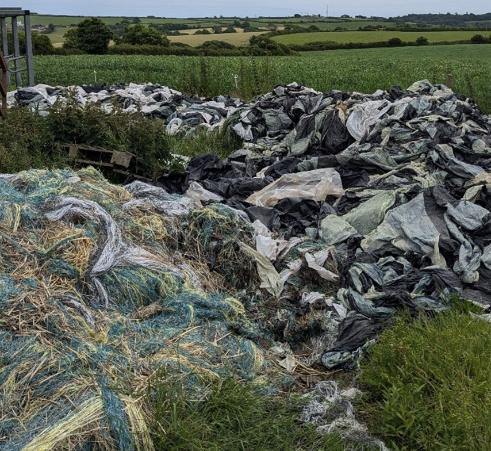



Anationwide consumer marketing campaign promoting a balanced diet that includeslean meat and dairy is set to return after its successful run in January. Launching on27 August and running until 30 September, The Agriculture and Horticulture Development Board's (AHDB's)Let's Eat Balancedcampaign, will champion the naturally delicious taste and flavours of British meat and dairy, highlighting their nutritional benefits, such as protein and vitamin B12 when consumed as part of a balanced diet. Vitamin B12 helps to reduce tiredness and fatigue.
The campaign will also promote the environmentally friendlier practices of some British farmers, showing their dedication to producing food of world-class standard. Current and upcomingLet's Eat Balancedcampaign activities feature collaborations with influential personalities including landowner, conservationist and author, Jake Fiennes. His videos discussing environmentally friendlier farming practices will be shared in October.
AHDB takes a science-based approach to communicate accurate and transparent information about the nutritional benefits of red meat and dairy.Let's Eat Balancedis proudly built on the foundation of theEat Well Guide, which encourages a varied, healthy and sustainable diet.
The previous burst of the campaign, in January 2024, positively shifted consumer perceptions on meat and dairy's nutritional benefits. With a six per cent and four per cent rise, respectively in consumers agreeing that meat and dairy are a natural source of vitamin B12 (February 2024 compared with August 2023, Source: TwoEarsOneMouth Campaign Evaluation).
In a further positive result, the Autumn 2023 and New Year 2024 campaigns reached47 million adults and generated94 million social media impressions. Seven out of ten consumers who saw theThis & ThatTV
advert said it provided them with new information about meat and dairy, which they felt empowered them to defend their dietary choices(Source: TwoEarsOneMouth Campaign Evaluation). One consumercommented that the advert is "very entertaining, motivating, and informative. I like that it is so upbeat and positive about meat and dairy."
People will see theThis & Thatadverts online on YouTube, broadcast streaming serviceslike ITVX, Channel 4, Sky Go, Disney+, and on social media — Facebook, Instagram, and Pinterest. Our partnership with Tasty UK to create 'Balanced Bites' videos will encourage the Gen Z (18-25 years) audience to create healthy dishes using British red meat and dairy. The campaign will feature in stores and online at five major retailers.
Carrie McDermid, AHDB Headof Domestic Marketing, said: "We are pleased that the JanuaryLet's Eat Balancedcampaign performed so well. It successfully highlighted the important roles our farmers play in providing high-quality produce and their dedication to environmentally friendlier practices. We are proud to be back championing British meat and dairy on behalf of our levy payers. This September campaign features a number of farmers on social media showcasing their resilience and tireless dedication to producing the food we eat."
Silas Hedley-Lawrence, a farmer from Oxford, said: "TheLet's Eat Balancedcampaign, funded by our levy, educates consumers about the importance of red meat and dairy in a balanced diet, using evidence-based research. It promotes our positive farming practices and showcases the high quality of British produce. It helps us tell our stories and reach more consumers.As a farmer, I am proud to play my part."
For more information about AHDB'sLet's Eat Balancedcampaign, and the vibrant'This & That'advertisements, please visitahdb.org. uk/letseatbalanced
gg producersand packerswill no longer need to change how eggs are labelled during an outbreak of avian influenza under measures announced today by the Government (27 August).
Currently, when mandatory housing measures are introduced to protect birds from the spread of disease, eggs from free-range birds can only continue to be labelled as ‘free-range’ for 16 weeks after the housing order has come into effect - the existing‘derogation’ period under the Egg Marketing Standards Regulations. After that period, these eggs must then be labelled as barn eggs.
In both 2021-22 and 2022-3,the 16-week derogation period was exceeded by six and seven weeks respectively, which led to significant costs for industry as egg packaging had to be changed to comply with legislation.
The amends to existing legislation, which will be introduced through a Statutory Instrument later this year, will mean that free-range eggs can continue to be labelled as such throughout mandatory housing measures.
The move will cut unnecessary red tape and costs for British producers while also strengthening supply chain and maintaining consumer confidence.

Daniel Zeichner,Minister for Food Security and Rural Affairs said
“We understand the pressures facing the egg producing sector and the crippling impact that avian influenza outbreaks can have on their businesses. Removing the need to change labels on eggs and packaging will help them keep costs down and remain competitive.
“This Government will restore stability and confidence in the sector introducing a new deal for farmers to boost rural economic growth and strengthen food security alongside nature’s recovery.”
The UK has self-declared freedom from HPAI for Great Britain with effect from 29 March 2024. There are currently no outbreaks of HPAI in poultry or other captive birds in the UK. However, HN51 continues to be found in wild birds in Great Britain and across Europe and keepers should remain vigilant and practice stringent biosecurity to protect the health and welfare of their birds.
The proposal to remove this derogation period for England and Scotland was supported by themajority of respondentsto an eight-week consultation undertaken earlier this year.
Ernest Doe & Sons Ltd is pleased to announce the successful acquisition of The Burdens Group Limited’s southern Lincolnshire branches, located in Sutterton and North Kyme. This acquisition was facilitated through the appointed administrators at Begbies Traynor (Central) LLP, following The Burdens Group's entry into administration.
Strategic Expansion: Ernest Doe & Sons Ltd, a family-owned business with a proud heritage dating back to 1898, is fully committed to extending its footprint into Lincolnshire. With existing branches across Essex, Suffolk, Norfolk, Cambridgeshire, Hertfordshire, Sussex, Surrey, and Kent, this expansion aligns with our commitment to delivering exceptional service and support to our growing customer base.
“We are thrilled to welcome the Sutterton and North Kyme branches into the Ernest Doe family,” said Managing Director Angus Doe. “Our focus is on maintaining the strong customer relationships cultivated by The Burdens Group, while introducing the high standards of quality and service that have defined Ernest Doe & Sons for over 125 years. We look forward to serving the local community and supporting our new customers with the expertise and dedication that our longstanding customers have come to rely on.”
Seamless Transition: Customers of the Sutterton and North Kyme branches will have the same points of contact, allowing a smooth transition. We will be working hard to invest in and improve the business and look forward to furthering our understanding of customers’ needs within the area.
Financial Enquiries: For any financial matters concerning The Burdens Group prior to the acquisition date, please contact the administrators’ office at Sheffield.north@btguk.com. All outstanding debts or creditor claims will be managed directly by Begbies Traynor, who will provide the necessary guidance.

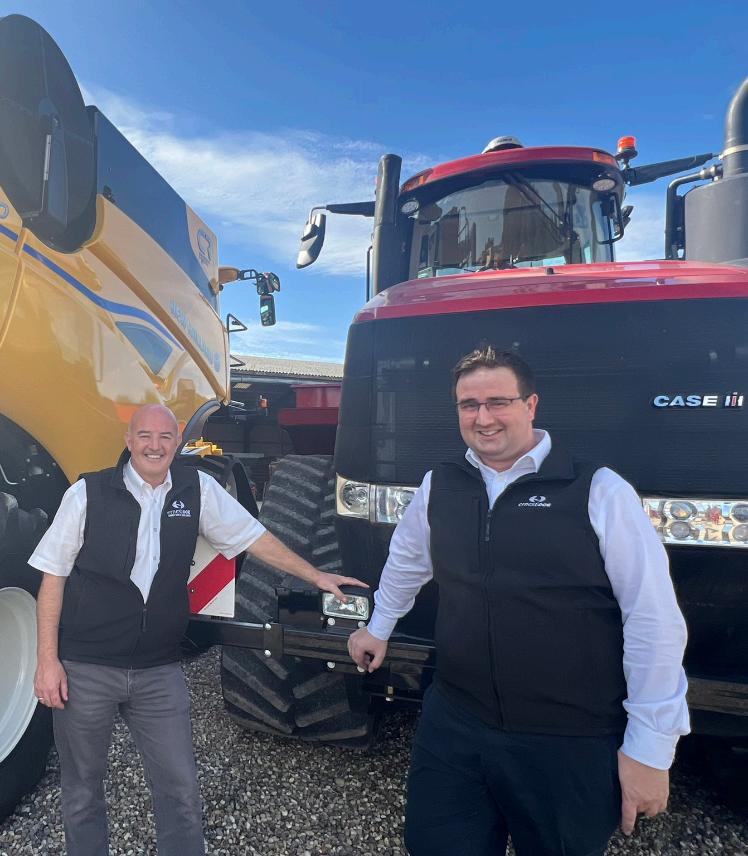
Afarmer-led cooperative has secured the funding needed to initiate trading opportunities for sustainably-minded farmers in North Lincolnshire, with the support of Lincolnshire and East Yorkshire's largest law firm,Wilkin Chapman.
The firm joins agricultural machinery supplierPeacock & Binningtonas the first sponsors of the Northern Lincolnshire Environmental Farmers Group (EFG), which aims to deliver positive environmental change, funded through natural capital trading.
The organisation aims to increase biodiversity in North Lincolnshire, improve water quality, achieve net carbon farming by 2040 and generate new trading opportunities for farmers.
The Northern Lincolnshire EFG is the 10th group of its kind to be established across the UK since 2020, with theEFG networknow comprising 433 farmers, covering around 3% of England's farmed area and a trading pipeline worth c. £10 million.
The Northern Lincolnshire group - which covers areas surrounding Grimsby, Scunthorpe, Immingham, Louth, Crowle and Epworth - has been set up by local farmers Andrew Jackson, from Pink Pig Farm, and William Sowerby, from Farming Forward. The group is now appealing for more members in the area.
Catherine Harris, head of the agriculture sector at Wilkin Chapman, said:
"When farmers work together, they can have a great deal of power. While there are groups that represent farming as a whole, the EFG is a rapidly growing voice for farmers who are particularly mindful of their sustainability, as well as their financial success.
"Farming plays a major role in the care of our ecosystem and I know environmental custodianship is very important to a great many farmers, so we hope that supporting the establishment and growth of this EFG will help farmers to work together to achieve this."
The first Environmental Farmers Group was officially launched in May 2022, after a group of farmers came together in the Avon area to build
on their local Farmer Clusters to strengthen their position to deliver environmental goods and services for fair reward.
It was convened by the Game & Wildlife Conservation Trust (GWCT), which founded the Farmer Cluster concept and whose scientific research is behind many of DEFRA's ELM scheme agri-environment options. Against a backdrop of the transition away from the Basic Payment Scheme (BPS), the group grew in numbers and expertise, eventually forming a cooperative two years later.
The EFG acts as a trusted navigator for farmers and landowners in industries that focus on natural assets such as soil, air, water, plants and animals (known as the 'natural capital sector'). Its goal is to use scale and member cooperation to secure the best environmental results and financial returns for a wide range of natural capital goods and services.
Members of the EFG get access to trading opportunities in natural capital markets, guidance on how to trade and benefit from farmer buying power in natural capital markets.
William Sowerby, from Northern Lincolnshire Environmental Farmers Group, said:
"Northern Lincolnshire was the first EFG group to be established outside the South of England. There was some early demand to replicate the EFG model in the area and so a steering group was pulled together to drive the model.
"The group has been sitting regularly since July 2023 and we have over 40 farmers expressing an interest so far. With its proximity to the industrial Humber bank, we see some key potential opportunities for EFG farmers to support growth in the area through cleaner water projects, as well as biodiversity and carbon mitigation for new industrial developments."
For more information about the Environmental Farmers Group, please visitwww. environmentalfarmersgroup.co.ukor emailw.sowerby@farming.co.uk
To learn more about Wilkin Chapman's agriculture sector, visitwilkinchapman.co.uk/ sectors/agricultureand to find out more about Peacock & Binnington, visitwww.peacock.co.uk
Local resident, former military armed forces and NHS paramedic Andrew Gibson, aged 58, is a man on a mission – to encourage the farming community to harvest their prostate health.
In April 2020, after experiencing 'twinges' for some time, Andrew collapsed while refereeing a rugby match. Shortly afterwards he was diagnosed with stage 4 prostate cancer and was given just two years to live.
Today, over four years later and having undergone extensive treatment including chemotherapy and precision radiotherapy, he knows he's on borrowed time. Yet rather than slowing down, Andrew has pledged to plough on and is set to embark on a 500-mile solo road trip by tractor to raise awareness around the importance of 'harvesting your prostate health' among the farming community and raising vital funds for Prostate Cancer UK in the process.
Andrew sets off from the Badminton Estate at 8am on 17thSeptember, on a journey through the English countryside arriving at Hoghton Tower, near his former Ambulance Station in Chorley, Lancashire. The following day he will drive the return leg, finishing at the Bristol GenesisCare outpatient cancer centre where he has been receiving treatment since his diagnosis.
Talking about his inspiration behind the tractor road trip Andrew says:"Research shows* people living in rural areas - and farmers in particular - are less likely to engage in preventative health measures, including cancer screenings. This is due to many reasons, but one key factor is that many farmers simply prioritise work over personal health."
"I took my health for granted. Even when I started to feel the odd twinge, stiffness and pain it was put down to leading a highly active lifestyle –something I now know was a big, missed opportunity, which has cost me dearly. I'm determined to spend the time I've got left to spread the word to the highly active farming community not to dismiss the aches and pains and to harvest your prostate health. Listen to your body, understand the signs and symptoms and stay vigilant. If my story can help others to recognise or question their own symptoms and get tested, then I'll be delighted.
"I've been a fit and active man all my life. I was a
non-professional rugby referee for 34 years and served in the military, but those days are behind me. When I decided I wanted to set myself a fundraising challenge I had to think outside the box. I can't run marathons or climb mountains anymore. But I do love a road trip and as a country boy at heart there's nothing more exciting to me than riding a tractor.
"TH WHITE has kindly loaned a Demonstrator T6/T7 tractor for my road trip and my friends and care team at GenesisCare have also donated their time and resources to help make this dream a reality – all with the intention of raising awareness of the disease and raising vital funds for Prostate Cancer UK.
At the end of Andrew's tractor road trip, staff at GenesisCare in Bristol, his friends and family will be waiting to give him a hero's welcome. Among them will be TV & radio broadcaster and former Rugby Union playerUgo Monye,who recently partnered with Andrew in another prostate cancer awareness campaign for GenesisCare called 'Know Your Roots'.
Monye, who sadly lost his father to prostate cancer in 2021 says:"Andrew's passion and commitment never ceases to amaze me. It was a true honour to work alongside him earlier this year and when I heard about his Harvest your Prostate Health campaign I had to come down and support him. What a pro.I really hope that if anyone is worried prostate cancer or wants to chat about their symptoms or treatment options, I urge them to contact their GP or visit the GenesisCare website."
To make a donation to Andrew Gibson's Just Giving page please visit:https://www.justgiving. com/page/harvest-your-prostatehealth?utm_ medium=fundraising&utm_ content=page%2Fharvest-yourprostatehealth&utm_source=copyLink&utm_ campaign=pfp-share
For more information about Andrew's Harvest your Prostate Health campaign and tractor road trip journey please visitwww.genesiscare.com/uk/ harvest-your-prostate-health
For more information on prostate cancer symptoms and treatment options visitwww.genesiscare.com/ uk/condition/cancer/prostate-cancer
NFU Education’s mission to deliver essential knowledge about food and farming to thousands of schoolchildren across the UK has received a significant boost, thanks to a generous £70,000 donation from the NFU Mutual Charitable Trust.
Under the expert guidance of former teachers, the NFU’s specialised education team runs a full range of packages for schools. These pioneering projects help teachers deliver curriculum-based learning objectives through the lens of farming. This new funding from rural insurer NFU Mutual will not only enhance existing programmes but will also enable NFU Education to grow and develop new materials and educational agricultural experiences for students.
The NFU currently offers a range of livestreamed lessons and webinars, as well as projects for the classroom which allows children to learn about food, business and

enterprise, and science, technology, engineering and maths (STEM) subjects. The innovative Farmers for Schools programme equips farmers and industry professionals to engage with secondary schools directly, debunking myths perpetuated on social media and providing authentic insights into the agricultural industry.
NFU Vice President Rachel Hallos said:“We’d like to thank the NFU Mutual Charitable Trust for their generous contribution to our education programme. This funding will go towards the fantastic projects that so many students across the country have taken advantage of, significantly supporting our standout programmes like STEMterprise and Farmers for Schools, as well as our highly acclaimed live lessons.
“Since their inception in 2022, our live lessons have reached over a million children. We have trained over 300 Farmers for Schools ambassadors who have brought their knowledge and passion to over 25,000 students across the country. Our STEMterprise teaching resources have also proven incredibly popular, with over 40,000 downloads in the last academic year alone. This financial boost will allow even more students to access vital knowledge about food, farming and nutrition through our STEM-based resources.
“Our mission is to make farming captivating and relatable for young people, so as they get older they can start to appreciate what the countryside and rural communities can offer.
“The vital work of NFU Education is instrumental in inspiring the next generation to understand and value the origins of their food, and the overwhelming success and popularity of our projects show the appetite to learn more.”
Jim McLaren MBE, NFU Mutual Chairman and Chair of the NFU Mutual Charitable Trust, said:“We are very proud to support the development of NFU Education through this donation. Helping young people to learn about farming is so important, and this is a fantastic initiative working closely with schools to deliver engaging and memorable lessons that complement the STEM curriculum.”
On the day the nationallarder would run empty if we only ate food produced in the UK from 1 January, the NFU is highlighting the importance of upholding and increasing the nation's selfsufficiency levels to help bolster food security, something the government has outlined as critical to our national infrastructure.
According to 2023 Defra figures, the UK is 62% selfsufficient in food. While this reflects similar levels of the past decade, some sectors have seen a recent decline. For example, the UK's self-sufficiency in fresh vegetables – key in supporting the health of our nation – is at its lowest since records began in 1988 at 53%.
This year, farmers and growers have also experienced one of the wettest winters and springs on record which has put untold pressure on food production and contributed to a collapse in farm business confidence3, causing a dramatic decline in the area planted of cereals for the 2024 harvest.
At the same time, record-breaking global temperatures have impacted key exporting countries across the world. Importsmake up 84% of fresh tomatoes on sale in the UK, yet tomato imports fromSpain and Morocco fell by 17% in February 2023 compared to the five-year average. In the same time period, imports of lettuce varieties fell by more than 36%5, contributing to shortages on shop shelves as UK production also fell.
With global and climaticinstability putting pressure on food systems all over the world,the NFU is looking to work with the new government to put domestic food production at the centre of its missions around climate resilience, economic growth and the nation's health.
NFU President Tom Bradshaw said: "Food from other countries will always form a proportion of our daily diets, but we must recognise the vulnerability of global food supply chains and the importance of a stable food supply here at home to our nation's health, as well as its vital contribution to our economy. Farmers produce the raw ingredients that underpin our food and drink sector, the largest manufacturing sector in the UK, worth £146 billion and employing more than four million people.
"That is why investment in Britain's farming sector is so important, so where we can increase selfsufficiency in homegrown foods, we do.
"Think about the impact of the climate crisis right across the world. Blistering temperatures have caused issues with harvests across Europe, while here in the UK many farms spent the first few months of this year under water. At the same time, our farmers continue to face significant reductions in direct farm support payments and unsustainably high production costs due to the war in Ukraine.
"All of this chips away at business confidence and farmers' ability to do what they do best – produce high quality, nutritious food for the nation. And with nearly a fifth of UK households reporting experiences of moderate or severe food insecurity in January 20237,
we can't afford to let this trend take hold.
"That's why we welcome the government's recognition that food security is critical to national security. If we are to maintain, and where possible grow, our selfsufficiency in the face of global instability, food producing businesses need the right policy framework and investment to boost confidence and resilience so we can withstand climate and economic shocks.
"Central to this is an increased multi-year agriculture budget and a statutory commitmentto ensure the UK's self-sufficiency does not drop below its current level.
"On this Self-sufficiency Day, we want to highlight the importanceof boosting Britain's ability to produce its own food so families across the country continue to have access to healthy, balanced and affordable meals – something we all have a right to."
On Self-sufficiency Day, the NFU is highlighting multiple ways the new government can help ensure self-sufficiency doesn't drop in the future:
• An increased multi-year agriculture budget for theduration of this Parliament, as was the case in the previous Parliament.
• Ensure all new policies and regulations that impact agricultural and horticultural businesses undergo a food security impact assessment.
• Introducea statutory commitmentto ensure the UK's self-sufficiency does not drop below its current level.
• Ensure food imports are produced to the same standards as those that British farmers are required to meet by introducing a system of core standards for animal welfare and environmental impact.
• A seamless transition to new environmental schemes that are open to all farmers and growers.
• Deliver manifesto commitment of introducing a target for half of all food purchased across the public sector to be locally produced or certified to higher environmental standards.
• Update the National Planning Policy Framework (NPPF) to include a weighted argument in favour of food production, with the benefits of farming clearly recognised by the planning system to support food production across England.
• Supporting growth in the UK horticulture sector as outlined in the NFU'sHorticulture Strategy, developing policies around access to labour, crop protection, water, planning, and affordable and sustainable energy supply.

The NFU Mutual Charitable Trust has announced its first round of donations for 2024, totalling more than £500,000 and giving support to11 rural causes across the UK.
This is the first of two rounds of funding which will be delivered across the year. The Trust expects overall donations to reach at least £1m by the end of 2024.
• Gareth Raw Rees Memorial Scholarship
• NFU Education
• Nuffield Farming Scholarships Trust
• Oxford Farming Conference
• Royal Countryside Fund
• RSABI
• Samaritans
• Wales Federation of Young Farmers Clubs
The donations will be available immediately, allowing the organisations to continue to provide their crucial support services.

The NFU Mutual Charitable Trust is one of the main ways the UK's leading rural insurer NFU Mutual provides charitable donations. Its work forms part of NFU Mutual's £3.25m charitable giving pledge to support its members and their communities during 2024.
This latest round of funding will help to deliver a range of initiatives, including rural poverty relief, helping small farming businesses to thrive, educating and mentoring young people, and supporting mental wellbeing.
The organisations set to benefit from the donations are:
• Addington Fund
• Farms for City Children
• The FCN
Applications for the NFU Mutual Charitable Trust's November round of donations are now open, and the closing date is 4thOctober. Full details can be found on NFU Mutual's website.
Jim McLaren MBE, Chairman of NFU Mutual and the NFU Mutual Charitable Trust,said:"NFU Mutual is committed to making a positive impact for our members and wider society through our charitable giving programme. We are very proud to be championing the work of these great causes through the NFU Mutual Charitable Trust."
The Royal Countryside Fund, a charity which empowers family farms and rural communities to survive and thrive, will be using their donation of £75,000 to aid their work with Farm Support Groups across the UK.
Keith Halstead, Executive Director at The Royal Countryside Fund, explained how the Trust's donation will be making a difference:"This incredibly generous grant from the NFU Mutual Charitable Trust will help The Royal Countryside Fund improve the lives of thousands of farmers across the UK, who are supported by our Farm Support Group network. We will be able to increase the capacity of groups within the network to deliver more vital services and support to those in need. We would like to say a huge thank you to the NFU Mutual Charitable Trust for helping us provide this crucial support that so many within farming communities depend on."
Roger Kerr, CEO of OF&G (Organic Farmers’ and Growers), has announced his resignation after a 10year tenure leading the UK organic certification body.

Chairman of OF&G’s Board, Richard Thompson, expresses his thanks for Mr Kerr’s commitment to the organic sector and recognises his impact and influence.
“Roger has been instrumental in OF&G’s growth in stature and recognition as the organic certifier responsible for certifying over half of the UK’s overall organic land area,” he says.
“He has remained true to organic’s core principles, delivering high quality certification services while championing the sector and taking a pragmatic approach to protecting the interests of the organic
AHDB is disappointed that despite speaking to the programme makers to share concerns about a number of inaccuracies in the preview version we had seen, Friday's documentary was still missing key evidence that would have helped to inform viewers on the facts about bovine TB.
This week we went to some effort to highlight to the BBC the importance of including peer reviewed evidence about how the disease is spread, the positive impact of badger culling on TB in cattle herds and the effectiveness of the current 25-year eradication strategy. This was not reflected in the final edit.
Bovine TB is a complex disease, and we were pleased to see the programme highlight its impact on the mental wellbeing of farmers, as well as the devastating effect it has on animals.
We will now take some time to further reflect on the programme before considering further action.
farming community.
“As a highly respected figure within the wider agricultural industry, I’d personally like to express my gratitude for Roger’s hard work, leadership and accomplishments,” adds Mr Thompson.
Mr Kerr is committed to ensuring a smooth transition and will remain in post until a successor is appointed.
He says; “I’m incredibly proud of what OF&G and all that the team has achieved, but now is the time for me to explore other personal business and consultancy opportunities. I am also looking forward to finding more time to spend with my family and grandchildren”.
“I would like to extend my thanks to my exceptional team and to the OF&G Board for their guidance and support.”
The Board is now seeking to appoint a successor.
NFU Deputy President David Exwood has met Minister for Food Security and Rural Affairs Daniel Zeichner and Farming and Countryside Director Janet Hughes in the uplands to highlight the approach needed to ensure the Environmental Land Management schemes (ELMs) succeed in the hills. They also discussed Defra’s vision for the future of the uplands.
The meeting, which took place on NFU member Helen Drinkall’s farm, gave the Defra team the opportunity to see the realities of farming in the uplands and the current barriers of the Sustainable Farming Incentive (SFI) for upland businesses.
NFU Deputy President David Exwood said:“It was a great opportunity to have the Minister and Defra Director out on farm in Lancashire. They saw for themselves the vital role upland farmers play in producing food while also being stewards of some of the country’s most cherished landscapes.
“For ELMs to be a success it has got to work for all farm businesses, including those in the uplands. While NFU campaigning has led to positive increases in the number of options available for upland farmers under SFI, there still remains challenges about how hill farming businesses will be profitable while working to the income forgone model.
“We need to give upland farmers confidence and certainty by seeing a clear strategy from Defra on its vision for the future of the uplands. The creation of an uplands working group is also key to ensuring upland businesses are part of the solution to Defra’s environmental ambitions.”
Expert advice on the changes to farm payments is available to farmers looking to adopt naturefriendly practices infree events and webinarsnext month.
The Future Farm Resilience programme sessions, funded by Defra, will be run by Soil Association farming advisors who will provide business planning advice to help farms adapt to new farm support polices.
funding, but they can also offer a wide range of cost-savings and provide resilience for farmers in the face of a changing climate.
"We are really pleased to be offering free support for farmers to explore not only the available funding opportunities, but also where they may be able to tweak their farming practices to benefit both nature and their bottom line.
"Farmers are facing lots of uncertainty with considerable change taking place, so we are glad to be able to help them navigate the policy changes and opportunities over the next few years.

They will offering information and tailored advice around new options in the Environmental Land Management Scheme, Sustainable Farming Incentives and Countryside Stewardship.
Any farmer can get involved, but there will be a particular focus on how organic and low input farmers can secure government incentives and cost-savings through nature-friendly farming.
Soil Association Senior Farming Advisor Jerry Alford said: "Nature-friendly farming practices are not only set to receive ongoing government
"Every farm is different and, as expert advisors working across all types of farming systems, the Soil Association farming team is ideally placed to offer advice that is tailored to each farm's individual circumstances."
An arable workshop is being held from 10.30am –3pm on Thursday 12 September at Bradwell Grove Farm, near Burford in Oxfordshire.
Hedges and trees will then be the focus of a session in Dorset from 10.30am – 3pm on Thursday 25 September at Wilkswood Farm.
Online webinars will also take place across September and a livestock event is being organised for October.
For more information and to book, visitwww. soilassociation.org/farmers-growers/farmingeventsor email ffr@soilassociation.org.
Peoplesafe, the UK’s leading employee safety solutions provider, has announced a partnership with the National Farmers Union (NFU), offering exclusive discounts and safety support for its members. It is hoped that the partnership will help safeguard the workers in this sector at a time when HSE (Health and Safety Executive) work-related fatality figures for 2023/24 reveal agriculture to have the poorest safety record of any occupation in the country.
• Agriculture had the worst rate of fatal injuries - 21 times higher than the all-industries average
• Despite accounting for only 1% of the working population, agriculture accounted for 20% of all deaths in the workplace
• The second most dangerous profession was construction, with a rate five times the average
• 27 people working in agriculture lost their lives in the year to March 2024 in England, Wales and Scotland
As well as offering peace of mind to NFU members working alone or in hazardous situations, Peoplesafe technology instantly connects to its dedicated Alarm Receiving Centre (ARC) in the event of an emergency,
where BS 8484:2022 certification provides Peoplesafe subscribers with the highest level of police response via our Unique Reference Number (URN).
The ARC holds a full list of URNs for all UK police forces, providing direct access to police control rooms, without the need for a 999 call. This guarantees the fastest possible response in an emergency.
NFU Deputy President, David Exwood, says:“Our farmers often work in isolated and challenging environments where safety is paramount. This partnership with Peoplesafe provides NFU members with access to cutting-edge safety devices at discounted rates, ensuring that our community can carry out essential work with greater peace of mind. We are committed to supporting our members with practical solutions that make a real difference to their day-to-day lives."
Naz Dossa, CEO at Peoplesafe comments:“Workplace safety is a right, not a privilege, and we hope our partnership with the National Farmers Union will help put an end to the disproportionate number of fatalities in the agricultural sector. Peoplesafe are committed to offering a low-cost solution, helping lone workers are protected in their place of work.”
Newly elected MPs are being given a unique opportunity by the NFU to champion British food and farming in their constituencies and in Westminster.
The NFU's new Food and Farming Fellowship Scheme, in partnership with sponsoring organisations ABP UK, Agricultural Industries Confederation (AIC), Arla Foods, Barfoots, British Egg Industry Council (BEIC) and Fareshare, will showcase the industry and enable participating MPs to see firsthand how sustainable and affordable food gets from field to fork.
The year-long itinerary will cover different farming sectors and concludes with a graduation dinner in Westminster where each MP will be recognised for their work in building up an understanding and knowledge of the UK food and farming industry. NFU President Tom Bradshaw said: "The NFU engages with all political parties to ensure they understand the importance of boosting home-grown food production as well as the work farmers and
growers carry out caring for the environment, providing a home for nature and finding solutions to the challenges of climate change.
"Our Food and Farming Fellowship Scheme is an extension of that campaigning work and has been designed to create a new group of champion MPs who will speak up in their constituencies but also in Westminster on some of the big issues impacting an industry which forms the backbone of the UK's largest manufacturing sector – food and drink – contributing more than £146 billion to the economy.
"Along with all our sponsor partners, we will provide those MPs with the tools, knowledge and understanding they need to be able to highlight the critical role of food security in delivering national security and the growth and investment required for the future of British farming, so our farmers and growers can continue producing safe, sustainable and affordable homegrown food alongside caring for the environment."
Apopular ice cream farm in Cheshire is set to introduce more flavours to its menu thanks to a selection of fruit and nut trees that have been planted on their farm this year as part of a wider agroforestry project.
Snugburys, a family run ice cream parlour based near Nantwich, operates alongside the organic grass farm business. The owners were keen to introduce more trees to the farm and worked closely with local farm advisors, ELM Associates to design a tree planting scheme that would benefit both businesses. Using funding through The Mersey Forest's Trees for Climate programme they've planted
over 2,300 trees on their 45ha farm.
Cheryl Sadler, from Snugburys, first learnt about agroforestry from a project in the Amazon. After visiting a farm in Wem and a two-day visit to the Agroforestry show last year, she decided it was something she'd like to introduce on her family farm.
The walnut and hazelnut trees have been planted in rows spaced 36 meters apart, with grassland in between, which is a herbal ley, so that machinery can get around the trees to silage this several times over the summer months. Some of the fruit trees that have been planted include damson, pear and greengage.
Additional trees have also been planted around the edges of the fields and will help with biodiversity, attracting more birds, insects and other wildlife to the site.
Cheryl explained: "Trying to farm using nature seems like a better way forward. The benefits seem so logical, you are helping the wildlife, helping the soil structure and it just seems a sustainable model to follow."
Paul Nolan, Director of The Mersey Forest, said: "We can fund up to 100% of tree planting costs, plus 15 years maintenance payments. Our experienced woodland advisors can provide landowners with as much support as they need throughout the planning,
Pictures by Mandy Jones

funding and planting process."
Jane Atkinson, Farm Conservation Advisor at ELM Associates, said: "We find it really easy to work with the Mersey Forest and the Trees for Climate project. It takes away a lot of the hassle for the landowner because we can put together the scheme, get all the right permissions and consents in place, and help both with the design and with planting. Working with the Mersey Forest has really enabled schemes such as this to get off the ground."
The Mersey Forest's Trees for Climate programme, which funded the project, is part of the Department for Environment, Food and Rural Affairs' (DEFRA's) Nature for Climate Fund.
Landowners who are interested in transforming their land with trees, whether they have a small pocket of unused land or several hectares of farmland where they'd like to incorporate trees, are encouraged to get in touch with The Mersey Forest ahead of the planting season (October to March).
Visit:merseyforest.org.uk/planttreesfor more information and to complete an enquiry form or call: 01925 816217


Ateam of conservation officers and volunteers in Dorset has been given the go ahead to plant native wildflowers and meadow grasses, which will enhance floodplain fields for biodiversity.
The project is taking place at Bere Marsh Farm, Shillingstone, which is owned by the Countryside Regeneration Trust, a charity promoting nature-friendly farming to help reverse the biodiversity decline and combat climate change.
The team has already reseeded a total area of 1 hectare with brush-harvested seed from floodplain meadows managed by Wiltshire Wildlife Trust. The plan is to increase coverage over the rest of the floodplain fields at Bere Marsh in future years (a total of 13.5ha).
CRT Head of Conservation and Land Management Helena Darragh explains why the project is so important.
“Species-rich floodplain meadow habitat in
Britain has dramatically declined due to agricultural intensification, urban and industrial development of these flat, lowlying, and fertile areas, as well as alterations to their hydrology through changes to river systems.
“Due to their proximity to watercourses, species-rich floodplain meadows were once the most productive fields on farms, receiving their nutrients each year through highly fertile silt deposited on the land during flood events.
“This special value has decreased with fertiliser now used more widely across farm holdings and high yielding grasses selected to grow hay or silage adding to the overall loss of this biodiverse habitat.”
Floodplain meadows are characterised by diverse herb-rich swards and feature the iconic great burnet (Sanguisorba officinalis) plant with its crinkle-cut leaves, producing beautiful burgundy seed heads in summer.
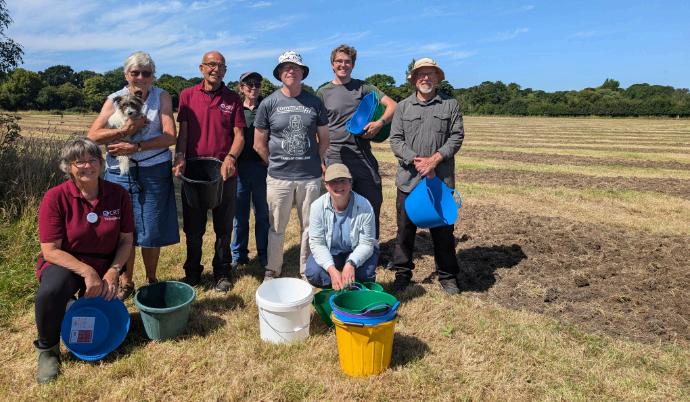


Other wildflowers include common sorrel (Rumex acetosa) and meadow vetchling (Lathyrus pratensis).
“These magnificent lowland habitats contribute to nature-friendly farm practices through providing a valuable nutritious source of food for livestock,” adds Helena. “A hay cut is taken in summer, followed by the grazing of regrowth in autumn, until it becomes too wet for livestock to be on the field.”
During winter and spring months, floodplain meadows are often inundated with floodwater, providing nesting and feeding habitat for a huge array of birdlife. As the ground becomes drier, livestock can be let on to graze the early grass growth, before being shut out to allow wildflowers to come through and produce an herb-rich hay crop, and so the cycle comes full circle.
Native wildflower seeds need contact with bare soil to germinate so machinery is used to scratch the top surface of vegetation away to create perfect conditions for sowing.
“So, while it may not look much at first, keep an eye out in the spring and summer next year for a boost in wildflower abundance on these fields, providing pollen and nectar for a range of pollinators,” adds Helena.
Across its properties in England, the CRT is committed to enhancing our farmed

environment for biodiversity through conservation projects which restore natural habitat as part of our nature-friendly farm practices.
“Over the coming years at Bere Marsh Farm, we will be working to restore the botanical diversity of our floodplain meadows, adding locally sourced native wildflower seed to the existing grassland. “Not only is this great news for birds, mammals, pollinators and other invertebrates, but diverse swards in floodplains help to sequester carbon deep into the soil and improve soil moisture retention since having lots of different plants means a range of rooting depths and systems, all working to pull carbon and water down into the soil to support growth.
“With the UK now subject to more short, sharp downpours in winter months (and throughout the year) ensuring our floodplains function more effectively by storing water helps to alleviate flooding downstream and reduce soil erosion, providing benefits to local communities.”
“We’re really looking forward to seeing our meadows flourish, providing for more pollinators and having positive ramifications all the way up the food chain.” she adds. For more information about the project and the CRT, please see the website atwww. thecrt.co.ukor to make a donation to the charity, please see www.thecrt.co.uk/ donate/donate/25/credit-card
On the 19/20/21st September APF 2024, the UK’s largest and most exciting Trees & Timber Show comes to Ragley Estate, Alcester. 300 Exhibitors and 25000 visitors will be welcomed to this biannual event, back at Ragley Estate for the seventh time.
There is an outstanding, unique and exciting array of top class competitions to watch including:
The Husqvarna World 25m Poleclimbing Championships, the A W Jenkinson and Tilhill European Chainsaw Carving Championships, the British Open Fencing competitions for speed fencing and traditional fencing, the Richard Court Forestry Engineering and Coombes Forestry UK Forwarder Driving championships, the Pfanner and Teufelberger UK Team Tree Climbing Challenge, the British Open Lumberjack Championships and the famous World Log To Leg pole lathe turning championships.
Entries are now open for the APF UK Team Climbing Challenge, the World poleclimbing championships and the UK Forwarder Driving championships.
The event offers a host of great spectator and have-a-go opportunities. Visitors will be able to test their head for heights and have a birds-eye view of the showground in the have-a-go tree climbing area, try their hand at axe throwing, basket weaving or rake making and take control of a huge timber horse. They can test their skill with a chainsaw in total safety on the very latest Husqvarna VR chainsaw simulator.
The woodland crafts area has 30 craftspeople demonstrating a huge array of traditional skills. Clogs to coracles, charcoal burning to rake making, four different types of basket weaving, wheelwrighting to willow weaving, dug out canoes to chair making. Try your hand at pole lathe turning. If you want to know what a Sussex Pimp is visit the crafts area!
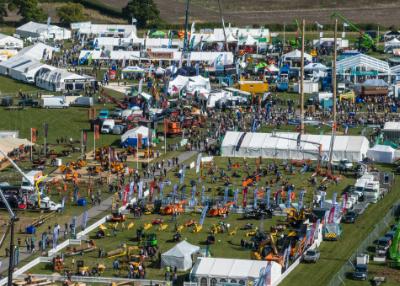
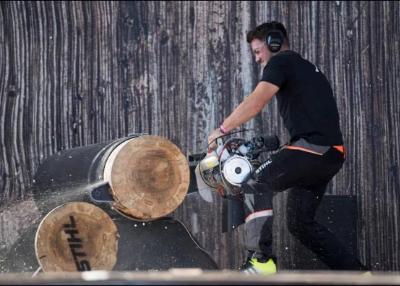

s she enters her final term as a Director of the Oxford Farming Conference (OFC) fruit and hop grower Ali Capper says nostalgia about agriculture needs to be left at the farm gate and replaced with a more businesslike mindset.
She has also broadly welcomed the new Government, saying Sir Keir Starmer’s cabinet seems to offer “good potential” for investing in growth and showing a “more common sense” outlook towards seasonal workers, proven to be vital for the UK’s harvest, especially in the fruit and vegetable sector.
The Migration Advisory Committee - independent advisers to the Government on immigration mattershas echoed years of industry lobbying on the importance of the Seasonal Workers Scheme (SWS) and its recently released review report calls for more certainty and clarification on visa numbers, echoing the National Farmers’ Union’s call for a rolling five-year programme.
“A move away from a hard right immigration policy is very welcome,” explained Ms Capper. “This new Government’s outlook towards seasonal labour seems much more common sense. The bottom line is we can’t pick fruit and vegetables without hands and anything that makes getting those workers out in the field must be good news.”
Generations of Secretaries of States and Shadow Ministers have seen the OFC as a must-attend platform to address the agricultural industry. Defra Secretary Steve Reed already has one under his belt, visiting in January while still in opposition.
In a similar vein to her comments on seasonal labour, Ms Capper - who is a director of her family’s fruit and hop farm in Worcestershire as well as being an NFU Mutual Board member and chair of British Apples and Pears - will be pushing for the new administration to “sort borders out” as well as “the UK’s relationship with the EU.”
“The border operating models we have at the moment are not working and it needs sorting out to encourage growth in trade,” she says. Britain is currently only 40% self-sufficient in apple and pear production.
“There is no reason that with the right investment from our new Government - be that through grants, tax incentives, accessibility to labour and research and innovation investment - that this couldn’t rise to 60% or 70% or even double to 80%. We just need that investment in growth.”
Ms Capper first attended the Oxford Farming Conference - which next takes place between January 8th to 10th 2025 - when she was invited to speak in 2017.
“I just turned up and hadn’t given it much thought to be honest,” she recalls. “I had no idea of the scale of the event and became a fan. The 2025 conference will be the last in my term as a director and, for me, this is one of the best things about the whole event. Every year there are three new Directors and three stepping aside which means the conference never gets stale, it’s always inspiring. Whatever changes come and go OFC always gives people the opportunity to have a voice and ask questions, which is vital.”
On the subject of the farming industry’s voice Ms Capper is adamant that if British agriculture is serious about securing investment it needs to present itself in a more businesslike fashion.
“My sector of farming has been largely unsubsidised through the Basic Payment Scheme (BPS) and has had to plough its own furrow through challenges such as covid and the recent unprecedented inflation. Profit is not a dirty word, and this is something that government needs to recognise across all farming sectors. The bottom line is if you are not making a profit, you can’t reinvest in growing your business.
“Farming is rightly proud of its history and heritage but to remain viable it needs to take its rose-tinted spectacles off about the past and focus on the future.”
OFC Chair, Geoff Sansome, said “it will be interesting” to see which of Ms Capper’s asks are acted upon, adding that he will be keenly watching what the new Labour administration’s Cabinet Secretary achieves in his first 100 days in office.
“Steve Reed spoke back in January at OFC 2024 and said that ‘food security is national security’ and has also recently committed to continuing with Environmental Land Management incentives.
Geoff adds “there is a more nuanced debate to be had about food security, where in many sectors we are well supplied, compared to other sectors such as fruit and vegetables where there is an opportunity to improve. It’s not as simple as increasing self-sufficiency across the board. We have many competing government priorities for land use; food production, energy and housing being the major ones. We need a government that will back our farmers, provide a framework to inform those competing demands for land use, but not back track from the environmental incentives that will help deliver for biodiversity, clean air and water which underpin food production and deliver for climate change.
“The OFC is one of those rare places where Ministers can be held to account for their promises within an audience that is leading the sector, a network of influential people that will keep asking for change if they don’t see it forthcoming. The conference delegates really do represent the ‘who’s who’ in British agriculture, which is why Ministers, and their shadows always welcome the chance to address our event.”
Telecommunications operators have been told they must increase the rent they pay landowners for rural mast agreements by more than 130%.
The Upper Tribunal (Lands Chamber)* has ruled in favour of increasing the standard rental value of an "unexceptional" rural greenfield mast site from £750 per annum to £1,750, in a decision published late July.
Many landowners felt the previous reform of the Electronic Communications Code in 2017 was too heavily weighted in favour of telecoms operators who argued changes were needed for them to continue to invest in the improvement of the UK's digital infrastructure.
The trial related to the renewal of a lease of a greenfield rural mast site at Vache Farm near Chalfont St Giles in Buckinghamshire.
Operators EE and Hutchison 3G are the tenants at the site, with AP Wireless II (UK) their immediate landlord.
Paul Williams, Head of Telecoms at Carter Jonas, was appointed as the expert valuation witness for AP Wireless, and gave evidence to the tribunal.
He said: "This outcome moves the dial from the decision that was handed down by the Upper Tribunal in a case known as Dale Park in December 2020. That, and a subsequent decision in 2022 (Pendown Farm) suggested that a rental value of £750 was appropriate for what were considered to be "unexceptional" rural telecoms sites.
"Since the Dale Park decision, £750 per annum had been presented by telecoms operators to landowners as a fait accompli.
"If landowners objected, or challenged that figure, their only recourse was via tribunal at great risk and expense.
"Not only did the tribunal agree that the Dale Park decision needed to be looked at again, but it also informed us that the door isn't shut if new evidence which does not offend the statutory basis of value for telecoms emerges. Aside from market evidence, the tribunal also sent a clear message that inflation should apply, including to those for other site types, such as rooftops."
Given that some of those other decisions also date back four years, and inflation has been high during the subsequent period, increases across all site types will be significant, and welcomed by site providers.
"This will make a huge difference to many landowners who host telecoms sites, especially in rural settings, where the tribunal was persuaded that a greater-than-inflation increase should apply," Mr Williams said.
"This isn't about extracting huge amounts of money from the operators; it's about receiving a payment that is reasonable for the rights that are being granted, and the burdens that inevitably come with hosting telecoms, rather than a less intrusive tenant, or more passive use."

Before the reform of the Electronic Communications Code in 2017, landowners with a mobile telecoms site could expect to receive a rent of between £5-7,000 per annum.
"This was a really significant form of income for many small farmers," Paul explains.
However, back in 2011, the Government asked the Law Commission to review the Code and provide recommendations for reform. The Commission published its report in 2013, and subsequently the government began consultation on a new draft Code.
Operator lobbying persuaded the government to abandon the continuation of a market value approach recommended by the Commission, in favour of a 'no scheme' type approach, similar to other utilities. The revised Code was brought in under the Digital Economy Act 2017.
The initial approach to value by operators was extreme, with as little as tens of pounds being offered for a term of 10 or 15 years.
Understandably, existing and new landlords of telecoms sites were shocked and withdrew from the market, and operators were forced for the first time to litigate to argue their case on value.
Dale Park was one of the earliest cases dealing with valuation of ground-based rural sites, and the tribunal ruled that £750 per annum was an appropriate value for what it later called an "unexceptional" site.
"Since that ruling, both the opening and final offer from operators for most sites has been £750 per annum, irrespective of whether there were particular features which indicated a higher value," Paul explains.
Even when landowners thought this amount was unfair, most didn't have the funds necessary to fight against it in court.
"Sometimes operators would offer a goodwill oneoff payment, while negotiating a contract, but they would remain adamant about the actual rental value of the land being £750."
The Vache Farm case, which relates to the renewal of a lease of a greenfield rural mast site, saw the Upper Tribunal (Lands Chamber) deliver a significant decision on rental value, ruling that the appropriate annual consideration for a rural mast site should be set at £1,750.

"In this case, AP Wireless was the landowner and they argued that not only was the Dale Park figure of £750 too low, but there has also been high inflation over the subsequent years," Paul explains. "So, even if the approach and value in Dale Park was correct, it should still be adjusted for inflation as a minimum."
A key consideration was how much landowners could be expected to receive if the land in question was used for something else.
"The tribunal adopted the evidence I put forward for other non-telecoms rural compounds, along with the reality that there is a level below which willing and prudent landowners will not go below and awarded £1,750, which will now effectively become the new starting point for rural sites," Paul says.
"We're only dealing with relatively small sums of money, but if you imagine that this will apply to tens of thousands of sites across theUK, it's a significant outcome, which along with a general presumption that inflation on other decisions apply, will hopefully encourage a more equitable approach, and engagement from both sides in the transaction."
Derbyshire broiler unit has been launched for sale by Carter Jonas –the third sizeable farm of its type to be sold in the past 12 months.
Dovelowe Farm in Ashbourne is an award-winning poultry unit capable of housing up to 84,000 birds, with a guide price of £1.1m.
“With people travelling across the country for viewings, we expect interest in Dovelowe Farm to be high,” says Edward Beale, Associate Partner at Carter Jonas.
“Feedback so far has been that it’s in great condition for its age. The unit comprises four poultry growing sheds along with ancillary buildings for water, power generation and staff welfare facilities.
“All poultry rearing equipment along with the biomass boilers will be made available to the purchaser.”
In addition to the productive poultry unit, the site also includes a bungalow and two biomass
boilers. In total, the site is about three acres. The boilers provide heat for the poultry sheds, generating around £50,000 per year in RHI. There is also the possibility of purchasing two further biomass boilers by separate negotiation.
Jack Mitchell, Carter Jonas partner in Somerset, marketed poultry business Millford Farm and Knaplock Poultry Farm earlier this year, for a combined guide price of £5m.
“The main reasons potential purchasers gave us for viewing the units included confidence in the sector and strong profitability compared to other forms of agricultural enterprise,” Mr Mitchell explains.
Sam Johnson, Carter Jonas partner in Harrogate, marketed Willow Wood earlier this year. The substantial broiler unit is capable of housing 500,000 birds and had a guide price of £6.25m.
“Willow Wood represented a rare opportunity to purchase a high quality unit of significant scale (260,000 ft2),” he says.

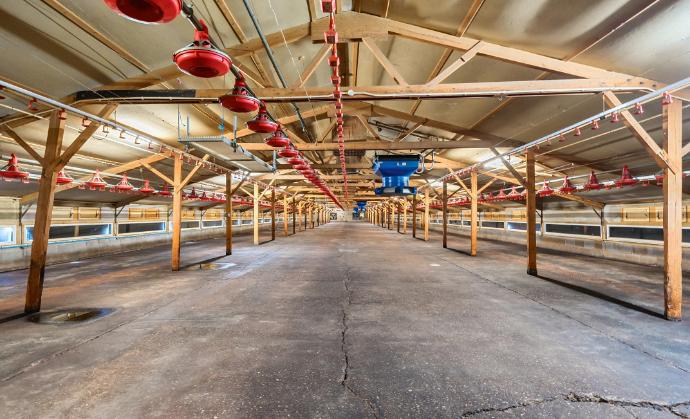
“A main driver for the interest we received was the importance of chicken as a protein –consumption has increased and therefore more space is needed to produce them.
“In addition to that, welfare standards are increasing – most major supermarkets, including Co-Op and Morrisons, have recently reduced required stocking density to 30kg/m2 and as such there is a major clamber by processors to secure more space.
“However, tougher planning legislation makes it very difficult to build new sites and it is certainly more costly. As such, growers are looking to purchase existing units and refurbish them.”
Securing environmental permits for poultry housing is also increasingly difficult, with increasingly strict pollution prevention measures making the creation of new sites problematic. To view Dovelowe Farm contact Carter Jonas on 0121 306 0386.


credit: Stuart Oates
Farmers are looking to turn back the clock on microplastic pollution by wrapping hay bales in biodegradable twine instead of "nightmare" single-use plastics, in a new field lab withInnovative Farmers.
Plastic net wrap is used on farms across the UK but it sheds microplastics that pollute water and soil and end up getting eaten by farm animals.
This is a major environmental issue, with the UK producing an estimated135,000 tonnesof agricultural plastic waste annually. It is also a major health issue with researchers increasingly finding microplastics in our food and bodies.
To help tackle this, farmers from 12 sites across Scotland, Wales and England are wrapping bales using twine from sisal, a cactus-like plant that was widely used before plastic became popular.
Field lab coordinator Stuart Oates farms cattle on Rosuick Organic Farm on Cornwall's Lizard peninsula. Experimenting with sisal, he aims to remove all plastics from his farm, and eventually replace fossil fuels entirely.
He said: "Plastic net wrap is a nightmare material. It's almost impossible to cut off without small pieces falling into the hay, which then spread into the environment and get eaten by our animals.
"This can build up quickly as we process thousands of bales a year.
"The effects of ingesting microplastics on animal and human health is only now starting to be understood, and none of it is good."
Sisal requires few chemical inputs to grow, is easy to use in existing farm equipment and contains no toxic microplastics so can be safely composted.
The one-year trial will compare 5,000 bales, half using sisal twine and half in plastic net wrap, stored in barn conditions ranging from dry to exposed.
The bales will be lab-assessed next year in March and November for protein and sugar content, and to compare the dryness of the material under different conditions.
It is hoped sisal will keep the bales secure and dry, giving farmers a nature-friendly alternative that saves on vet bills and plastic tax.
Oates added: "Our early experiments have shown that sisal is incredibly strong and quick to process, so it's a win for us and the environment.
"Small steps can lead to huge change – we want to see if this can be applied on a larger scale, so we're encouraging farmers to join the trial and see how sisal can work for them."
Farm plastic is often burned, buried or sent to landfill once used – causing further harm to the environment.
The farmers are now planning how to scale up production, working with contractors to discuss costs.
If the advantages turn out to be significant, it could benefit all UK livestock farmers.
Field lab researcher Conor Kendrew of the Cornwall Wildlife Trust said: "A successful trial means a strong business case for sisal.
"From there we can look at establishing economies of scale, cutting farm costs.
"If you're a farmer using sisal, your research will support other farmers, helping re-build an industry around environmentally sound practices."
Innovative Farmers Coordinator Laura Gudesaid: "We're excited to see farmers take the lead on this research.
"Plastic alternatives like sisal are not widely known – this could be a huge opportunity for livestock farmers.
"We hope this inspires others to try these naturefriendly methods, and would encourage any interested parties to follow the trial."
All results from the field lab will be made available open source. To join the trial and for updates, visit theInnovative Farmers website.

ADAMA Agricultural Solutions UK Ltd. has appointed Gus Merrick as a key account manager within the company’s commercial team.
Gus, who is FACTS and BASIS qualified and has a first-class honours degree in agribusiness from Harper Adams University, joins ADAMA from Omya where he held the position of Agricultural Sales Manager. During his time with Omya, Gus was responsible for growing the company’s market share and developing its UK commercial strategy.
Gus has also previously worked for Syngenta as a Regional Area Manager and as a member of the company’s ryegrass trial and potato campaign teams.
In his role as key account manager, Gus will work at a national level to lead ADAMA’s commercial activities as well as helping to co-ordinate ADAMA’s wider
technical and marketing support for his customers.
“I’m excited to be joining the ADAMA team and look forward to working with people who share my passion for agriculture,” Gus commented. “Growing up on a family farm means I’ve only ever wanted to work in the farming sector, and I’m pleased to be starting the next chapter in my crop protection career.”
Commenting on Gus’ appointment, ADAMA’s Managing Director, Ben Miles, said: “I’m delighted to welcome Gus to the team. The next few years promise to be an exciting time for everyone at ADAMA as we work towards the launch of a pipeline of new crop protection products. I look forward to working closely with Gus and ADAMA’s wider agronomy support team to launch these products and provide key technical advice to customers, distributors, agronomists and growers throughout the UK.”
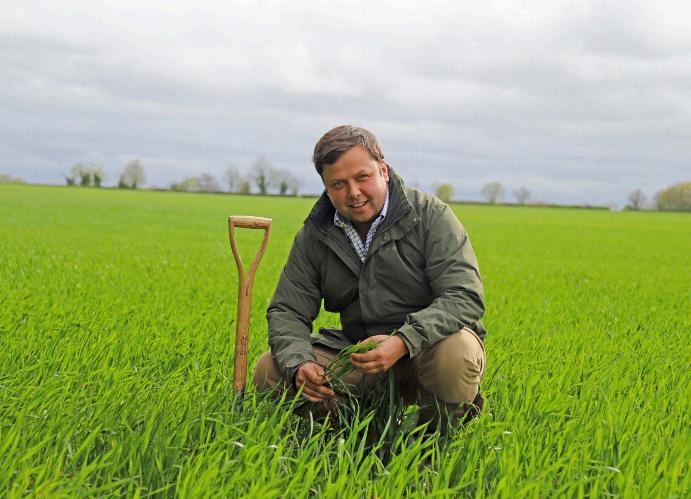
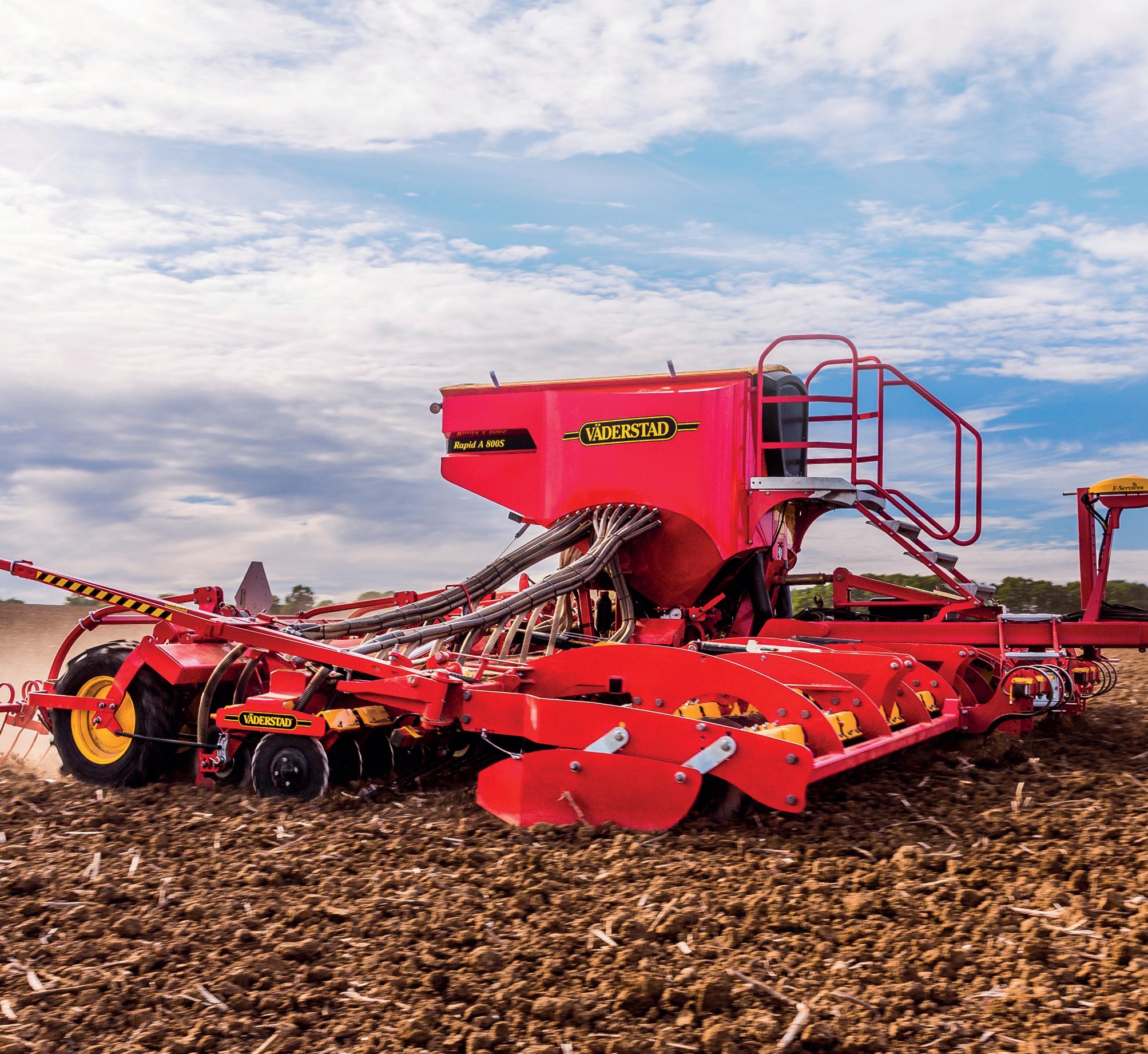
Rapid A
Rapid A offers great design and a series of innovations which reduce the maintenance, improves the performance and makes drilling simpler. Rapid can be equipped with the unique SeedEye counting technology. Farmers can now set the number of seeds per square metre without needing to perform calibration tests.
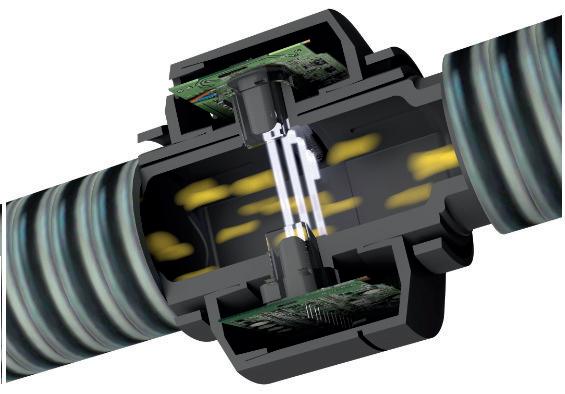

ara UK congratulates Chris Harrold on his promotion to Head of Crop Nutrition Agronomy. He takes on the new role as part of a wider review of the agronomy function within Yara in the UK.
The agricultural sector is changing at pace and as farmers move towards a more regenerative approach to crop production, there's a need to improve crop productivity and do so sustainably. "Yara is wellknown for providing high quality products and sound technical advice based on strong data," comments Chris. "The review of how our agronomy team supports our customers will ensure we continue to adapt and provide relevant advice that meets their needs."
Chris comments that the agronomy team's recent attendance at events like Cereals and Groundswell highlighted a prime example of the need to adapt Yara's advice to emerging approaches to crop production. "Many farmers are adapting their cropping to deal with changes in the economics of growing certain crops and are considering growing alternatives. They are also looking at how they can best make their crops more resilient to extreme weather. Agriculture is changing, and the support and
advice we offer must change with it."
Speaking about what he is looking forward toabouthis new role, Chris says it'stheopportunity to collaborate. "We will achieve more as a team within Yara by collaborating and the industry will achieve more if we collaborate with external partners. From speaking to people at events over recent weeks, I think there's a recognition that we need to work together to bring real benefits to the industry. We can't do it on our own, but we'll have more success if we work with other businesses, advisory bodies, and policymakers," says Chris.
Chris points to Yara's recently formed partnerships with Simpsons Malt and PepsiCo Europe as examples of how collaboration can drive meaningful and lasting change. "Collaboration with ambitious partners like Simpsons Malt and PepsiCo Europe isreally important. The agronomy team are already involved in that, and I suspect that this approach to how we do business will only grow. As a company, we have it all;the cropnutrition solutions, digital tools, and sound agronomic knowledge. How we exchange knowledge going forward will be through our partnerships," says Chris.
project starting this week is aimed at improving management of cabbage stem flea beetles (CSFB) which are the primary cause for the dramatic reduction in the area UK Oilseed Rape (OSR) crops over the last decade.
AHDB has contracted NIABto monitor migration of the adult insects from August to October and larval invasion from September to October, at sites across England.The information obtained will be made available to farmers during the 2024-25 growing season – and it may also be used for research.
To monitor adult CSFBs, yellow water traps will be used at ground level (to monitor general activity) and at a height of one metre(to monitor flying) atsevensites across England.In onelocation, monitoring will be undertaken in two to three more fields,to gauge variation in CSFB activity in nearby crops. Updated data will be available on the AHDB websitetwice a weekthroughout the monitoring period.
At alllocations, a Bayer MagicTrap (new to the UK), which photographs beetles caught in the trap, uses image analysis to identify and count CSFB, and transmits information remotely,will be used as well as the yellow water traps. This will allow data to be compared to that of traditional yellow water traps, which have to be personally monitored, with beetles
counted 'by hand'.Weather data will also be recorded.
To monitor invasion by CSFB larvae, 50 plants within 10 metres of the traps at each sitewill be assessed for presence and numbers ofscars on the plants that show they have been attacked by larvae. Again,data will be updated regularly on the AHDB site.
Sacha White, AHDBLead Crop Protection Scientist, said:
"We believe that this information will be of use to growers in selecting integrated pest management interventions, thereby helping reduce crop losses.The data will also be useful in future work looking to develop risk prediction models."
At the end of the project, a full dataset will be available, including adult CSFB numbers for each trap, larval scar assessments, weather data, assessment dates, location information and agronomic information such as dates of field operations (e.g. harvest, cultivations, drilling), pesticide usage, methods of cultivation and information on other CSFB management approaches used in the field, such as companion crops.
See theCSFB monitoring resultson the AHDB website.
Manage risk by taking on board the lessons of the challenging 2023/24 season when making this autumn’s drilling and variety decisions, wheat growers are being urged.
According to Syngenta seeds technical manager, Matthew Bull, as well as the big challenges of delayed drilling and intense Septoria pressure last season, other issues such as stunted root growth in waterlogged soils also affected winter wheat.
So it is important to take these and other risks into account when planning for the new season, and to adopt strategies to help mitigate them, he suggests.
“Septoria is exacerbated by early drilling,” says Mr Bull, “so if planning to drill early this autumn, look for varieties that have shown reliable Septoria resistance. This isn’t a guarantee that Septoria won’t develop, but it can buy some time against the disease if fungicide sprays are delayed.
“Also, look for other variety characteristics that are important if drilling early, such as stiff straw. Earlier planting increases lodging risk as it encourages taller growth.”
For feed wheat growers in England, Mr Bull says the variety Graham is a good option in first wheat and earlier drilling situations, with its robust Septoria tritici resistance. Because it came from a French breeding programme, he says it has unusual genetics in the UK and its disease resilience has held up well.
“Also important, Graham is slow growing over winter with a prostrate growth habit and late to reach the stem elongation stage, which helps protect it against frost risk. If a fast-developing variety is planted early, there’s a risk of late frosts damaging the young ears as they develop inside the plant during stem


Winter wheat variety Graham has performed consistently over different seasons, and is a useful option for managing risk in an earlier drilling situation, says Matthew Bull
elongation, which can compromise yield. A variety that’s late to start elongating is also less likely to grow tall, lowering its lodging risk.
“In farm situations, Graham has outperformed what you might expect from its AHDB Recommended List (RL) ranking, and its early maturity can spread harvest risk. With later-maturing varieties that start grain-filling later, yield can be affected if hot summers cause crops to die off prematurely,” he adds.
Where fields are being drilled later this autumn, Mr Bull says SY Insitor is a good feed wheat option, particularly as a second wheat. It also has the highest yield figure on light soils on the AHDB RL, at 106%, making it a useful option for planting after root crops grown on these land types, he notes.
“SY Insitor also roots well, which is important if drilling later and on light land. The almost ceaseless rain and waterlogged soils during the first half of the 2023/24 season resulted in a lot of shallow-rooted wheat crops, because they didn’t need to grow deep to find moisture. In these situations, a variety that naturally roots well offers added security if it later turns dry,” he adds.
As well as good rooting and yielding well on light land, SY Insitor has a good grain specific weight, says Matthew Bull, and is a strong contender for later drilling, for example after root crops
Monitoring by Dr Vijaya Bhaskar at Teagasc Oak Park in Ireland has found a complex resistance picture in mixed grass weed populations that helps inform herbicide choice.
Samples are sent to Dr Bhaskar from fields where herbicide resistance is suspected because the control is less than expected. The work is part of Teagasc’s Weed Watch initiative and has been running since 2019.

The research tested popular contact-acting herbicides based on ACCase (clethodim, cycloxydim, pinoxaden, propaquizafop) and ALS chemistry (mesosulfuron, iodosulfuron, pyroxsulam).
It initially focused on sterile brome and wild oats, but as other grass weeds spread on Irish farms, black grass and Italian ryegrass also became targets.
“For blackgrass and Italian ryegrass, we see new fields every year,” says Dr Bhaskar. “The situation is quite complex due to the spread of native weeds, and those we suspect have been introduced. Rats tail fescue is now also becoming an issue in a min-

till situation.”
The results show a complex resistance pattern for each weed population, amplified at field level if there is a mixed grass weed population. Dr Bhaskar believes resistance has evolved in Irish strains, much of this due to the innate tendency for resistance to develop to herbicide actives.
“Herbicides like clethodim and cycloxydim rarely develop enhanced metabolism non-target site (NTS) resistance. The likelihood of resistance developing in a weed population is through target site mutations.
“However, clethodim is still less affected by targetsite resistance as the degree of resistance depends on specific mutations and zygosity, as well as the ploidy level of a grass-weed,” explains Dr Bhaskar.
Dr Bhaskar’s analysis is mirrored in the results from 2023. Centurion Max (clethodim) was effective against all the blackgrass samples (picture 1), whereas 42% were cross-resistant to all the other herbicides tested.
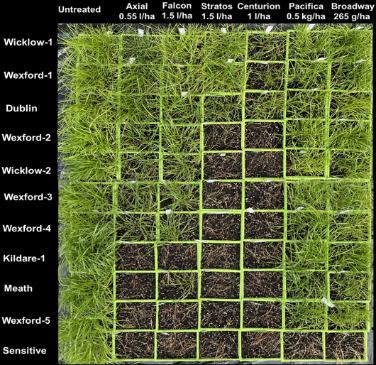
The picture for Italian ryegrass is more complex and challenging (pictures 2 and 3). 15 of the 17 samples analysed had resistance to ALS or ACCase chemistry, the exception being Centurion Max, which remained effective against all but four of the samples.
Bromes were more positive, with all the herbicides effectively controlling the samples.

October application of Centurion Max followed by propyzamide applied in mid-December.

Antonia Walker, technical specialist for UPL, believes the difference in performance seen from Centurion Max when compared to the other ACCase herbicides is because clethodim is much less affected by the 1781 mutation, which makes grass weeds highly resistant to other herbicides in this group.
“The main mutation to impact clethodim’s performance is 2078,” says Antonia. “Studies have shown this to be much less common in UK black grass populations. However, Italian ryegrass has it at a higher frequency, although our studies have shown that clethodim will still have some effect.”
UPL continues to watch the resistance levels in grass weeds and is monitoring samples gathered from fields, explains Antonia. She advises growers to participate in initiatives such as the Teagasc Weed Watch programme, taking grass weed seed samples for testing and keeping a record of the information for each field.
Advice to get the best grass weed control in oilseed rape this season
UPL’s Antonia Walker believes the opportunity to use alternative modes of action in oilseed rape could help farmers get back on track after a difficult season for grass weed control.
“UPL has investigated autumn black grass control programmes in oilseed rape and has discovered that the most effective control came from a mid-
“If the propyzamide is delayed until mid-January, then this reduces black grass control compared to a mid-December application by almost 10%.
“We believe this is because it allows some of the black grass that survived the Centurion Max to recover sufficiently to develop roots below the subsequent propyzamide layer in the soil,” advises Antonia.
For growers planning Centurion Max this autumn, Antonia says there are several steps farmers can take to maximise its effectiveness.
She cites research conducted by independent consultant Stephen Moss investigating the effect of water conditioners. Across six field trials, a water conditioner increased black grass control by 11% on average, regardless of the water hardness. Significantly, where the populations were more resistant to clethodim, the benefit was even greater than the average, says Antonia.
“We recommend that Centurion Max is not applied after the 15th of October or when the crop goes beyond six true leaves. This is primarily a crop safety measure because the plant must be growing to metabolise the clethodim and avoid damage from the herbicide.
“The ideal timing to spray black grass with Centurion Max is when it is at three true leaves and has not tillered.
“There should be a ten-day interval between applying any pesticide and Centurion Max and a fourteen-day window after it has been used where no other pesticide should go on the crop,” advises Antonia.
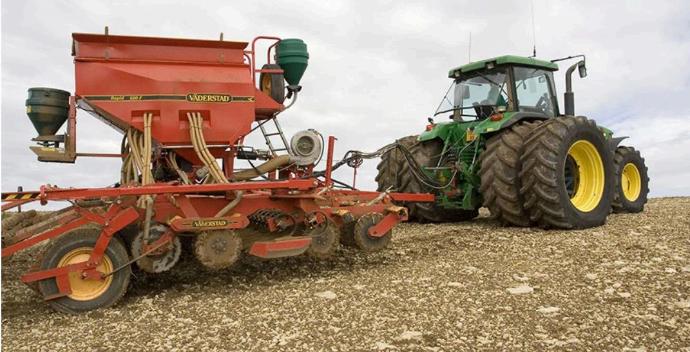
Bridgestone’s Stephen Lamb contemplates the Question, if it’s better to dual or not to, especially if we wish to reduce soil compaction and increase yields with our drilling operation.
It’s an interesting question, and one that would have not necessary been asked before the advent of IF and VF technologies came along. But it should be now challenged and well worth doing the exercise to establishing the answer. To be clear here, we are only talking about the use of duals to enable you to drill lightly over the land, where compaction and yield are the key focus and not for any stability or consolidation requirements. So, let’s start with your current dual drilling set-up and look at the following areas:
• Operating Pressure
• Total Tyre Width
• Load Applied
• Working Width of the implement to gain ‘Tyre to Field Percentage Contact’
Once we have these benchmarks, we can look at other potential solution improvements to the reduction in compaction and an increase in yields from the current dual fitment set-up to than of a single fitment set-up, potentially.
As an example of this, please see the below, where the current set-up has 4qty 650/65 R42 with a 4m trailed drill and an axle load of
6,000kg (single fitment - transport / raised).
If we were to offer, say, 2qty VF650/65 R42 as one alternative, could two tyres be better than four?
Operating Pressures - With the load of the axle being 6,000kg – All tyres (load) would operate at the manufacturers lowest permissible limit of 9psi.
• Duals (4x25.5) = 102”
• Singles (2x25.5) = 51”
• Duals 102 x 9 = 918 lbs per inch of forward travel.
• Singles 51 x 9 = 459 lbs per inch of forward travel.

So, with both set-ups operating at the lowest pressure setting possible, the singles win here. However, if there was a greater pressure differential between the two setups and/or the duals had smaller widths of tyres, then duals could well be more beneficial.
Working Width of Implement – 4m Tyre to Field Percentage Contact
• Duals = 65%
• Singles – 32.5%
So here the duals have a much greater contact with the field, and therefore a greater area of topsoil compaction will be developed than the singles, as both operate at the same pressure.
Looking at Yield Loss - Independent studies have shown that by having an operating pressure of some 9psi, a yield reduction of some 10% could be encountered within the wheelings. So, if we were to take a field size of say 10ha with a yield potential in (un-Trafficked area) of 10t per ha. the following would be the Yield result –
Duals
• 35% Un-Trafficked
• 65% Trafficked
3.5ha x 10t = 35t + 6.5ha x 9t = 58.5t
Total Yield = 93.5t
• 67.5% Un-Trafficked
• 32.5% Trafficked
• 6.75ha x 10t = 67.5t + 3.25ha x 9t = 29.25t
Total Yield - 96.75t
So due to the singles having a lower field contact percentage the reduction in yields from the wheelings is lower, and therefore offers a 3.25t yield improvement.
In this one example, where singles benefit from less load applied to the soil, due to less contact with the soil. Therefore, less reduction of yield loss via the wheelings, along with the additional benefits of not having to fit and remove, nor requiring any road transport width considerations as with duals.
While this is one exercise where singles do benefit, you would need to conduct your own individual exercise to see if an alternative tyre solution specification and/or size could help or hinder your current dual set-up.
Indeed, where you have a significant differential of operating pressures and/or the total tyre width between duals and singles, then one could well outperform the other when compaction and yields are your priority.
It’s about getting the balance right between those elements. So, it’s worthy exercise to conduct in order to maximise the performance of your current set-ups.


Abumper offering of farmland in the South West has landed on the market just in time for autumn.
• The Orchards at Hornblotton: five orchard enclosures, amounting to 41 acres.
• Forton, near Chard: a plot of productive pasture and arable land extending to 91 acres
• Ash near Martock: four productive arable fields, 43 acres in total
• Thornymarsh Lane in Castle Cary: two parcels of pastureland, amounting to 58 acres
• Watton Hill, Dorset: 82 acres of arable land, pasture and woodland.
• Land at Abbeywood Farm,
Devon: 34 acres of pasture and arable land
First up is a rare opportunity to purchase established orchards in cider-county Somerset.
The Orchards at Hornblotton in Shepton Mallet comprise five productive orchard enclosures extending to 41 acres in total.
“Aspiring cider producers will jump at the opportunity to purchase the orchards at Hornblotton, which have all been planted within the past four to five years with varieties including Dabinett, Harry Masters, Major and Ellis Bitter,” says Jack Mitchell, Partner at Carter Jonas.
“They benefit from a stone track which provides access from the road to all the orchards, which are bounded by mature hedgerows and a number of mature oak trees.
“The guide price for the orchards at Hornblotton is £440,000.”
A trio of land parcels located in the in-demand county has also become available, and Jack predicts it won’t be long before they are snapped up.
A plot of productive pasture and arable land extending to 91 acres is up for sale in the village of Forton, near Chard in Somerset.
“This productive land is available as a single block or in three separate lots, the largest being 73 acres,” explains Jack.
The largest lot has a guide price of £775,000. Lot 2, which comprises 11 acres, has a guide price of £135,000 and lot 3, which is 6.75 acres, is up for £95,000.
A separate parcel of productive arable land is on
the market near the Somerset village of Ash near Martock.
“The land at Ash comprises four arable field enclosures totalling 43.54 acres and is offered for sale in two lots by online auction,” explains Mr Mitchell. “Lot 1 comprises 24 acres and Lot 2 amounts to 19 acres. Lot 1 has a guide price of £365,000, and Lot 2 is up for £290,000.”
Finally, a parcel of productive pastureland is on the market at Thornymarsh Lane in Castle Cary.
The land at Thornymarsh Lane comprises two parcels of pastureland.
“Lot 1, which has a guide price of £530,000, amounts to 44 acres, and Lot 2 comprising 14 acres and has a guide price of £195,000,” says Mr Mitchell.
“In total, it extends to 58.63 acres and can either be purchased as a whole or in two separate lots.”
Across the county in Dorset, land has become available on one of region’s most

recognisable hills.
“Watton Hill is one of the iconic hills surrounding Bridport,” says Mr Mitchell. “The lot is divided between several pasture paddocks, larger pasture enclosures, attractive woodland, and productive arable land.
“Given that Watton Hill is situated on the edge of Bridport, adjoining the residential development boundaries of the town (with part of Lot 3 falling within the development boundary), the land may have development potential, subject to obtaining the necessary consent.”
Watton Hill extends to 82 acres in total and is up for sale in up to five lots or as a whole, with a guide price of £1m.
Finally, between Hemyock and Dunkeswell in Devon a parcel of productive and accessible pasture and arable land is up for sale with a guide price of £400,000.
“The land at Abbeywood Farm comprises four good sized, level and gently sloping field enclosures currently laid to pasture but also capable of supporting arable cropping, having in the past grown cereal crops and maize,” says Mr Mitchell.

How big are the savings?
Based on a 30tph throughput drier, drying 6,000T of wheat per season in average UK conditions, the direct drying cost savings would be approximately £21,500 per season.
Using a 60tph throughput drier, drying 15,000T of wheat per season in average UK conditions, the direct drying cost savings would increase to approximately £53,500 per season. Over 3 seasons that would become over £150k of savings.
Contact us with your real-life data and we’ll run it through our calculator and show you how much you could save.
Grain Sentry is Perry of Oakley’s Automatic Drier Moisture Monitoring System which controls the drier temperature, fan speed and discharge speed of your grain drier automatically by measuring the input and output grain moisture content.
How does it work?
Grain Sentry utilises a moisture meter using Near InfraRed technology. Traditionally moisture meters have required multiple calibrations each day to ensure their accuracy. The one utilised in this system only requires an annual calibration (that’s a game changer). That one change creates a substantial reduction in the manhours it takes to operate the system while also improving the accuracy of it. This technology has been integrated with the Perry Savannah range of continuous flow grain driers by using a suction system fitted to the incoming and outgoing conveyors or ducts which results in a true average sample being taken. The samples are then returned pneumatically to any suitable point in the system, so the grain is not lost.
Alongside the innovative engineering sits the state-ofthe-art self-teaching algorithm. This has been developed in-house at Perrys by utilising all of the team’s extensive knowledge of real-world drier operation so it closely replicates how experienced drier operators would run their drier.
Grain samples are taken from the drier at a minimum of every 2 minutes. The moisture content is measured, and the results fed into the self-teaching algorithm which calculates how long the grain needs to transit through the drier, at what drier temperature, fan speed and discharge speed. Based on that information the system then changes those parameters to achieve the required grain moisture content
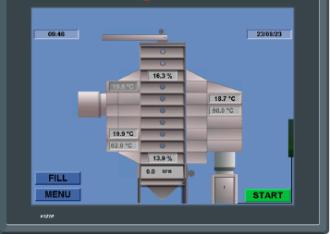
without over-drying. As you would expect the system is built with various alarms and alerts which can be sent to mobile phones. This means your operator can be doing other work on the farm while it is running.
The combination of the accurate moisture meter and the self- teaching algorithm system prevents the quite large financial losses associated with over-drying grain such as decrease in weight, extra fuel usage, labour, and electricity, for example. This means big savings and peace of mind can be achieved, especially when coupled with the manpower savings from using a moisture meter that only requires annual calibration.
Contact us with your real-life data and we’ll run it through our calculator and show you how much you could save.
It can be retro-fitted on to any shutter discharge continuous flow grain drier, and is a recommended optional extra on all Perry Savannah Series driers.
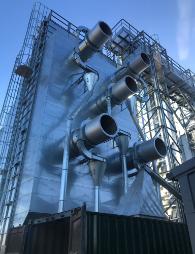
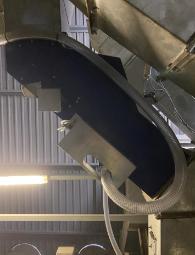
As a long-established British designer & manufacturer of grain drying, handling & storage equipment Perrys can provide everything you may need from a single machine through to a whole plant. Their in-house team do all their own product development which means that you can get quick answers to any problems you might have. Perry’s Devon-based factory also holds a large stock of spares to support you when you need it most. We even man the phones evenings & weekends especially through harvest.
Contact Perrys today for all your handling, storage & drier requirements on +44 1404 890 300 or email sales@perryofoakley. co.uk



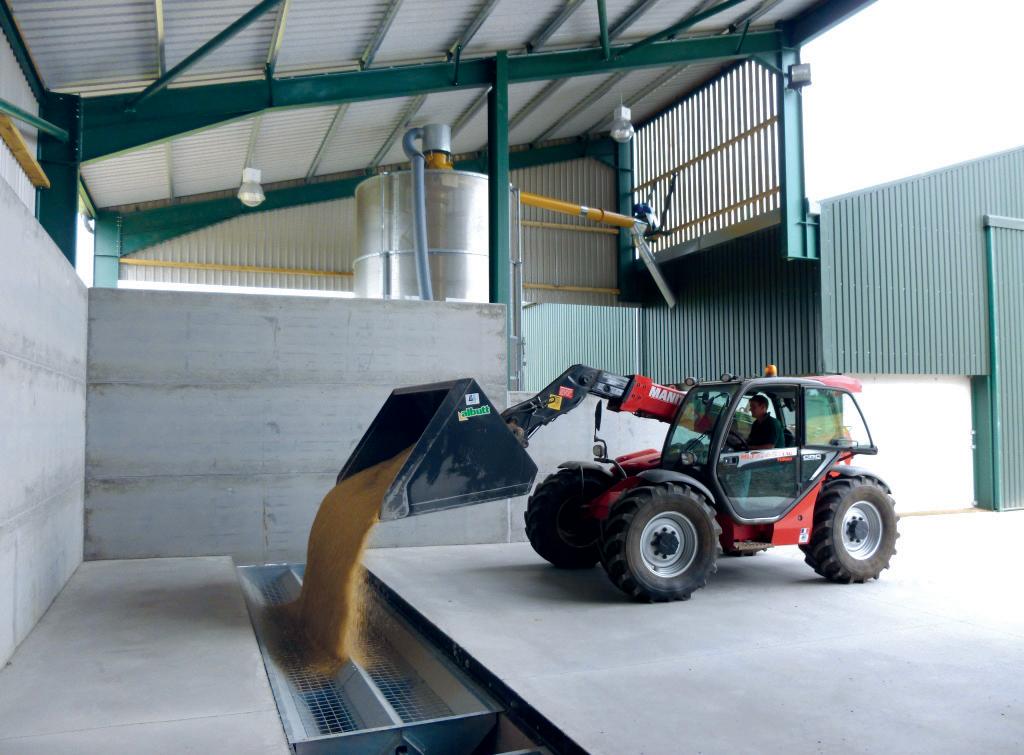
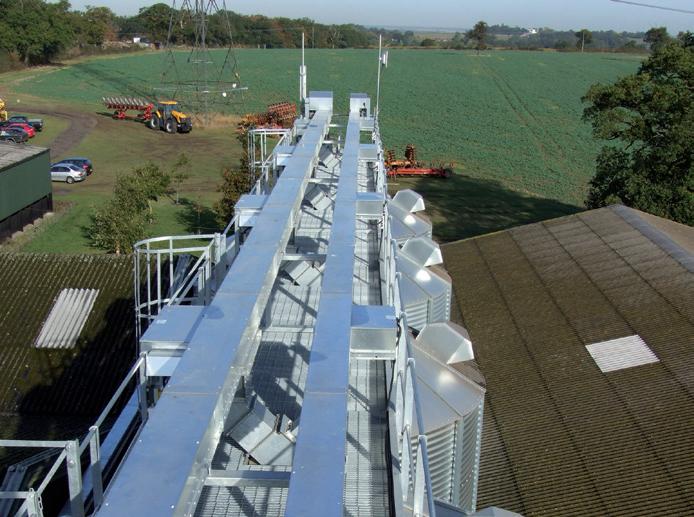


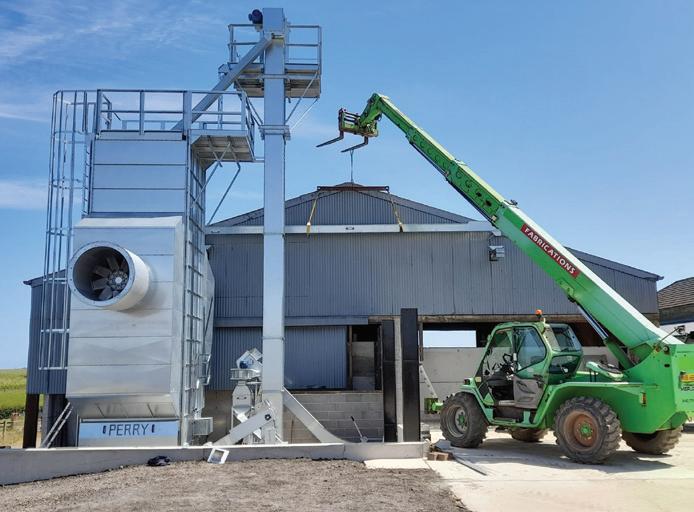
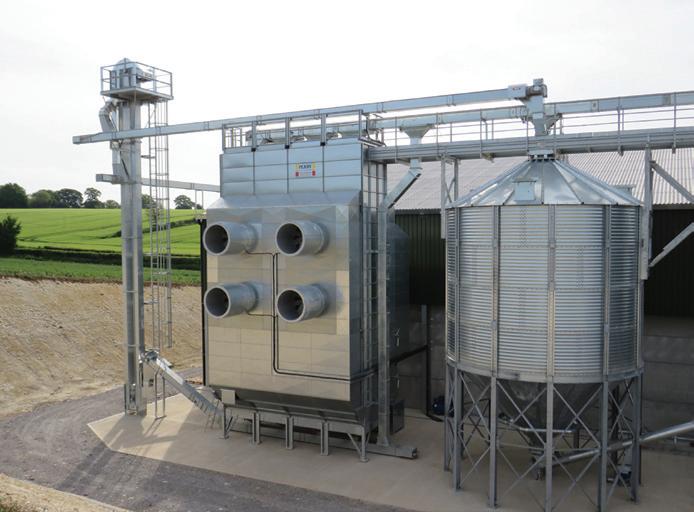
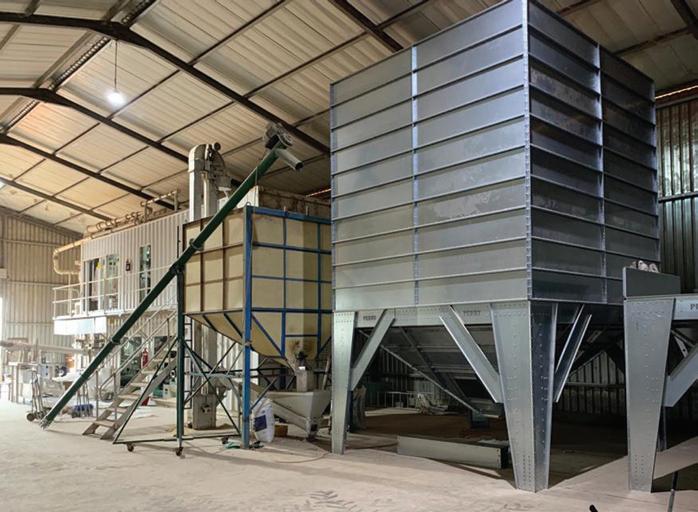


Have you filled in our 2024 harvest survey? A few minutes of your time will help us to lobby for a stronger arable sector. Deadline: 29 September.
After a year of remarkable challenges, we’re urging arable members to share their data in the 2024 NFU Harvest Survey.
Help us build a strong case to government
NFU Combinable Crops
Board chair Jamie Burrows stressed how a handful of minutes online will help the NFU to make the strongest of cases to government for policies that build resilience in the sector, and support our food security.
“Given the challenges faced by growers this year, I want to ask for your support in our 2024 Harvest Survey, and to stress just how important it is to gather this data,” he said.
“It means we will be able to evidence how this year’s perfect storm of increased input costs and weather have affected harvest. We will take this forward across our lobbying, laying bare the challenges to resilience in the combinable crops sector.”
He added: “Your experiences are not only important on a national scale, but also at regional
level, where variations, especially in terms of the weather, will tell the story of the disparities across the country.
“The more regional data we have, the more tailored we can be when taking this information back to MPs and officials and the more relevant a case we can make.
“This survey will only take a few minutes and should be undertaken once you have finished harvest to get the most accurate figures possible.
“It is a lot to ask at such a busy time of year, as I know the work doesn’t stop once the combine has been put away, but those few minutes will help us to build the strongest possible evidence base.
“I’m conscious that many of you will have already filled in surveys for us this year –and I’m also conscious that this growing season has been one that many of us will want to get over.
“However, the strength of the picture we can present will be determined by the number of responses, so I would like to encourage everyone to take part.”
• Please do not fill in your survey unless your harvest is complete.
• If your harvest is not complete by the survey deadline, please give the average yield realised on the area harvested to date.
• Yield estimates should be based on dried samples. If this is not possible, please adjust to give your best estimate of yield on a 14.5% (approx.) moisture content basis for cereals, 9% for oilseeds and 16% for proteins.
• Areas planted – record the same areas as you entered on your June Census return.
• All figures must be in metric units, (tonnes and hectares).
• To convert to hectares, multiply the area in acres by 0.405.
Take the harvest survey at https://nfu. welcomesyourfeedback.net/ s/1g3ys0
Aproject bringing trials of precisionbred cereal crops onto commercial farms for the first time in Europe is now underway.
Trial plots of a precision-bred wheat variety, which could lead to a 'greener' farming system have now been harvested, marking the start of a groundbreaking new project.
PROBITY – A Platform to Rate Organisms Bred for Improved Traits and Yield – brings farmers, scientists and food manufacturers together to trial the production and processing of precision-bred crops to accelerate understanding of their value to sustainable food and farming.
Led by the British On-Farm Innovation Network (BOFIN), it is a three-year £2.2m multipartner project, funded by Defra's Farming Innovation Programme, which is delivered by Innovate UK.
Farmers are encouraged to get involved with the project by joining the Sequence Circle at probityproject.co.uk a new community set up to lead discussion on precision-bred crops and help steer the project.
Precision-bred crops can be created through gene editing, a widely used technology that enables scientists to make changes to plant DNA, like those that occur naturally, but introduced in a precise, targeted manner. Gene editing speeds up the process of breeding more productive, nutritional and sustainable crop varieties.
The Genetic Technology (Precision Breeding) Act 2023 allowed for the release and marketing of certain gene-
edited plants. This currently makes England the only country in Europe where this novel material can be grown in farmers' fields.
The seed harvested from plots at the John Innes Centre near Norwich will be multiplied up during 2025, to enable farmers in England to grow trials of the crop the following year.
Two further cereal varieties are being grown in glasshouses at Rothamsted Research, and once harvested this autumn, will also be multiplied up to be trialled on farms.
The three varieties will be grown on commercial farms and subjected to testing and scrutiny by farmers, scientists and food manufacturers to establish their potential.
The three cereal varieties in the project are:
• A wheat with superior baking, toasting and processing properties
• A barley making high lipid, high energy forage aimed at lowering livestock methane emissions
• A wheat with a bigger bolder grain size promising a step change in productivity.
Tom Allen-Stevens, Oxfordshire farmer and founder of BOFIN said: "This is an incredibly important project for farming and food production in this country.
"We need to produce more, nutritious food with fewer resources and with less impact on the environment. Scientists have been developing new crop varieties that could help us rise to that challenge. This project will
bring those varieties from the laboratory to farmers' fields where we can fully assess their potential, explore barriers to their adoption and pave the way for future innovation."
Professor Nigel Halford, technical lead of PROBITY and scientist at Rothamsted Research who developed the healthier wheat line said: "It's tremendously important that we grow these varieties on farms so that farmers and food manufacturers can see the benefits and want to use them, and that consumers can be reassured that they're no different in practical terms from other varieties of wheat."
The high lipid barley variety was developed by Professor Peter Eastmond at Rothamsted Research. He said: "This project is hugely significant as it's the first time in my career that it's been possible to grow these varieties on real farms. The work leading to this point has all been funded by the taxpayer so it is extremely important to take it to the next stage and see if this trait could stand up from a commercial point of view."
Professor Cristobal Uauy, scientist at John Innes Centre who developed the bigger bolder wheat variety said: "This project provides a unique opportunity to work with farmers and test precision-bred crops directly in their fields. We are extremely excited as this brings us one step closer to delivering wheat varieties with traits which will help us towards regenerative agriculture, a greener farming system and enhanced nutrition and quality."
For more information on the project visit probityproject. co.uk
Many Recommended Lists (RL) harvest results are now available for major winter crops, with some very high disease levels and variable yields recorded. Jason Pole provides an at-aglance summary of the latest picture from the variety trials for cereals and oilseeds.
The UK’s winter combinable crops weathered prolonged wet and mild spells throughout most of the growing season. In recent weeks,commercial harvest has progressed at pace, with below-average yields recorded for many winter crops. Crop and weather conditions have also caused some delays in combining, especially in winter wheat.
The season’s impact on varieties in RL is becoming clearer as more harvest results are released. Although harvest 2024 yield averages are close to over-year averages, the challenging growing season led to some very high disease levels and variable yields across the variety-trial network. Additionally, several trials have been abandoned due to poor crop condition.
Winter barley trials
In the RL winter crop trials, winter barley appears to have fared the best. Overall, fungicide-treated yields are slightly above the five-year average control yield. Trials were established in good conditions, well before the weather broke. Apart from some localised waterlogging, trials wintered well.
The most notable diseases were brown rust and rhynchosporium, which were common in fungicideuntreated trials. In the runup to harvest, strong wind and rain at some sites caused lodging and brackling in the weaker-strawed varieties. Over half of the results for this crop are now available.
Winter oats trials
Winter oats also went in before the most challenging autumn weather and established well (overall, fungicide-treated yields are about average).
Very high levels of crown rust were seen in some fungicide-untreated trials in southern England. Sometimes, infection was so severe that varieties failed to properly head. Lodging was also widespread, even in PGR-treated crops. Most results are now available for this crop.
It has been a very difficult season for commercial and RL oilseed rape crops. This year, we had to abandon almost half (9/19) of the fungicide-treated trials and nearly all (6/7) of the fungicide-untreated trials. The impact of relentless wet weather, flea beetle feeding and pigeon grazing all added up. In some trials, clubroot and light leaf spot were problematic too. The latter caused some severe plant stunting (something
we rarely see).
Results from the surviving 10 fungicide-treated trials are available. The average yield of the control varieties is 4.92 t/ha (the four-year average is 5.05 t/ ha).
The performance of winter oilseed rape is often more variable than cereals (both within and between trials). Variability is particularly stark this year. The lowestyielding trial (Midlothian) and two highest-yielding trials (both in Cambridgeshire) saw the controls yield 3.58 t/ha and 6.08 t/ha, respectively.
On Friday we published the first RL harvest results for winter wheat, adding more sites today (27 August 2024). It takes the total fungicide-treated sites reported on to nine.
As in commercial crops, when crops were drilled after the weather broke in mid-October, they struggled. In fact, several trials were lost because of waterlogging and flooding, particularly through the middle of England.
Disease was quick to get going in the spring. Although considered a late-season disease, we reported on veryearly brown rust infection in RL trials and commercial cropsat the start of May.
The RL is dominated by varieties with moderate levels of resistance (disease ratings 5, 6 and 7) and we recorded some of the highest brown rust levels for many years in untreated trials. We also saw high levels of septoria tritici.
Until recently, we aimed to keep disease below 5% in fungicide-treated trials. If disease was above this, the yield information would not have been used in the main data set. However, with the chemistry now available, we can no longer hope to keep disease below 5%, especially in a high-disease-pressure year, such as 2024.
With the potential to lose large amounts of data, we now include data from fungicide-treated yield trials even when disease exceeds 10% (if the fungicide protocol has been followed). The revised RL protocols now better assess genetic potential in context with the fungicides available to us today.
The treated control yield average for the first sites is slightly below the five-year average of 10.95 t/ha, pulled down by some low-yielding trials in the latest data release.
With more than 20 trials due to report, it is early days for this data set.
Credit: Jason Pole
AHDB - Technical Content Manager – Cereals & Oilseeds

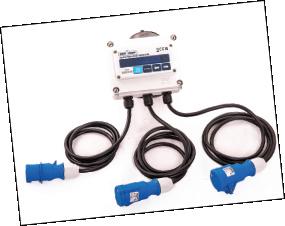


Top UK accountancy and business advisory firm
Johnston Carmichael has appointed a new business advisory director in its Edinburgh office as it seeks to grow its rural sector practice.
Annie Fleming, who completed her training at Johnston Carmichael and is Association of Chartered Certified Accountants(ACCA), Association of Tax Technicians (ATT) and Chartered Tax Adviser (CTA) qualified, returns to the firm after spending eight years in industry, operating at CFO level within some of Scotland’s most well-known and respected businesses.
From a farming family, and married to a farmer, Annie works with ownermanaged businesses across a variety of sectors, including professional services and property, but will increasingly focus on rural businesses in collaboration with colleagues across the firm.
Johnston Carmichael has a wellestablished rural offering, which is led by partner Jenn Stewart, also Head of Dundee, but the firm aims to be more active in southern Scotland and northern England after it opened its first permanent Newcastle office almost two years ago.
Annie said: “The rural sector continues to evolve and adapt to changing markets, and my experience of working across other industries will help these businesses grow and develop.
“It is a difficult time for farmers, especially as we grapple with the challenges of climate change.
“Farming businesses are having to digitise and use much more technology in their day-to-day operations. They are diversifying into new areas, such as
holiday lets, and renewable energy including solar and wind.
“Some people perhaps don’t realise just how much work the farming sector is doing to drive positive change. We are feeding the nation and using technology and innovation to maintain the land for future generations, so it’s an interesting industry and there is much work to be done.”
Annie, who lives on a farm near Ratho, just

outside of Edinburgh, will be mostly based at Johnston Carmichael’s Edinburgh office but will use her expertise to support a variety of owner-managed businesses across the firm’s network.
She added: “I feel like I have come home.
I’ve been made really welcome by everyone, but at the same time, they appreciate my time away gaining experience at other businesses, which I can now bring back to help advise our clients.
“The firm has grown significantly since I left, but what hasn’t changed is the sense of legacy and the importance of developing the next generation to future proof the business and ensure succession for clients.
Johnston Carmichael lives and breathes
that, and I am proud to be part of such a firm.”
Jenn Stewart, partner and Head of Rural, Johnston Carmichael, said: “We welcome Annie back to Johnston Carmichael, and it’s wonderful that she has chosen to return to the firm to develop the next stage of her career. Her experience and knowledge will enhance our rural offering as we go to market in new geographies and help our farming community take advantage of the opportunities that lie ahead as well as dealing with some of the challenges they face.”
For further information, please contact BIG Partnership on jcca@bigpartnership.co.uk or call 0141 333 9585.

K Dairy Day, the UK’s leading free-to-attend dairy trade event, is held at The International Centre in Telford, TF3 4JH on Wednesday 11th September 2024. Established in 2014, UK Dairy Day celebrates its 10th Anniversary and is the event to attend for anyone connected to the dairy industry providing an opportunity to network, share knowledge, learn and most importantly, do business.
UK Dairy Day will feature practical demonstrations as follows;
• Foot Trimming, Blocking & Knife Sharpening
• 'Beneath the Black and White' Calf Painting
• Type Classification & Linear Scoring in Hall 3 foyer
Foot Trimming, Blocking & Knife Sharpening Demonstration
Tim Carter will be located in the external trade stand area for practical demonstrations on foot trimming, blocking and knife sharpening. The practical demonstrations on dairy cows during the day will be streamed to a large TV screen with commentary to see first-hand the detail of the trimming, blocking and knife sharpening. Tim Carter is an instructor and assessor for the RAU /CHCSB Level 4 qualification.
They will also promote The Cattle Hoof Care Standards Board, a self-funding non-profit organisation aimed at improving the health, welfare and mobility of the national herd, by ensuring its members promote, achieve and maintain a recognised and validated standard of cattle hoof care.
Timetable:
• 9.30am - Knife sharpening demonstration
• 10.00am - Foot trimming in an upright crush
• 11.00am - Knife sharpening demonstration
• 11.30am Foot trimming in an upright crush
• 12.30pm - Foot trimming in upright crush & correct application of a foot block
• 1.30pm - Knife sharpening demonstration
• 2.00pm - Foot trimming in an upright crush
• 3.00pm - The importance of having the right tools for the job, knives and skills
• 3.30pm - Foot trimming in upright crush & correct application of a foot block
'Beneath the Black and White' Calf Painting Demonstration
Carolyn Baguley MA VetMB CertAVP(Cattle) MRCVS and the team from Scarsdale Vets will be present their innovative and engaging demonstration using paint to visualise and understand calf anatomy. Throughout the day in the external trade stand area, the Scarsdale Vets team will use paint on calves to assist in the understanding of calf health and welfare. The practical demonstration will also focus on twin pregnancies, what causes them and how to manage them.
Scarsdale Vets provides exceptional veterinary care to farm animals, horses and pets. We pride ourselves on providing great customer service to you and top-quality care to your animals. Our farm and equine practice is based in Derby, with twelve dedicated farm vets covering the East Midlands. www.scarsdalevets.com
Type Classification and Linear Scoring Demonstrations
In the Hall 3 foyer, members of the NBDC Classification team will run Type Classification and Linear Scoring demonstrations. The demonstrations will be held at 12.30pm and 2.30pm.
The National Bovine Data Centre (NBDC) collects, manages, analyses and disseminates data relating to bovines in the UK, including pedigree dairy and beef cattle. https://www.nbdc.uk/


Driven by the simple principle of creating a healthy environment and that ventilation is not the volume of air in a building, but critically it is the rate of air exchange, simply clean air in and stale air out - Farmplus design and build to these principles.
Animals left to nature always try to find shelter in the basic form, they use hedges, walls & natural hollows to get out of or reduce the impact of the winds. Likewise, they will use trees for shade from the sun and shelter from the rain. When we look at buildings we should aim to replicate these basic principles of nature wherever possible. Remember that animals want in the basic form shelter from the wind, rain, shade from the sun, and plenty of fresh air. Ideally giving animals a shelter wall to be able to lie behind with a decent gap above for air to pass over. All air movements need to be above animal height so as not to create a draft.
Depending on the height of the wall, the gap above will often need some form of wind break material to reduce wind speed on bad days.
The best and cheapest form of ventilation is and always will be natural ventilation using the stack effect with sufficient gaps at the low eaves and open ridges. No fans using electricity, no moving parts & nothing to breakdown, so no ongoing expense.
In very high rainfall areas, special ventilated ridge capping’s can be supplied. For most situations, the best ridge treatment is still, simple upturned flashing, for these will make the outside air lift over the ridge of the roof. The base of any upstand should always be at a minimum 50mm (2” inch) back from the top edge of the roof sheet, so any water/rainfall that hits the inside of the upright flashing can then drip of the heal and drain away down the roof sheet.
Animals left to nature always try to find shelter in the basic form, they use hedges, walls & natural hollows to get out of or reduce the impact of the winds. Likewise, they will use trees for shade from the sun.
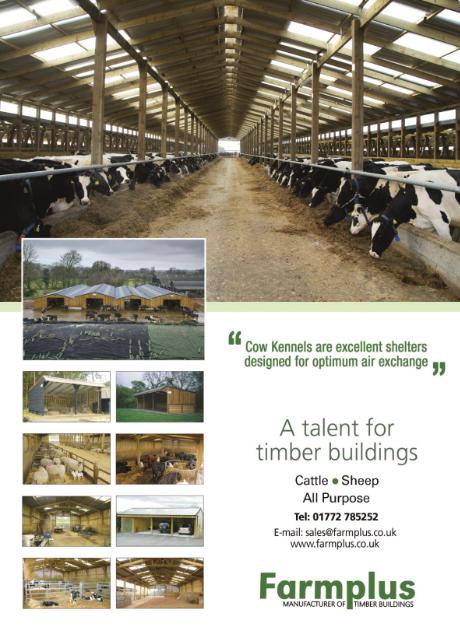




The Glamping Show is the UK’s premier business-to-business glamping event. If you’re a farmer or landowner looking to start a glamping operation, or you are already an established glampsite owner keen to maximise revenue, this is the show for you.
Celebrating its 10th anniversary, the 2024 event is taking place at NAEC Stoneleigh Park in Warwickshire from 19th-21st September. Tickets are free and give visitors access to an extensive exhibition showcasing the latest products and services for glampsite operators, as well as complimentary access to an unmissable programme of seminars designed to help new and existing glamping sites maximise return on investment.
Whether you are looking to set up a temporary glampsite or a permanent operation, glamping units are a great way to generate additional revenue from your land. Come and learn from industry experts and see bell tents, wigwams, pods, shepherds’ huts, cabins and gypsy caravans first-hand, along with eco toilets, portable washrooms, sewage and off-grid power solutions, hot tubs, fire pits, barbeques,
accessories – and a whole lot more. Plus, find out about a range of glamping-related services including booking systems, finance and planning.
According to Peter Rusbridge, Director of Swan Events, the show organiser: “In the last decade, glamping has become increasingly popular and, as a consequence, the industry has grown to become a prominent part of the leisure business. Where it was once a niche concept, it is now a widely recognised and respected part of the outdoor lifestyle industry. 2024 is an exciting time for the glamping industry as The Glamping Show is celebrating 10 years as the UK’s only dedicated glamping industry event and promises to be better than ever before. For farmers and landowners, it’s an ideal time to consider starting or expanding a glamping operation and I would encourage everyone interested to come along to the Show to find out more.”
Register for your free ticket to The Glamping Show 2024 at www.theglampingshow.com


DEMAND for farm-based holidays is continuing to surge, quashing concerns the staycation has had its day.
According to figures from popular booking platform Pitchup.com – Europe’s largest outdoor accommodation provider – searches for camping, glamping and caravaning on farms were up 266% in July this year compared to July 2023.
The growing popularity of agritourism is also being felt at the farm gate with one dairy farmer in Derbyshire having achieved £140,000 in bookings so far this year – double the revenue the campsite had generated by the same point last year.
Pitchup.com’s most popular pop-up farm campsite, operating under the new 60 day Permitted Development Regulations (PDR), has so far taken £63,000 in bookings, also trouncing last year’s sales.

But Pitchup.com founder, Dan Yates, said that the number of pop-up sites listed on the platform was down 10% so far this year compared to last.
As a result, he said that farmers are missing out on a growing opportunity to generate significant extra revenue from little extra work.
He said: “The COVID pandemic sparked a resurgence of interest in holidaying in the British countryside and whereas this was in some sense forced as people could not go abroad, the impact of that is continuing to endure.
“Nowhere is this more evident than in the agritourism sector, which has grown year-on-year since the pandemic, and shows no sign of slowing down.
“In fact, the opposite is true. Our farm filter has seen a 266% increase in use this year compared to last, meaning thousands of people are wanting to spend their holidays on working farms.
“For those farms capitalising on tourism, the sector is delivering big returns which are increasingly
becoming a vital part of the farm business mix. And there’s huge potential in the marketplace to for new entrants to get involved.”
The news follows Pitchup.com breaking its record for the biggest number of bookings in a day on July 31 this year.
The platform received a total of 7,657 bookings on that day, overtaking its previous record of 7,446 bookings which it achieved on August 9, 2022.
Mr Yates said UK holidaymakers were still eager to visit the British countryside despite foreign destinations having been accessible again for more than three years.
“Rumours of the staycation’s death have been greatly exaggerated,” he said.
“The pandemic forced people to rediscover the British landscape, be that coast or countryside, and what we’re finding is that desire is not diminishing with time. In fact, it is growing.
“There are a number of people with significant disposable income who have reverted to foreign holidays, but they are combining those with breaks in the UK at other points in the year.
“Those on tighter budgets are continuing to pick the UK for their main holiday destination because of the value for money it offers, the vastly reduced travel time and cost, and the fact that the landscape is as beautiful and changeable as anywhere in the world.
“Farmers and landowners continue to be in a unique position to capitalise on this and help meet the rising demand. Not only will this provide extra income for their businesses, it plays an increasingly important role in creating sustainable rural communities as tourists spend in the local area.”
One farmer who has noticed an increased interest in farming among her guests is Bridget Gooden, who runs Garslade Farm on the Somerset Levels.
Bridget, who operates the campsite alongside an organic dairy herd, put this down to the ‘Jeremy Clarkson effect’ due to the popularity of his TV show, Clarkson’s Farm.
Bridget said: “Before, people used to ask about bird watching or flooding – things they have seen on the six o’clock news. But now all they want to know is if I watch the programme and if it is true to

life.
“He’s got such a big platform and is controversial, yet a great entertainer. The show has certainly got more people interested in staying on a working farm.”
Bridget added that the cost of living crisis is also playing a role.
“It’s a very touristy area around here and some places are very expensive,” she said.
“We try to keep our prices as reasonable as possible and that helps when people are feeling the pinch.”
Nick Kiddy, who runs Eastgate Farm near Royston in Cambridgeshire, added he gets asked a lot of questions about the farming side of his business.
Nick has 250 acres of arable crops, plus pigs and sheep alongside a campsite.
He said: “Depending on how busy we are, we like to get around everyone when they arrive and they always have questions about the farm.
“We have lambs grazing in the field, so that generally leads to questions too.
“On the whole, people are very interested in the farming side.”
Mr Yates added that setting up a camping site is one of the quickest, easiest and cheapest forms of farm diversification, yet still has the potential to generate significant extra income.
The most back-to-basics temporary sites often only need running water and toilets to operate, but generate on average around £13,000 per season.
In England, where PDR for pop-up campsites has been extended from 28 days to 60 days, there is potential to earn far higher sums without the farmer or landowner needing to apply for extra planning permission.
However, adding more facilities, glamping opportunities and caravan pitches, joining an exempt organisation or securing planning permission to operate all year round can transform a small diversification project into a business turning over hundreds of thousands of pounds per year.
“The great thing about agritourism is farmers can choose the level at which they want to get involved,” Mr Yates said.
“A small campsite operating under PDR needs little up-front investment to get going and generally doesn’t conflict with the day-to-day running of the farm.
“Often, these back-to-basic sites are in great demand as many people seek a bucolic break in offthe-beaten-track locations away from the main tourist hotspots.
“But farmers or landowners with an appetite to create something bigger give themselves the opportunity to attract families and more mainstream holidaymakers looking for a relaxing break in the country.
“These sites do take more management, but can be extremely profitable and a vital part of the wholefarm income.”
For advice on how to set up a farm-based campsite, visit Pitchup’s ‘How to Start a Campsite’ page: https://www.pitchup.com/how-start-campsitecaravan-park/.
APF 2024 is by far the largest woodland, forestry, fencing, arboriculture, trees and timber show in the UK. 300 exhibitors and 25 000 exhibitors are expected over the three days of the show in September.
One of the unique aspects of the show is that much of the machinery can be seen working under realistic conditions on the demonstration circuit. In total there will be over £80 million of machinery and around two and a half miles of working machinery frontage to look at.
The machinery and equipment covers every aspect of woodland, tree and timber management. It is not just focused on woodlands but covers maximising returns from all timber on the farm including individual trees. Almost every manufacturer and dealer of woodland and arboricultural machinery are exhibiting.
All aspects of timber utilisation are on display from chippers producing woodchips from waste timber to the biomass boilers to utilise the chips, firewood processing machines, charcoal kilns and portable sawmills to convert one log into utilisable fencing posts and planks. Much of the machinery on show is designed for use in smaller woodlands and can utilise your existing tractor, telehandler or excavator.
You can get advice on woodland creation, management and the latest grant schemes. Nurseries can assist with species choice, sizes and site suitability. Excellent grants are now available for tree and hedge planting, woodland and deer management and you can get advice on all aspects of these from the Forestry Commission on site.
Industry training provider Lantra can advise on their full suite of practical skills courses covering the Land based sector.
One of the key features of the show is the Fencing Village. All the major fencing manufacturers of equipment and materials are exhibiting and you can watch the machines in action and see the latest materials and techniques. On Thursday 21st the show will host the British Quick Fencing championships using the latest Clipex fencing, now approved for grant aid and Friday will see the traditional British post and wire fencing championships. If you want to
know anything about fencing this is the best place in the UK to be.
Although the show features the latest state-ofthe-art machines more traditional woodland management is not neglected. The British Horse Loggers will be demonstrating how horse extraction can be used on sensitive sites and you can even try your hand at handling a timber horse. There is the largest display of traditional woodland crafts in the UK. Craftsmen and women will be demonstrating such skills as charcoal making, basket weaving, coracle making, Oak swill baskets, hazel whisket baskets, rake making, clogs, wheelwrighting, pole lathe turning, dug out canoes, hazel hurdles amongst others. If you want to know what a Sussex Pimp is this is the place to find out!
In addition to all the above you can watch some high quality events including the Husqvarna World 25m Pole Climbing Championships, the A W Jenkinson & Tilhill European Chainsaw Carving Championships featuring 25of Europe’s top carvers, the APF UK Team Tree Climbing Challenge, the UK Forwarder driving championships and the British Lumberjack championships. There is a full series of seminars on topical woodland issues including carbo credits.
If you fancy becoming a tree surgeon there is a Have-a -Go tree climbing area where you can ascend into a tree with a rope and harness and test your head for heights and, after watching the professional axemen, try your hand at axe throwing.
The show is a great opportunity to see that happens in a modern working woodland, everything from seed to sawmill. Explore possible new careers in the industry. APF 2024 will be hosting guided tours for 800 school children as well as students and graduates, with experts on hand to give career advice.
Discounted advance tickets can be bought on the website or you can buy them on the gate priced £25. There is a campsite on site. Full information about the show including a full list of current exhibitors can be found on the website www. apfexhibiton.co.uk For further information email info@apfexhibition.co.uk. Tel: 01428 723545
n the 19/20/21st September APF 2024, the UK’s largest and most exciting Trees & Timber Show comes to Ragley Estate, Alcester. 300 Exhibitors and 25000 visitors will be welcomed to this biannual event, back at Ragley Estate for the seventh time.
There is an outstanding, unique and exciting array of top class competitions to watch including:
The Husqvarna World 25m Poleclimbing Championships, the A W Jenkinson and Tilhill European Chainsaw Carving Championships, the British Open Fencing competitions for speed fencing and traditional fencing, the Richard Court Forestry Engineering and Coombes Forestry UK Forwarder Driving championships, the Pfanner and Teufelberger UK Team Tree Climbing Challenge, the British Open Lumberjack Championships and the famous World Log To Leg pole lathe turning championships.
Entries are now open for the APF UK Team Climbing Challenge, the World poleclimbing championships and the UK Forwarder Driving championships.
The event offers a host of great spectator and have-a-go opportunities. Visitors will be able to test their head for heights and have a birds-eye view of the showground in the have-a-go tree climbing area, try their hand at axe throwing, basket weaving or rake making and take control of a huge timber horse. They can test their skill with a chainsaw in total safety on the very latest Husqvarna VR chainsaw simulator.
The woodland crafts area has 30 craftspeople demonstrating a huge array of traditional skills. Clogs to coracles, charcoal burning to rake making, four different types of basket weaving, wheelwrighting to willow weaving, dug out canoes to chair making. Try your hand at pole lathe turning. If you want to know what a Sussex Pimp is visit the crafts area!
More details and a daily programme of events is available on the website. For more details contact:
Website: www.apfexhibition.co.uk
Email: info@apfexhibition.co.uk
Tel: 01428 723545
50 local children and their teachers are shortly in for a big surprise when they visit APF 2024 at Ragley Estate, Alcester, Warwickshire. Although it won’t be a Teddy Bears Picnic, it will be something much more exciting!
The children will be going to visit the UK’s largest forestry, woodland, trees and timber show. They will be given a guided tour of the show to learn all about what happens in a modern working woodland. Everything from seed to sawmill. They will watch over £80 million of machinery in action. They will be shown the full range of activities that happen in forests and woodland from automatic tree harvesters to traditional woodland crafts like hazel hurdles, basket making and charcoal burning. They will be able to watch magnificent working horses extracting timber and have a go at climbing a tree using a rope and harness.
APF 2024 is working with the Royal Forestry Society and their outreach and learning programme not only to introduce the children to what is involved in managing a woodland but also inform them about possible future career opportunities. APF 2024 is providing a £6000
bursary which schools can access to help with the costs of getting to the event.
The children will also be able to relax afterwards and watch some wonderful competitions including the World 25m Poleclimbing Championships and the European Chainsaw Carving Championships.
Exhibition Secretary, Ian Millward commented “We are really looking forward to welcoming the children to the show. The show is a unique opportunity for the children to learn about trees and timber, how to grow it and the uses it can be put to. We usually find that the teachers learn as much as the children! Often the children go home so full of enthusiasm that they bring their parents back to the show at the weekend! We are also welcoming groups of university students to show them the career opportunities that exist in the industry. We have come a long way since a man in a checked shirt and an axe!”
The show is taking place om the 19/20/21st September at Ragley Estate, Alcester, Warwickshire.
Over 300 exhibitors and 25000 visitors are expected over the three days of the event.
STIHL will showcase a range of its new products at this years’ APF Exhibition, the UK’s largest dedicated forestry, woodland and arboriculture trade show, between 19th – 21st September 2024.
Taking place at the Ragley Estate, Warwickshire, STIHL will be presenting a wide range of tools including the new MS 400.1 forestry chainsaw and STIHL’s first professional battery-powered pruner – the GTA 40. Both new models will be launching in 2025.
Visitors to the STIHL stand will get the chance to see the new MS 400.1 in action at STIHLs extensive demonstration plot. Despite the similarity in model name, the MS 400.1 has been completely redeveloped, building on the strengths of the original MS 400 and taking it to the next level.
The MS 400.1 weighs in at just 5.5 kg, 300 g less than the MS 400, offering professionals the best power-to-weight ratio of any professional petrol chainsaw on the market. With an impressive power output of 3.9kW, the MS 400.1 is optimised for long days in the forest, felling and processing larger trees.
In addition, STIHL will be presenting its first professional battery-powered pruner, specifically designed for tree care. The GTA 40 combines low weight and compact design with excellent cutting performance, resulting in a machine that excels at pruning on the ground, as well as maintenance and corrective pruning by trained climbing arborists.
Complete with a 6” STIHL Light 01 guide bar with low friction sprocket nose, and a narrow STIHL 1/4" Picco Micro 3 saw chain, the GTA 40 ensures high cutting performance and a smooth cutting result.
The STIHL team will be on stand 650 from 9am to 6pm throughout the duration of the event for product demonstrations, advice and guidance on all STIHL machines.
For more information, please visit www.stihl. co.uk


Analysis by ForFarmers of over 800 of this year's first cut silage samples show a huge difference in the quality of silages harvested early (March, April and May) and those harvested later (June onwards).


"Early first cuts are struggling for energy levels, compared to silages from 2022 and 23, and have lower Rapidly Fermentable Carbohydrates," says Bruce Forshaw, ForFarmers product manager. "Acid loads are also lower reflecting a high fibre content, which means you might not need to be feeding your usual levels of straw in the diet."
Analysis for early first cuts shows MELK values, which is the energy actually available for milk production, are not as high as in the last few years.
"The really poor weather we had in the spring meant some farmers were unable to take their first cut of silage until June, or
even later, and this is reflected in the analysis of this silage," says Bruce. "Energy levels are low and fibre levels are high, reflecting the older, stemier plants that were harvested. At 941, 2024 first cut MELK values are considerably lower than the average in 2022 (956) and 2023 (966). This drop will convert to real loss of milk across the winter.
"Farmers need to think carefully about the right supplementation to support this poor quality first cut silage," Bruce stresses. "Second cut silage analysis is returning similar to those in 2022 but it still not going to replace what has been lost from first cuts.
"Think about using a CirQlar product to help balance the ration," says Bruce. "SelcoPlus or caustic wheat are both cost effective ways to help replace some of that energy in the diet."
One of the things the data clearly shows this year is the positive impact silage additive has on quality, particularly on second cuts. Silages that have been produced using additives have higher protein levels, D values and lactic acid.
"When you look at MELK for silages with additive the average is 963, while the average without additive is 930," explains Bruce. "For an average 200 cow herd that equates to roughly £13,000 extra milk production from the same amount of silage."
With the agricultural sector set to enter a promising maize harvesting season, Berry Global’s high-performance agricultural stretch wraps and sheets are helping farmers to optimise protection of their high value crops.
With over 40 years of experience in silage protection solutions, Berry specialises in dedicated films for maize and total mix ration (TMR) crops, whether they are baled or clamped. In both cases, crops are at risk of spoilage due to oxygen ingress, which can be costly. By selecting a high-performance crop protection solution, farmers can minimise spoilage, and protect their return on investment.
“Maize has grown well this year through mainland Europe and the United Kingdom, due to the mix of sun and rain, so farmers are expecting a bumper harvest,” said Lloyd Dawson, Sales Director of Berry Global. “However, this can be compromised if baled or clamped maize silage is not well protected.”
plastic content (PCR). Backed by RecyClass certification, the SilotitePro1800 Sustane® 23 μm film (with 25% PCR) offers an environmental load reduction of ±24% less than standard 25 μm Silotite film (with 0% PCR) ^. SilotitePro1800 Sustane has been certified by RecyClass, offering users full traceability of recycled content in terms of chains of custody.
When it comes to clamp maize, more commonly used across the UK and parts of the Asia Pacific region, it is typically exposed to greater risk of spoilage compared to baled silage due to the length of time it can take time to fill the clamps large surface area, allowing oxygen to penetrate the clamp. It is therefore even more important to provide effective protection.


For baled maize – popular across Central Europe, South Africa, and South America –Berry recommends its range of Baletite® wide roll baler films, which are pre-oriented and therefore stiffer. The films stiffness means that bales are less prone to expansion, and therefore less likely to let in oxygen, which can cause spoilage. Likewise, with a higher holding force than conventional baler films, Baletite can better withstand handling. It also benefits from easy opening and can be recycled with outer layer films like SilotitePro® silage film.
Additionally, when combined with a SilotitePro silage film, which offers longer reel lengths and a thinner, yet stronger profiles*, farmers can reduce their use of plastic and minimise reel change-over times, improving efficiency and environmental footprint. For added sustainability benefits, SilotitePro1800 is available with 25% post-consumer recycled
Investment in economic solutions like Clingseal vacuum sheets can considerably reduce spoilage. This flexible sheet sits directly beneath the traditional, heavier top sheet – clinging to the surface of the silage and forming to the contours of the clamp surface, reducing oxygen pockets. Clingseal sheets also tuck down the sides of the clamp to ensure a better air seal.
“We’ve found from talking to farmers that, by better protecting silage that would have likely been lost, they’ve more than covered the cost of Clingseal,” confirmed Dawson.
For the final top sheet, Visqueen® Agri-S offers a strong, tough surface with high impact and puncture resistance – recognising that the surface may be walked on, potentially causing damage. Visqueen Agri-S sheets also include UV inhibitors, providing essential protection from sunlight, helping to deliver all-season protection. The sheets are centre folded for easier application and are packaged in a PE sleeve which can be recycled along with the film itself.
For more information, visit www.silotite.com and www.visqueenpolycrop.com


rowing up, I absolutely loved the farm. I was out shepherding with granddad at every opportunity, from since before I could remember. He’d load the back of the pickup up with feed and hay for the heavily pregnant ewes and we’d head out to find them. I wasn’t even 3 years old, but when in the field he’d put the pick-up in first gear, pop me in the driver’s seat and jump on the back to chuck the feed off to the ewes. So naturally, when I hit a water trough one time the response was, “well, Charlie was driving!”.
Despite my love of the farm, I didn’t grow up wanting to be a farmer. It was always a vet, or something to do with my love of horses. Looking back now, I do wonder if this was something to do with the fact that all of the farmers I knew growing up were men – woman farming wasn’t shunned to me, it just wasn’t something I saw. My dreams of being a vet were put paid to by my academic career. I was by no means bad at school, I did well in my GCSEs, but they were nothing special, and we all know how fiercely competitive veterinary is when it comes to university places. I sailed through my GCSEs and achieved a nice mixture of As and Bs with absolutely no revision, so naturally just assumed I’d manage the same at Alevel. This wasn’t the case.
Back in the summer of 2011 I’d been up to Harper Adams University and spend a weekend on a residential course for 1617 year-olds, spending time talking to students and lecturers, and doing taster sessions for the many different land, food and farming-based degree courses that
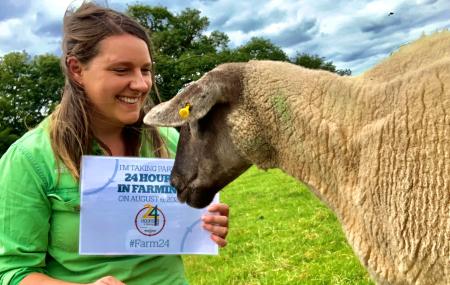
the university offered. I was sold.
So, when I completely flunked my first year of A-levels I was only too relieved to find out that Harper Adams offered a year-long access course onto some of their degree courses – the agriculture degree being one of those. About 6 weeks after receiving my disastrous AS results I was heading up to Shropshire for 5 years which have paved the way for everything I’ve done since.
As part of my degree, it was required for students to undertake a placement year. I wasn’t entirely sure what I wanted to do, so applied to a few companies for more marketing/ people-based roles. Realistically, I’d have hated the office-based role I was applying for and thankfully when I had an interview at CLAAS UK, they clearly realised that and I was offered a role in sales & demonstrations, covering Lincolnshire & Yorkshire. I loved it. It was hands-on and I was constantly visiting different farms.

and I flew out three days after graduation to demonstrate combine harvesters across Australia.

After a few weeks in Australia, I realised that six months just wasn’t going to be long enough. I thanks CLAAS UK for the amazing opportunities but told them I wouldn’t be able to take the graduate role they’d offered me. Instead, I extended my stay, returning home nearly 2 years later.
I was then offered a graduate role with CLAAS UK, but I had my heart set on travelling, so they instead put me in contact with Landpower, the company that owns the CLAAS franchise in Australia and New Zealand,
I’ve worked on the family farm ever since coming home. It wasn’t always the plan. I was torn between travelling more and finding a “proper” job to settle down with. I applied for jobs, but there was nothing I really wanted. I kept finding flaws in the jobs, excuses as to why it wouldn’t work. It took a while for me to realise that it wasn’t the jobs that were the issue for me, it was the idea of leaving the home farm.


We’re a mixed farm in Warwickshire, renting around 750 acres and contracting another 750. The land we rent is a mixture of arable land and permanent pasture. We run around 350 breeding ewes and 85 suckler cows with calves. There are 3 of us working full time. Myself, my dad, Adam, and my uncle, Tom. For me, that’s the hardest part – we have a great relationship but there’s no doubt that working and living together is tough. This strain was only added to when the pandemic hit in Spring of 2020. But despite it all, I knew I didn’t want to leave the farm. I was starting to make my mark, being involved in all the key decisions and bringing new ideas to the business. I started selling our own lamb

direct to local consumers, followed a year later by our own beef too. The majority is still sold through the local markets and abattoir, but our customer base grows each month.
I love the opportunity the meat boxes give me to interact with consumers. I market these on our facebook page, Meriden Farm. Over lockdown we started doing Facebook lives aimed at children to explain why and what we do on the farm. The feedback from this was incredible, plus dad and I thoroughly enjoy doing it. I’ve also built up a following on Instagram, which started when I was documenting my travels. I now document the what, why and how of
what we do at home. Whilst social media definitely has it’s downfalls, I’ve found it a great place to network with and learn from other farmers.
I am a firm believer that no farmer can grumble about the consumers perception of our industry unless they’re willing to address it. It’s a volatile industry, and I try my hardest to represent it the best that I can. We farm to the highest and environmental and animal welfare standards IN THE WORLD – that’s definitely something to shout about!
FollowCharlieonInstagram: @globetrottingfarmgirl


After putting a unique box and bag unloader through its paces, one of the UK's largest suppliers of potatoes has reported a 33% increase in efficiency and a 50% reduction in forklift movements.
AKP Group has revealed the improvements after undertaking a two-month trial of Haith's new QuantaFill box filler at its Elsham site in North Lincolnshire.
Unveiled at Potato Expo in January, the QuantaFill features an innovative in-feed conveyor that gently layers the crop into a buffer bunker, which is then lowered into the box. Active discharge doors then open to transfer the crop into the box, simultaneously raising as it fills. The process ensures that the weight of the box is never lifted and the machine is not put under pressure, which eliminates fatigue or prevents damage to both the machine and the box.
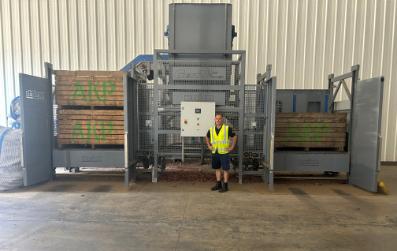
course, I want to be kind to the potatoes; I don't want them damaged. So, from that conversation Haith developed the QuantaFill and asked me if I'd like to put it through its paces.
The additional box-handling functionality allows the operator to place stacks of empty boxes into the machine. The boxes are then automatically de-stacked and transported to the filling module. After being filled, the boxes are re-stacked for the operator to remove from the line.
Founded in 1999 by third-generation potato farmers, Richard Arundel and Bruce Kerr, AKP Group is one of the UK's largest potato supply chain specialists, handling 150,000 tonnes a year across the group. AKP is also one of the UK's largest growers of potatoes with 750 hectares in its farming business.
AKP Group has a long-standing relationship with Haith. The company's operations director, Ben Mordue, has worked with both David and Chris Haith during his 30 years in the industry.
"I often talk to David and Chris about how we want to improve how we do things," says Ben. "One day, maybe two years or so ago, I said we wanted to be quicker and more accurate when filling boxes. We can have up to 25,000 one-tonne boxes on the ground at any one time, and I might need to fill one thousand of them in a day with the smallest forklift movements possible. And, of

"Having used the QuantaFill now for about eight weeks, I can say we are a third faster, maybe more, and we are using one less forklift than before, so it's a significant improvement.
"We have a long-standing relationship with Haith and were involved in the development of their Rota-Tip box tippler, of which we have several on-site here in Elsham, along with two Haith graders and a washer. The QuantaFill continues Haith's track record for innovating – it's incredibly efficient at loading, filling and stacking boxes, has a very small footprint and is four times as fast as a single box filler."
AKP's end-to-end service allows it to supply all sectors of the potato industry, spanning retail, food service and food manufacturing, both in the UK and overseas. Most recently, AKP Group has been using the QuantaFill to empty 1.2-ton jumbo bags of imported potatoes into one-ton boxes for retail packers at a rate of up to 60 tonnes per hour, though Ben believes the machine could run faster if required.
To find out more about the QuantaFill and Haith wider range of vegetable handling equipment, please visit www.haith.co.uk, email sales@haith.co.uk or call 01302 831 911



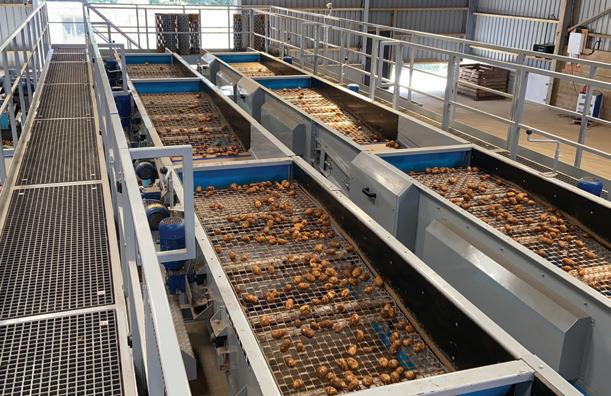


One of the UK's most popular biostimulant brands has cited rising input costs as the reason for a dramatic increase in sales.
MJP Supplies began offering the seaweed-based biostimulant Algifol in reusable bulk containers (RBCs) in February 2023.
In the last six months, the company has seen demand for the 1,000 litre RBCs increase by a third, with average orders topping 6,000 litres per month in the first six months of 2024.
"When bought in an RBC, the cost per litre is just £10, and that's enough to treat one hectare," says Marcus. "The feedback we have received from farmers and our large-scale liquid fertiliser manufacturers which blend Algifol into their products is that the rapidly rising input costs are behind the move to bulk purchases. People are doing everything they can to reduce their costs and save money wherever possible.
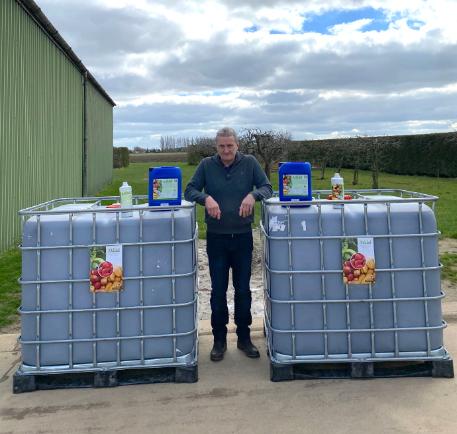
"Like other manufacturers and distributors, we've tried incredibly hard to remain competitive, and thankfully, Algifol's manufacturers have done the same, so the cost of Algifol has not increased this year, which is another factor in its popularity.
"However, the main reason for Algifol's growing popularity is its effect on crops. 2024 has been one of the wettest years in living memory, and when growers have managed to get their crops in the ground, they've been determined to give them the best chance. Aligfol has proven itself over the years to improve crops' resistance to extreme weather, including excessive rainfall."
Algifol is derived from brown algae, which is dried and refined. The result is an entirely natural liquid boasting a wealth of trace elements, vitamins, enzymes, amino acids, carbohydrates, polyuronides and growthregulating plant hormones.
Algifol's manufacturer, Neomed Pharma, says the biostimulant is a natural nitrogen source due to the high presence of amino acids and peptides. This makes Algifol ideal for combined use with reduced amounts of N fertiliser. When used with a reduced amount of fertiliser, Algifol naturally improves the nitrogen use efficiency of the crop, producing a better yield and reducing the use of costly fertilisers.
In addition to RBCs, Algifol is available in one-litre (£ 21.99 + VAT) and 10-litre cans (£164 + VAT) directly from Marcus via his website,www.mjpsupplies.co.uk.
For more information about Algifol or to place an order, emailmarcus@mjpsupplies.co.ukor call 07702 293 727

023 was not an easy season for potato growers. A cold, gloomy and damp summer was followed by 6 months of appalling weather – crops abandoned and early planting nigh on impossible. For the fortunate few with crops securely stored and able to play the market, prices were at levels probably not seen since 1976. Potatoes from Cyprus, almost unseen in the UK in the 21st century, could be found in many markets. Inevitably, the response of farmers to high prices is to plant more next season. For those in the UK, planting more has proved something of a challenge – raining nearly every day through the spring and quality seed hard to find. Surely prices would remain high for 2024.
Elsewhere on the continent, however, planting conditions have proved more benign. Early harvested crops in central Europe have swiftly overwhelmed local demand and prices have fallen fast. Crops in Poland are reported to be a week ahead of normal, and the planted area in France is up 7% year on year. Careful storage of the 2024 crop is likely to be as important as ever.
Store-keepers are now familiar with the need to review every aspect of store management to ensure that they got the best from the more volatile products, such as Biox-M, which have stepped in to fill the gap left by the removal of CIPC:
• Store integrity is essential; fix any leaks;
• Ensure that stores remain closed (and closed means closed) for 48 hours following treatment, and longer where possible;
• Check air (and fog) distribution in store to ensure good and even distribution; an even distribution of fog is essential for good efficacy; address the ‘sprouty’ patches in store;
• Be very aware of the risk of condensation and/or coalescence;
• Relentless attention to detail is always strongly advised.
The focus is now on fine tuning application and store management, so that the return period can be extended for longer term storage. There is still some work on store integrity (Biox-M is unlikely to work to best advantage if is allowed to escape at any time), and distribution of fog in store during and immediately following application. Areas within a store, for which efficacy has been less than ideal, should be identified for improved air
movement, or the use of multiple application ports.
In addition, the sudden increase in energy costs since February 2022 has brought consideration of tweaks to target storage temperatures into focus. Might it be worth storing crop at a degree or so higher and take a big chunk out of the costs of cold storage?
• Is a naturally occurring and truly sustainable product, in widespread use in the food industry,
• Is approved for use on organic potato crops,
• Has no harvest interval or MRL beyond the one-day mandatory withholding period after treatment, and is thus ideal for use on crops for which the date of movement is uncertain
• Has flexibility of timing of application,
• Results in minimal weight loss in store,
• Does not leave persistent residues in the fabric of stores and boxes used for storage,
• And is therefore suitable for use in stores, which may subsequently be used for the storage of other crops or seed potatoes,
• Is effective at higher storage temperatures, reducing the risk of acrylamide development when crop is processed,
• Sequesters carbon during growth, removing 1t of CO2 for every 1,000t of potatoes treated,
• And should be a component of the sustainability plan for every farm and every customer; effectively carbon neutral.
Biox-M is the only 100% natural and sustainable sprout control for potatoes.




The only completely natural product. Stand-alone. Truly sustainable. Excellent efficacy.
Sequesters carbon during growth. Flexibility of timing.
Minimal weight loss in store. Curative and preventative. No MRL.

The

Branston, one of the UK’s leading potato suppliers, has appointed a new general manager at its Lincoln site as part of its ambitious growth plans.
Tanya Leonard joins the Branston team with more than 20 years of experience in fresh produce, having taken on her first management role in sports and leisure at
the age of 17. After gaining experience in a fresh produce production role during what was intended as a stop gap, Tanya then progressed through a number of operational roles thanks to her ambition and drive to continually improve.
Now at the helm of the fresh produce team at Branston, Tanya will be using her vast knowledge and experience to strengthen the team and help the

business to operate more efficiently, as well as maintaining the engineering function and setting up for future development and technology opportunities. Tanya is also a keen supporter of encouraging other women into senior roles in the industry and is looking forward to mentoring the next generation of talent at Branston.
Tanya said: “Branston is a really forwardthinking business and fresh produce is at the heart of the whole operation, so I knew joining the team was an opportunity I didn’t want to miss. I love how fast-paced the industry is and there are some very exciting developments taking place within the business, including the success of the mash and protein factories, so I’m looking forward to getting stuck in and learning more.
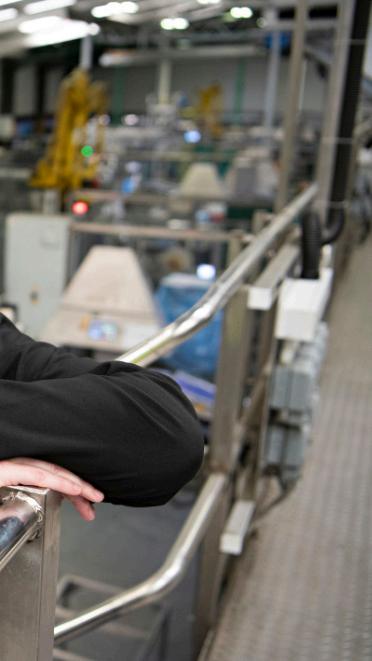
“Helping people grow within their roles is something I’m passionate about, and I’m keen to act as a mentor for others within the business. Having started out at a young age in the industry I know it can be challenging to build confidence, but there is no ceiling for ambitious individuals so I want to do all I can to help young people in the business progress. My daughter has also recently joined Branston as HR administrator after being impressed with the opportunities available, so this is a very exciting time for our family.”
Jim Windle, CEO at Branston, said: “Tanya brings a huge amount of experience in fresh produce and an infectious energy with her leadership style, both of which are going to be a real asset to our Lincoln team, and we’re thrilled she has chosen to join the business. We’re looking forward to her bringing a fresh outlook on operations and helping us as we enter our next phase of growth and vision for continued improvement.”
For more information on Branston visit www.branston.com


Potato Days UK, a new, free-toattend field demonstration and exhibition, will be offering a quality line-up of some 25 speakers in its professional programme of talks and panel discussions. Visitors from across the entire potato production value chain will also be able to view machinery trials and research plots as well as indoor and outdoor exhibits from nearly 100 companies at the event on 4 and 5 September at Nocton in Lincolnshire, hosted byDyson Farming
Former DEFRA Minister, George Eustice, who farms in Cornwall, will join speakers from across the potato industry in a session on policy and practice. The programme session also includes Grace O’Dwyer, HSBC, James Young, McCain and Debbie Winstanley, CUPGRA, who will debate the effect of policy on future practise and how this can contribute to sustainability and efficiency. Mark Taylor, influential industry leader and Chair of GB Potatoes, will lead the discussion. Other themed sessions cover machinery, automation and AI, the impact of net-zero and the effect of climate change on potato growing. Leading academics, potato growers and processors as well as advisors are among the speakers.
“Potato Days UK is a comprehensive –one-stop – deep dive into the latest innovation and research in this essential sector. Our programme of talks and panels offers visitors the opportunity to hear from industry leaders and experts as well as contribute to discussions on the major issues facing potato production in the future. Importantly, visitors will have the chance to network with their peers and make new connections,” says Greg Smith, representative for UK & Ireland, DLG (German Agricultural Society), the creator
and organiser of Potato Days UK.
DLG’s professional programme has been put together by experts from UK Food Valley, GB Potatoes and University of Lincoln and Dyson farming Research.
Held on 20 hectares, Potato Days UK is organized by the DLG together with event partners Dyson Farming, GB Potatoes, the British umbrella organization for the potato industry, AVR, Dewulf, GRIMME UK, McCain, the University of Lincoln and UK Food Valley, the network for innovation in the food industry.
Taking place on both event days, live harvesting demonstrations, crop handling and loading will be demonstrated by event partners.
Selected exhibitors have planted trial plots that feature new technologies in weed reduction, crop protection and inputs, different varieties and innovative irrigation systems. The crop trials enable visitors to inspect crop and agronomy methods in detail.
The Nocton Farm venue is owned by Dyson Farming, an innovative farm company in the UK.
Interested potato cultivation professionals can visit Potato Days UK free of charge when registering in advance. https://potatodays.ticketsrv.co.uk/tickets/
Dedicated to furthering progress in agriculture, the DLG is an international, non-profit society that offers practical platforms - like Potato Days UK - for farming professionals to promote efficient decisions for their farm. The DLG is the organizer of a number of successful trade fairs for the potato industry in Germany, the Netherlands and Turkey.



Two of the biggest names in the UK potato industry will come together at next month's Potato Days to launch a new mobile washing rental service.
Haith and GRIMME UK will showcase the latest specialist, flexible, and high-capacity solution for on-farm washing, the Haith Mobile Washer, at the new industry event to be held at Dyson Farm's site in Norton, near Lincoln, on 4thand 5thSeptember.

"We are very much looking forward to attending Potato Days next month," says Haith managing director Duane Hill. "There are certainly a lot of people talking about the new event,
and hopefully, it will be well attended.
"We will be there alongside GRIMME UK, putting the spotlight on the latest version of our popular Mobile Washer.
"Last year, GRIMME UK offered our mobile washer to selected customers on a rental basis, which proved incredibly popular. In fact, there was so much demand for the service that after GRIMME UK sold the rental unit, they immediately bought a second Mobile Washer so that growers could continue to use it on a rental basis.
"Along with the rental option on our mobile washer, GRIMME UK is helping growers avoid factory lead times by having stock machines available to buy immediately."
Haith developed its first mobile washing system in 1979 to help farmers supplying crisp and chip factories deliver a clean washed sample, free from stones and foreign objects.

Today, the Haith Mobile Washer boasts many innovative features to deliver low cost running such as high efficiency motors and automatic sludge removal to reduce water usage.
Available on a chassis that can be towed by a tractor or HGV, Haith's Mobile Washer features an integral stone separation system and an automatic sludge and floating waste system on the outfeed for the removal of hollow heart potatoes, wood, plastic, or any other foreign material.
To ensure machine longevity and ease of maintenance, a unique shaft sealing system has been designed. This system allows all bearings to be mounted externally, making them easily accessible for servicing and giving them an extended life, unlike other machines on the market with bearings that are running underwater.
The automatic sludge removal system is very effective for keeping water usage to a minimum and containing waste. An HMI touchscreen enables the operator to adjust and control the whole system from one point. CCTV can be fitted to allow the operative to monitor crop flow from the inspection cabin.
Haith and GRIMME UK entered into a strategic working agreement in 2020 to deliver complete solutions to their customers. This agreement

allows them to easily and efficiently source vegetable handling equipment and in-field root crop and vegetable machinery.
For more details about Haith, GRIMME UK, the new mobile washer, and finance options, visit either company at Potato Days or have a look atwww.Haith.co.ukorhttps://grimme. com/en


Tong Engineering, leading manufacturer of advanced potato and vegetable handling solutions, is pleased to announce its participation in the firstever Nocton Potato Days event. The event, which takes place on 4thand 5thSeptember at Dyson Farming’s Nocton Estate in Lincolnshire, is set to bring together industry professionals to explore the latest innovations in potato farming.
At the event, the team from Tong Engineering will be available on stand to discuss the latest potato handling equipment, designed to offer a seamless solution from field to pack. “We are pleased to support this new event, particularly as it takes place so
close to our manufacturing facility in Spilsby,” says Simon Lee, Sales Director at Tong Engineering. “As a field-based event specifically focussed on potato production we are hopeful that the Potato Days event will offer a new platform for us to meet with the industry and welcome them with our local hospitality, while showcasing how our innovative handling solutions are tailored to the evolving needs of potato producers.”
Nocton Potato Days promises to be a significant event for the potato industry, offering over 12 Ha of live harvesting demonstrations and networking opportunities. Tong Engineering will be exhibiting alongside the company’s mobile elevating and conveying

business, Tong SwiftLift, and invites all attendees to visit their stand for a warm welcome and the chance to find out how the latest automated solutions are streamlining potato handling operations with increased productivity and enhanced product quality in mind.
“Dyson Farming’s focus on innovative farming for a sustainable future makes it a great place for the potato industry to come together and we look forward to seeing customers old and new at the two-day event,” added Simon.








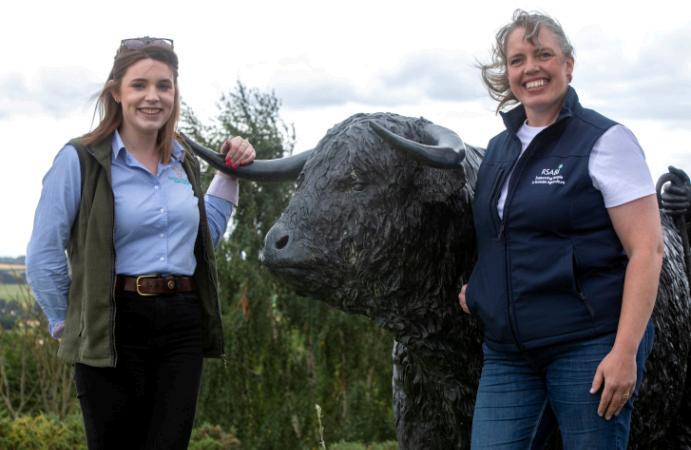




shley Mullenger had never planned to become a fisherman. A chance fishing trip – catching mackerel off the Norfolk coast – was the start of an obsession. One that resulted in a transformation from clean-cut office worker to commercial fisherman, and proud working owner of two boats, Fairlass and Saoirse, alongside skipper Nigel. She is one of the few women working in the industry and was named 'Fisherman of the Year' in 2022. Advocating for better representation and equality in the industry (only 2% of crew members are women), as well as raising awareness of issues the fishing communities are facing,
Fishing is often thought of as a separate entity to farming but should very much be in the same category as they have many parallels including misinformation, climate change, legislation, decline in home cooking, depleting stocks. Farming and fishing are intrinsically tied to biology, to the concepts of ecosystems, the balance of species, and conservation of biodiversity. They are, in essence, intersections of livelihood, sustainability and science. So how can farming and fishing influence the balance among species in ecosystems?
Working with nature is a privilege shared by both farming and fishing communities. Understanding the balance of the ecosystems we are fortunate to work and play a key role in their ongoing health and survival.
The North Norfolk coast is home to the iconic ‘Cromer Crab.’ However, commercial demand for

its delicate flavour has not been as strong as in previous years. As a result, our largest local processor has had no choice but to implement landing restrictions on local boats, forcing them to look to other fisheries to maintain their businesses. This means targeting stocks of whelk that would not normally be fished as heavily at this time of year. Other species of fish are available; however, due to complex licensing issues on bass and the Coast Guard's restrictions on changing fishing methods on boats, these are not easy alternatives to switch to.

We must also ask, are we as a community evolving too fast? Are bigger boats and more pots in the water, fuelled by compensation money from wind farm companies, upscaling small artisanal fisheries into more productive businesses? While this is not the case for all boats, it has played a significant role in transforming some. There is room for research that not


only focuses on shellfish stocks but also on the evolving capabilities of the fleet. Additionally, we need to explore ways to increase the demand for fish caught and produced in this country, considering that we export 80% of all fish caught here.
Brexit policies have led to challenges and changes in the UK's farming fishing industries. These include difficulties with export due to new trade barriers, a reduction in the availability of Labour, as well as alterations to funding and legislation. Both sectors are intrinsically important to the UK's economy and culture, and it is essential that the UK government supports agriculture and fishing to safeguard national food security and reach net zero targets. However, recently Brussels bureaucrats are drawing up a list of 'offensive interests' with reports suggesting London will offer up access to UK fishing waters as part of a trade off in Keir Starmer's 'reset' with the EU. I asked Ashley if this happens, what is the future of fishing in the UK in your opinion?
‘The UK is home to the biggest multi-species fishery in the world, so it is no surprise that the EU is keen to obtain more access to our waters. Despite Brexit, the UK never fully regained control of its waters or quotas. Since Brexit, 1,700 fishing licenses have been issued (for free) to EU-flagged vessels, provided they could show a 'track record' of fishing within our boundaries. Considering the UK has only 4,000 fishing boats left, 80% of which are under 10 meters long,
the addition of 1,700 EU boats in our waters is significant.
Over half of the UK’s fish quota is in the hands of European ownership. While we have the right to reclaim this quota, doing so would have repercussions for other industries that contribute more significantly to the GDP. At the very least, the UK government could have required that all fish caught in our waters be landed in this country. This would have stimulated growth in the dwindling shore-side sectors of our industry, such as fish markets, logistics, coastal employment, and infrastructure.
If the UK grants the EU greater access to its fishing waters as part of a trade reset, the future of UK fishing could face several challenges. Economically, increased EU access may lead to further decline for UK fisheries. Local fishers would face heightened competition, potentially driving down prices and reducing their income. This



economic pressure would be compounded by the existing labour shortages due to post-Brexit immigration policies, likely resulting in more job losses and undermining the viability of local fishing businesses.’
From an environmental perspective, the presence of a larger number of EU vessels could lead to overfishing, threatening marine biodiversity and the long-term sustainability of fish stocks in UK waters. This could force the UK government to implement stricter conservation and management measures to protect these stocks, potentially imposing further restrictions on both UK and EU fishers.
However, this situation could also present an opportunity for reform. The UK might renegotiate fishing rights and implement policies that better support local fishers. For instance, requiring that fish caught in UK waters be landed domestically could bolster the local economy and revive the shore-side sectors.
In conclusion, granting the EU more access to UK fishing waters could have serious ramifications for the UK fishing industry. It is crucial for the UK government to carefully consider these potential impacts and develop strategies that protect the interests of local fishers, support the economy, and
ensure sustainable fishing practices.
As one of the few female commercial fishers in the UK, you are a vocal advocate for women in the industry, using your platform to share your experiences and encourage other women to consider a career in fishing. Why in your opinion is the reason that you are indeed an 'endangered species' and how can we drive change forward?
‘Numbers of commercial fishermen reduce every year, and we are now down to 11,000. The industry has struggled to recruit for many years due to a lack of opportunities for young people and negative perceptions of the work involved. Given the uncertain future, who can blame them? Our sector is being attacked from every angle, with over 50 years of legislation often described as knee-jerk reactions to fisheries management. These "sticking plaster" solutions have led to unintended consequences, segregating the fleet and making diversification nearly impossible.
In North Norfolk, for example, I am limited in the fisheries I can target. Decades-old rulings prevent me from accessing cockles, shrimp, or even bass, which favor our shallow sandbanks. For small-scale fishermen, the ability to diversify into multiple fisheries is imperative for survival. However, we face additional challenges, such as the spatial squeeze from five windfarm sites, three of which are due for further expansion, marine protected areas, seaweed farms, aggregate drilling, and North Sea oil and gas activities. The sea isn’t as big as one might think.
Moreover, the coastguard is making our job increasingly harder with their revised code of practice—a 200-page document outlining the safety standards required for fishing vessels. I find it contradictory and open to interpretation, depending on the inspector's mood, which can leave us tied up, unable to fish, and waiting for approval for months.
Additionally, we face vilification from various groups, including vegan activists with their own agendas, further complicating our efforts.
As one of the few female commercial fishers, my position feels even more precarious. The industry needs to make significant changes to attract and retain new talent, including women. Promoting the importance of the fishing industry, providing better support and training opportunities, and addressing the negative perceptions are crucial steps forward. We must also advocate for more flexible and adaptive regulations that allow for diversification and growth, ensuring the sustainability and resilience of our fisheries.
In conclusion, the future of commercial fishing in

the UK depends on our ability to drive change and adapt to the evolving landscape. By addressing these challenges head-on and creating a more inclusive and supportive environment, we can ensure the survival and thriving of our industry.’
Several initiatives are in place to support small-scale fisheries in the UK; such as the UK Seafood Fund which aims to modernize and improve the small-scale fishing fleet, ensuring long-term sustainability and supporting the industry's transition to greener practices which aim to bolster the resilience and sustainability of small-scale fisheries, ensuring they can continue to thrive and support local communities .But what role do local communities play in supporting initiatives such as this?
‘The FASS funding from the government is a great initiative, and I have been lucky enough to obtain a lobster tank with the grant awarded. This allows me to supply lobsters on demand and maintain a higher price for my catch. There is also a fantastic initiative in the Southwest called the Fishing Animateurs, which supports businesses in obtaining grants and assists with the paperwork and application process while guiding you through what can and can’t be claimed.

I believe that every small community should have a dedicated team to represent their interests properly. This includes not just securing grant funding opportunities but also ensuring that someone represents fishermen’s interests at fisheries management meetings, responds to consultations and marine planning notices, and supports fishermen through coastguard inspections and the MCA’s subsequent consultations.
There are incredible individuals already supporting this kind of work, but we need to empower more fishing communities to come together and advocate for a livelihood under threat. Local communities play a crucial role in supporting these initiatives by fostering a collaborative environment where fishermen can share resources, knowledge, and support. By working together, communities can better navigate the complexities of regulations and funding opportunities, ensuring that the voices of small-scale fishers are heard and considered in policy decisions.
Our local communities are essential in supporting initiatives aimed at sustaining small-scale fisheries. Through collaboration, representation, and advocacy, they can help ensure the long-term viability of these vital industries and the livelihoods they support.’
Ashley has written her memoir of her journey, a life swept up in tides and elements, strength of mind and body, of old ways and new struggles. It's about
the bravery of crews, early mornings, weatherbeaten characters and those that can sink pints as fast as they can haul pots. These coastal communities and age-old livelihoods are built on trust, courage and skill – but they are also fraying against politics, poverty and climate change. The reality of commercial fishing is rarely seen, but Ashley carries us across the waves and around the UK's waters in vivid detail to show what is really happening at sea to land the fish on our plates.
MY FISHING LIFE is both a rallying cry and a love letter, rinsed down with salty humour, to an industry often misunderstood. One woman's unique story of boat, skipper, sea and catch ultimately becomes a transformative view of a world that impacts deeply on us all.
She has built a following on social media: 12.8k Instagram followers and 6k on TikTok. She shows daily life in fishing and encourages others to take up the profession and it’s fantastic! | @thefemalefisherman / X: @FemaleFisherman
My Fishing Life: A Story of the Sea by Ashley Mullenger is out now in hardback, eBook and audio (Robinson, £22)
Written by Olivia Shave

ew to the AD/Biogas industry, Ross Mingotti could have been forgiven for walking away from a plant that had already had major mixing issues in its final storage tank. Within two months of him joining the business in December 2021, one of the paddle mixers in the secondary tank failed.
The mixers had worked well since being commissioned in 2017 at AMPGREEN ESTATES’ Greengill Farm AD Plant (near Penrith, Cumbria, in the far north of England), but now came the problem of retrieving them. This wasn’t possible without emptying the tank; in this case from the final storage tank, which holds close to 3 million gallons of digestate.
“The final storage tank had already been offline for 12 months,” said Ross. “But at least we were still able to run our primary digester, which is the outer ring of the site’s tank-within-a-tank design.”
Jamie Seggie, appointed as AD Plant Manager in February 2022, must have also wondered what he’d walked in to – and then to make matters even worse, the invasion of Ukraine shortly afterwards created a delay in the replacement mixers that had been ordered. As a 2.4MwH plant, supplying power to the grid was a considerable problem in downtime and loss of income.
“After a three-month wait, with still no word on the delivery of new parts,” added Ross, we decided to look elsewhere. Our final storage tank had become

very crusted over, but we managed to get it moving temporarily with a very basic propeller mixer that we could mount on the back of a tractor. We went to ADBA’s World Biogas Expo in Birmingham, where we looked hard at some new mixing systems to see what might suit us.
“Potential suppliers then came to visit, and could immediately see that this was a site in distress, but whilst price always comes into it, Jamie and I knew we needed to feel comfortable with whom we were going to work with, and not be taken advantage of with all sorts of add-on sales. We may have been new to the AD industry, but we were learning fast. It was clear that there hadn’t been much focus on preventative maintenance, but then the original design, with these paddle mixers trapped inside the tanks, made servicing, repair or replacement very time-consuming and costly. Nobody in the business wants to empty the tank. You can’t just then switch it back on and be back to where the plant should be. It takes around 20 to 40 days, and even then, the gas isn’t at its best quality.”
Jamie Seggie, Plant Manager, at Greengill Farm AD Plant, added: “We soon saw large increases in hydrogen sulphide, and unwanted spikes in gas quality, so you’re then having to focus less on the actual digesters and more on protecting the engines. There’s also the knock-on effects of having to do more oil changes. Parts were wearing much quicker on downstream equipment. With a thermophilic system, there are also significant fuel and boiler costs in heating the tank to bring it up to and keep it above 50 degrees C.”



‘We needed a reliable mixing system that could be looked after, major disruption to the process’
“Ross and I knew that moving forward, we needed a reliable mixing system that could be looked after, without such major disruption to the process, and a company that would support us. The challenge facing us and our new supplier was the sheer size and volume of our final storage tank (with tanks partially buried underground), and how to get it mixing properly.”
After very careful consideration, Ross and Jamie went ahead with mixers from Landia.
“We knew Landia had a proven track record, and importantly, that they had people on the ground and spare parts readily available in the UK, so we could get the local support that we needed. It was clear from the outset that they were totally committed to what we were trying to achieve, and importantly for us, everything was flexible. They were open, honest, and listened; not trying to sell themselves as process engineers, but wanting everything to work, understanding that everything is connected; unlike some that just want to come in and say ‘yes, that’s the one bit that we’re responsible for,’ and not seem to care about whether they’ve actually delivered a solution. Likewise, we weren’t oversold to. For example, with the electrics – Landia said they could do it, but that it wasn’t their bread and butter, so if we had a trusted local supplier, then that would be fine.
‘Create several mixing patterns within the tank’
“Again, some suppliers might have tried to sell us as many mixers as possible, but starting with our inner annulus tank (our second digester), Paul Broadhurst at Landia came back with a design of four 22kW submersible mixers. And slightly later, for our final storage (46m by 8m) tank, a total of six mixers (four 11kW, two 22kW), positioned at different heights and running at different speeds and times to create several mixing patterns within the tank, to achieve the desired effect. Now, with the Landia mixers, both of these tanks get mixed properly, but with minimal power consumption.”

From the Penrith site’s 2500 acres, maize, grass silage and sometimes rye or wheat are utilised as feedstock, feeding in at around 104 tons per day, with approximately 8% total solids for the second digester (30m diameter by 8m height) and around 5% total solids for the final storage tank, from which most of the gas is pulled to run the CHP engines. In Ross and Jamie’s steep learning curve, they’ve understood that whilst a higher dry solids content means more gas, it can also lead to a point when the tank can’t be mixed. And to further help the consistency of the tank’s contents, AmpGreen is now ensuring that across the estate, all crops/feedstock are chopped to no more than 5mm, so that everything breaks down properly in the AD process. After using around 15% of the power generated for its own needs at the AD plant, an impressive 85% is sent straight to grid.
‘Always prepared to help’
Ross Mingotti added: “About six months after we’d tried to order the parts from our original supplier, we were finally told that they were ready! – but of course, out of necessity, we’d long since moved on – to a key position now that with preventative maintenance and known factors, we can control our costs. We now have a maintenance contract with Landia for them to service the mixers every six months. Once again, they didn’t pressurise us to take this on or insist it was part of some inflexible deal. They offered to work with and train our own maintenance people, but I have to say that the Landia guys who come here are fantastic. They obviously take a lot of pride in what they do, and want their customers to be happy.
“We can’t deny that during the switchover to the new mixers, it has been fairly complicated and stressful at times (!), but the Landia install team really shone. Things have a habit of changing during a project, but Paul Broadhurst (Landia) and ourselves were always in contact, working together to find the very best solutions, living with the job as it developed – and we still have the peace of mind now, knowing that they care, and will always be prepared to help.”
www.landiaworld.com

armers growing feedstock crops for anaerobic digestion (AD) plants to generate biogas for green electricity should consider growing hybrid barley as a way of spreading workloads and risk, for example in case of poor maize harvests.
That is the suggestion from Syngenta area business manager, Henrietta Wells, who says as growers plan this autumn’s crop choices, Hyvido hybrid barley has a lot in its favour.
“Wholecrop Hyvido hybrid barley offers a flexible buffer crop to supplement maize in AD plants, grown either in addition to or instead of wholecrop rye,” explains Ms Wells.
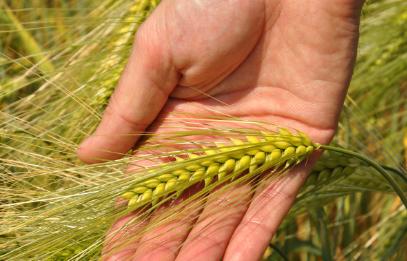
its earlier harvest than rye and certainly than forage maize, she notes.
“In years when maize silage stocks are tight – which is potentially the case this season after many maize crops had a poor start – then more wholecrop hybrid barley can be included as a feedstock to supplement the maize. However, in seasons where maize silage is plentiful, a big benefit of hybrid barley is the flexibility to harvest it later as mature grain, rather than as wholecrop – with barley grain being relatively easy to sell compared with rye grain where marketing opportunities might be limited. Feed mills are used to handling barley, but might not have the separate storage capacity for rye.”
Ms Wells says in numerous trials, Syngenta hybrid barley, with its hybrid vigour, has shown strong suppression of several key grass weed species. Another benefit with wholecrop hybrid barley can be
“An early harvested crop is useful on multiple counts,” says Ms Wells. “Firstly, it provides early access to feedstock for the AD plant. Secondly, it spreads harvest workloads, which can be important if harvester capacity is limited. And thirdly, it allows a longer window for field cultivations and planting a following crop – which is useful if you want to establish an early cover crop,” she adds.
“If you harvest early enough, there’s also the potential to get wholecrop hybrid barley in before black-grass seed has shed – to reduce the amount of weed seed returned to the soil. A common target for wholecrop is to harvest once it reaches 35% dry matter.
“At the start of the season, the flexibility to drill Hyvido hybrid barley before winter wheat or winter rye also provides the opportunity to spread autumn workloads.

“Hybrid rye might produce slightly higher gas yields per tonne, but hybrid barley is a high-yielding crop and the agronomics of growing barley can be more familiar to growers.
“The high-yielding Hyvido hybrid barley, SY Kingsbarn, is a good option for wholecrop for AD, or possibly SY Nephin with its robust disease resistance if looking for something easier to manage. Hyvido hybrids are well proven on-farm for their robust growth habit,” Ms Wells adds.

he German plant manufacturer WELTEC
BIOPOWER is supporting Yarra Valley Water for the refurbishment of its 1megawatt biogas plant in the north of Melbourne. Yarra Valley Water, is one of Australia‘s largest water and wastewater companies. Since the completion of the waste and food waste plant by WELTEC BIOPOWER and its project partner in 2017, Yarra Valley Water’s Aurora Treatment Plant has been energy self-sufficient. In order to be able to operate the plant profitably into the future, it has been undergoing a technical modernization including biological service planned for August 2024. The work of the local team is being supported by WELTEC on site.

The output of the plant, which has two 530-kilowatt CHP units, covers the energy requirements of the biogas plant. The electricity generated is able to power both the facility itself and the sewage treatment plant, with excess energy is exported to the electricity grid. The plant has a processing capacity of 33,000 tons of organic waste from food processors and restaurants to generate around 7,500,000 kilowatt hours of energy per year. Accepted waste includes fats, oils, brewery and dairy residues, fruit and vegetables which are fed into the stainless steel containers. The plant has already won prestigious awards for its technology: These include the Premier‘s Sustainability Award for leading innovation and practice in Victoria and the Banksia Award for Leading in Circular Economy.
At the start of the maintenance work, the tanks will first be completely emptied. In addition, the roofs of the two 3,573 cubic meter stainless steel fermenters and internal plant components such as the agitator technology will be replaced. The plant will then be commissioned and operational management will be secured. The digester contents will be temporarily stored in the storage tank and material can be filled back into the tanks after the refurbishment so the plant can be up and running quickly. This saves resources and costs. In addition, it is easier to restart the biological process when the fermented material is immediately available. Last but not least, the processes also comply with occupational safety requirements, which are a high priority in Australia –especially when emptying and filling the tanks. WELTEC will also provide on-site staff training.

“WELTEC BIOPOWER has been a valued partner in our successful journey with our Wollert Facility. We value their commitment to safety and quality and have leveraged their expertise in mechanical and biological consulting over the lifespan of our facility,” emphasizes Stephanie Salinas, Manager Waste to Energy Services at YVW. “WELTEC can look back on extensive experience with such complex refurbishment projects. We are delighted that we have been able to enjoy the trust of our customers over such a long period of time,” says Vladimir Bogatov, Area Sales Manager Asia Pacific at WELTEC BIOPOWER. With more than 400 biogas plants planned and built worldwide and a strong service department, WELTEC has the necessary level of expertise for such modernizations. This experience is also valued Down Under to ensure that the plant operation remains flexible and continues to live up to its reputation as one of Australia‘s most innovative biogas projects in the future.

aphne Technology, a leading Swiss climate deep-tech company committed to reducing greenhouse gas emissions in hard-todecarbonise industries, is pleased to announce the establishment of its new subsidiary, Daphne Technology SG. This strategic expansion marks a significant step in the company's growth, positioning Singapore as the central hub for its maritime operations in the Asia-Pacific region.
Daphne Technology SG will play a crucial role in the company's scale-up phase, focusing on delivering innovative solutions to mitigate methane slip and other harmful emissions within the maritime sector. Renowned as a global maritime hub, Singapore offers the perfect
ecosystem for Daphne Technology to advance its mission of driving a sustainable energy transition in the shipping industry.
The new Singapore entity will be led byKuldipak Pednekar, who has been appointed Managing Director. Kuldipak, who has been with Daphne Technology since the beginning of 2022 and serves as the company's Head of Marine & Offshore Operations, brings a wealth of experience in maritime operations and business scaling, making him ideally suited to lead Daphne Technology's efforts in this dynamic region. His leadership will be pivotal as the company accelerates its efforts to provide groundbreaking technologies contributing to global decarbonisation goals.

Maintenance benefits All equipment is external and easily accessible. a unique externally mounted mixing system for anaerobic digesters – offering nothing but benefits.
No need for hatches, platforms, ladders & structural support for mixers.
"We are thrilled to establish our presence in Singapore, a critical market for maritime operations and a key region for our growth strategy,"said Dr. Mario Michan, CEO & Founder of Daphne Technology."With Kuldipak Pednekar at the helm, Daphne Technology Singapore SG will drive the adoption of sustainable practices in the maritime industry, delivering cutting-edge solutions that align with our commitment to environmental sustainability and technological innovation."
"I am honoured to lead Daphne Technology SG at such a crucial moment in our company's growth,"said Kuldipak Pednekar, Managing Director andHead ofMarine & Offshore Operationsat Daphne Technology."Singapore's strategic position in the global maritime industry provides us with a unique opportunity to accelerate the adoption of our innovative technologies. I look forward to driving our mission forward, ensuring that we make a significant impact in reducing emissions and advancing

• Rotary lobe pumps • Separation technology
Stainless steel tanks
Agitator technology
Macerating technology
Liquid feeding technology
sustainable practices within the maritime sector."
Daphne Technology's expansion into Singapore underscores its dedication to tackling the global methane slip challenge, especially in the maritime sector. The Singapore subsidiary will be instrumental in deploying the company's pioneering technologies, includingSlipPure™, which significantly reduces methane emissions from ship exhausts, andPureMetrics™, an advanced real-time GHG measurement and optimisation system.
This strategic move is part of Daphne Technology's broader global vision to scale its impact, offering solutions that address some of the world's most urgent environmental challenges. As the company continues to expand, Daphne Technology Singapore SG will be at the forefront of fostering innovation, building partnerships, and reinforcing Daphne Technology's leadership in the global maritime industry.


ith the increasing challenges of changing weather patterns, it’s crucial for cattle housing to provide optimal conditions for animal welfare year-round. Robinsons specialise in designing agricultural buildings that cater to these needs, ensuring durability and adaptability through every season.
Robinsons offer advanced roofing solutions, such as fibre cement roofs, which are not only durable but also excellent for natural ventilation. These roofs are designed to handle heavy rainfall and intense sunlight, mitigating heat and moisture build up inside the building. The use of materials like Light Ridge, which incorporates waterproof PVC and wind guide plates, enhances natural light transmission and airflow, crucial for maintaining a healthy environment for livestock.
Proper ventilation is essential to prevent heat stress and improve air quality within cattle buildings. We utilise innovative systems, which allows for controlled airflow, removing stale air while protecting from rain. These systems, along with options like Open Protected ridges with polycarbonate strips, ensures a balance between ventilation and light, critical for cattle comfort.




The choice of cladding, such as Yorkshire Boarding with specific gaps, is another crucial feature. This not only facilitates airflow but also helps in managing internal temperature and humidity levels, protecting cattle from extreme weather conditions. Robinsons designs often incorporate cantilevered sides, providing sheltered feeding areas that offer easy access for machinery and maintain ventilation.
Understanding that every farm has unique requirements, Robinsons offer bespoke solutions tailored to specific herd needs. Whether it’s adjusting the height of ridges or selecting the appropriate materials, their approach ensures that the buildings are not just functional but also enhance animal welfare and productivity.
Understanding that every farm has unique requirements, at Robinsons we can offer bespoke solutions tailored to your specific herd needs. Whether it’s adjusting the height of ridges or selecting the appropriate materials, their approach ensures that the buildings are not just functional but also enhance animal welfare and productivity.
Credit: Robinsons Group www.robinsons-group.com





ood ventilation is crucial for creating an optimal environment for housed livestock, including dairy cows and youngstock, to maximise their health, welfare, and productivity.
In housing with adequate ventilation, hot, dirty, humid air is removed and replaced with fresh, cool air to create a clean, comfortable environment where animals can thrive.
Under the right conditions, the heat that the animals give off causes air inside the building to rise through a central vent in the roof. This then draws in fresh air through the sides of the building, which is known as the stack effect.
Galebreaker’s weather-proofing mesh screens, like theRollerscreenorBayscreen, provide protection from the elements while still allowing the maximum amount of air to pass through.
However, this does not always provide enough air flow to keep the housing cool and reduce the risk of heat stress or harmful bacteria building up. This is especially true in cattle sheds where the prevailing wind is obstructed, on hot days, or with youngstock, which do not produce enough heat to effectively generate the stack effect.
maintaining a steady flow of fresh, cool air.
Positive pressure tube ventilation (PPTV) systems, like Galebreaker’smechanical ventilation systems, are long tubes that are fitted along the length of a building, with a fan at one end that sucks in clean air from outside.
Galebreaker’sVentTube Coolsystem is designed to push warm, stale air out and bring in clean, fresh air, and at an air speed which creates a cooling effect across the cow. This reduces heat stress by keeping the cattle cooler. Rather than recycling stale air, this system delivers air precisely where it’s needed, directly at animal level. This results in more efficient and effective ventilation compared to standard fan setups.
Economic analysis: Cost-savings with VentTube systems

Mechanical ventilation can help to artificially improve the ventilation and reduce cow temperature but when it comes to fans or tubes, which option is best?
Understanding the limitations of fans for effective shed ventilation
Fans are a popular choice among farmers for improving cattle due to their initial low cost and ease of installation. However, a single fan has limited capacity to affect airflow across a whole building.
To achieve an adequate cooling effect, multiple fans are often necessary, which increases overall energy consumption and operational costs. Moreover, rather than drawing in fresh air from outside the building, fans tend to recirculate air from within. This can exacerbate the spread of airborne diseases by moving contaminated air around rather than replacing it.
This increases the risk of livestock becoming infected with diseases which can have a detrimental impact on productivity and farm profitability.
The superiority of positive pressure vent tube systems for cattle shed ventilation
Effective cattle ventilation systems not only support animal welfare but also enhance farm productivity by
The financial benefits of implementing a VentTube system is significant. Galebreaker’s research found that replacing fifteen fans with just five VentTubes could save farmers up to £33,000 over three years due to reduced energy usage. This figure included the initial upfront investment in the ventilation system.
Additionally, they found that the reduction in respiratory diseases, like BRD, cuts immediate treatment costs and decreases lifetime costs associated with poor animal performance.
With an estimated initial installation cost of £1,500 per tube and running costs of around £653 per year (£1.79 a day), the return on investment is quickly realised, making VentTube not only a sustainable choice but also a financially sound investment.
Conclusion: Why choose Galebreaker’s VentTube for cattle ventilation?
While fans can provide some short-term measures to improve conditions on your farm, optimised solutions like Galebreaker’sVentTube Cooloffer more reliable and consistent airflow, maintaining a comfortable cow temperature range within farm buildings.
Monitoring and improving these conditions are essential for livestock health, reducing heat stress and enhancing overall farm productivity.
To find out more about howVentTube Coolcan benefit your livestock,contact usfor a detailed consultation on 01531 637900.
Credit: Galebreaker Ltd
The Award-winning British manufacturer has recently launched its new Rotary Mower – The Razorback Blade.
Speaking of the new machines emphasis on safety, founder and designer of the Razorback range Martin Lole says;
‘The Blade Rotary Mower has been specifically designed to address safety concerns surrounding power take off shafts (PTO’s) and the ease at which they can be damaged during operation and thus pose a serious safety risk for operators.’

The Blade features a unique semi-mounted headstock which ensures, even at tight turning circles, the PTO is protected from the tractors link arms which are the common cause of damage to PTO’s.
This new design also gives operators the freedom to turn tighter than conventional rotary mowers, all whilst protecting the PTO from damage.
“We are very pleased with the new machine and its ability to preserve the integrity of the PTO shafts which we so often see damaged. To operate a machine with a damaged shaft is not only a health and safety issue, but also a legal one, and in addition can be a costly replacement.”
“It is not uncommon for a damaged PTO guard to further damage the PTO shaft itself and cause
integral damage to the implements gearboxes, which is why it is so important to us not only for the safety of the operator, but for the longevity of the overall machine that we address this issue.”
With an integrated axle design, cutting height can be adjusted on the go, reducing downtime and setup. This one-touch control is further enhanced thanks to the Blade’s semi-mounted linkage allowing operators to adjust cutting height on the go through adjustment of the tractors link arms.
Razorback have also addressed the wear on slip clutches typical of these types of mowers, opting for a free-swinging twin blade system with reduced horsepower requirements.
Compact blade carriers and a hardened short blade design delivers an exceptional cut at reduced power requirements, thus reducing overall wear and tear on the machine. Through clever design of the double skin deck, the Razorback Blade generates significant sward uplift to allow operators to cut at a range of heights, including achieving a taller clean cut conforming to the aviation industry’s long grass policy used to deter birds from airfields.

The Razorback Blade is suited to all agricultural, amenity and aviation operations, and is available for immediate product demonstration. To register your interest, contact Razorback on 01905841123
Lantra is proud to announce that its Farm Safety E-learning Course will be made free of charge from today, Friday 26thJuly 2024, as part of Farm Safety Week. This move underlines Lantra’s commitment to ensuring that farm workers have access to the latest information to keep themselves, their employees, families, and colleagues safe on their farms.
Fatalities and serious injuries continue to remain at a high level within agriculture. The most recent figures show that 38 people sadly lost their lives from April 2023 to March 2024, as well as more than 9,000 people suffering serious injuries in the agriculture, fisheries, and forestry industries.
In light of the Health and Safety Executive decision to move away from routine farm safety inspections, and recognising the importance of training and keeping knowledge of farm safety timely, Lantra is making theirAgriculture Health and Safety: How to Meet Your Legal Responsibilities (ELearning)free of charge for all to access.
As part of Farm Safety Week, an annual campaign dedicated to raising awareness about the importance of safety in agriculture and emphasising the importance of education in tackling health and safety on farms, the Farm Safety Foundation undertook some research with the farming community that found that 57% of those interviewed who were under 40 years old said that they would like more health and safety training. Also, 34% of those interviewed who were over 40 years old

stated they want more health and safety training. This is a promising sign for the agriculture industry, potentially turning the tide on the high number of fatalities and serious injuries that happen year on year.
On the announcement of Lantra’s Farm Safety E-Learning becoming free of charge, Marcus Potter, CEO of Lantra, commented: “Sadly, I receive all too regular notifications of farming fatalities from the same handful of causes, such as falls from heights and crushing by cattle, or falling objects.
“Lantra is committed to supporting the agricultural sector with health and safety training and ensuring that we give farmers and farm workers the knowledge they need to remain safe. Working in support with the Farm Safety Foundation, it is why I am pleased to share that our Farm Safety ELearning is free of charge from today.”
Lantra’s Farm Safety E-learning course has easily digestible modules covering all aspects of farm safety with each module being packed with practical information and guidance. Those who undertake the elearning will also receive a certificate upon successfully completing the course. The course is approximately two hours long, and a benefit of it being e-learning, is that farmers, and farm workers, can learn at their own pace.
Lantra urges all farm owners, managers, and workers to prioritise safety and take advantage of this learning opportunity. Together, we can make farming a safer profession for everyone.

The UK cost of rural crime exceeded an estimated £50 million last year as thieves became more organised and determined, according to new figures from NFU Mutual.
Published today (Thursday 1 August), NFU Mutual's new report reveals that rural crime cost the UK an estimated £52.8m in 2023, up from £50.6m the previous year.
In a sign of the increasing organisation and sophistication of criminals, Global Positioning System (GPS) units were targeted by gangs throughout 2023, causing the value of claims to NFU Mutual to rocket by 137% to an estimated £4.2m. Intelligence shows thieves frequently target several farms in one night before moving locations to steal these highly valuable and portable kits, often revisiting farmyards weeks later to steal any replacements.
The high-tech equipment, typically costing over £10,000 a unit, is used to guide tractors and combine harvesters to improve accuracy. Without it, farmers and agricultural contractors can face severe delays and disruption to harvesting and cultivating work.
Quad bikes and all-terrain vehicles (ATVs) were also top targets for rural thieves, with thefts up 9% to an estimated £3.2m in claim costs reported to NFU Mutual last year. The very nature of farmland makes these vehicles essential to farmers' ability to get around their fields and effectively complete work, making a theft highly disruptive, especially during peak seasons.
However, in a positive sign of the co-ordinated action against thieves, the total claims cost for agricultural vehicles thefts reported to NFU Mutual fell 9% to an estimated £10.7m in 2023.
Livestock theft remained high in 2023, at an estimated cost of £2.7m across the UK. Last year saw a spate of alarming incidents where farm animals were butchered in fields, an upsetting sight for those discovering the gruesome remains that the criminals had left behind. Livestock theft also has a disruptive impact on important breeding lines, as well as being a huge worry for farmers about the welfare and treatment of stolen stock.
Farm animals worth an estimated £2.4m were
severely injured or killed in dog attacks in 2023, up nearly 30% compared to the previous year.
Sharp rises in inflation in 2023 made farming equipment an attractive target for organised gangs and meant each theft cost the rural community more than in previous years. But a co-ordinated response against crime saw a reduction in the number of agricultural vehicle claims reported to NFU Mutual.
To help farmers and rural communities protect their livelihoods from the threat posed by organised crime, NFU Mutual has provided over £1m since 2021 in support for initiatives to tackle rural crime.
In 2023, NFU Mutual became a major funder of the National Rural Crime Unit (NRCU). Formally established last April, the unit is staffed by police officers with experience in detecting and preventing rural crime, with investigative powers to track and intercept stolen machinery and equipment.
Working hand-in-hand with the NRCU, NFU Mutual operates a dedicated team which shares claims data and insight, helps to identify areas at risk and finds theft patterns to assist recoveries. This kind of collaboration saw the National Construction and Agri Theft Team, which sits under the NRCU, seize £3.1m worth of stolen vehicles and machinery in 2023.
And in 2024, NFU Mutual has funded the UK's first livestock theft officer at the NRCU to tackle this upsetting crime.
Hannah Binns, Rural Affairs Specialist at NFU Mutual, said:"All the indications suggest rural crime is becoming more organised, sophisticated and determined in its nature, which is incredibly alarming for people who live and work in the countryside.
"While the overall cost of agricultural vehicle theft fell, thanks to co-ordinated efforts, it is concerning to see the value of GPS and ATV thefts continue to rise, with thieves turning to technology to scope out locations.
"Intelligence highlights these criminals often target several farms in one night before moving locations, then return weeks later looking to steal any replacements.
"Being from a family farm, I know first-hand
that the impact of rural crime goes well beyond the practicalities of farming. It's the unnerving feeling that criminals have boldly staked out and targeted farmyards and fields, often a few feet from the family home. It's also living in fear of repeat attacks, knowing that thieves are always looking for new ways to target rural communities.
"That is why it's so important for insurers, farmers, manufacturers, police and politicians to continue to work together to provide a united response to the challenge presented by both organised criminals and opportunistic thieves.
"We will also continue to support farmers directly to help protect their livelihoods, offer expertise as the main insurer of farmers and provide advice to tackle rural crime."
Figures fluctuated across the UK, with cost rises in Scotland (up 34.9% to an estimated £1.8m) and Wales (up 6.7% to an estimated £2.4m) while Northern Ireland saw a decrease (down 21.3% to an estimated £2m).
A survey of NFU Mutual Agents, who are often embedded in the local communities they serve, found 91% believed thieves were more organised, with 82% percent saying they knew farmers who had been impacted by rural crime in their area.*
Shockingly, 86% of NFU Mutual Agents said rural crime was negatively impacting farmers' mental wellbeing and 77% knew farmers who had been repeat victims.
For more information on rural crime trends and advice on how to beat rural crime in your area download NFU Mutual's Rural Crime Report 2024 atwww.nfumutual.co.uk/farming/ruralcrime/
Join in the conversation using #ruralcrimereport
Twitter - @nfum
Facebook – NFU Mutual
Instagram – NFU Mutual


Leading agricultural parts supplier Kramp has launched a unique twin amber warning light system with wireless synchronisation, which will be available through their dealer network.
Visibility in traffic is paramount, especially when it comes to the often-underestimated size and speed of agricultural equipment. The market for amber warning beacons on agricultural equipment has progressed considerably in the last few years with the increase of oversized tractors and machinery dealing with a growing intensity of traffic.
the safety of agricultural vehicles on the road.
“With a simple push of a button, the driver can select patterns like single synchronised flash or even double flash, all made possible by the wireless connection between the twin beacons,” says Klaas Peter van de Pol, senior category manager for Kramp.

Kramp has taken this one step further, announcing the development of a wirelessly synchronised multipattern beacon set for tractors, which they say will further enhance
“This innovative beacon set, available at local Kramp dealers, is designed to bring more attention and awareness in traffic, ensuring safety on the road.”
The new light system joins Kramp’s existing range of LED work lights, beacons, and light bars under the Kramp brand, which is known for its value for money, Klaas Peter adds. Besides their own brand, Kramp also supplies lighting from established brands like Hella, Cobo, Britax, Sacex, and Nordic Lights through their dealer network.
The Environment Agency is today (21 August) warning property and landowners to be vigilant and secure their premises against criminals who target their land and buildings to dump illegally collected waste.
Networks of organised criminal gangs operating across the country are targeting privately owned property and land, particularly in rural locations, to dump rubbish collected through illegal means.
In 2023, the Environment Agency'sNational Waste Crime Surveyfound 85% of the landowners and farmers who took part reported being affected by small-scale fly-tipping and 20% by large-scale fly tipping. This June,research conductedby the National Farmers Union also revealed 85% of respondents felt the problem of fly-tipping in their area had either not changed or become worse in the last five years.
If waste is dumped on privately owned land, it is the responsibility of the property or landowner to clean it up at their own expense.Those affected can face costs of more than £200,000 to clear illegally dumped waste from their premises.
Waste crime costs the economy in England an estimated £1 billion a yearthrough evaded tax, environmental and social harm, and lost legitimate business, with enough waste managed illegally across the country to fill 4 million skips annually –about 34 million tonnes.
The Environment Agency is taking action against these criminals, conducting site inspections and prosecuting guilty parties to the full extent of the law. But it's essential that everyone affected works together to tackle this issue, which is why we are running an awareness campaign to educate, promote behaviour change and drive action amongst society to stop waste criminals for good.
Property and landowners are urged to follow these simple steps to protect themselves against waste criminals trespassing on their premises:
• Check any empty land and property regularly and make sure it is secure.
• Carry out rigorous checks on prospective and new tenants. Property and landowners are responsible for ensuring anyone leasing their property and land complies with regulations. They are committing an offence by allowing waste to be stored on land or property without the relevant permissions. This could leave themliable to prosecution.
• Be vigilant and report any suspected illegal
waste activityto the Environment Agency's 24hour incident hotline: 0800 80 70 60.
Steve Molyneux,Environment Agency Deputy Director of Waste Regulation, said:
"Our environment is a precious resource and one we need to guard now and for the next generation, but there are networks of criminal gangs operating across the country just waiting to spoil it for everyone.
"They may offer owners cash to store waste at their property or on their land, promising to remove it later. They won't. Some don't ask. They break in, dump waste they've illegally collected and disappear.
"Waste criminals need access to places to dump the rubbish they illegally collect – but your vigilance can stop them. Shutting them out of property and land is just one tactic to scupper these rogues."
Country Land and Business Association
President Victoria Vyvyan said:
"Fly-tipping is a crime that is blighting rural communities. Farmers and landowners bear the cost of removing rubbish and they pay on average £1,000 to remove waste. This is not a victimless crime – in some cases they have paid up to £100,000 to clear up other people's mess or risk facing prosecution themselves.
"It's not just litter blotting the landscape, but tonnes of household and commercial waste which can often be hazardous – even including asbestos and chemicals – endangering farmers, wildlife, livestock, crops and the environment."
Waste crime is toxic and causes widespread and significant harm to people, places, the environment, the economy and law and order. These criminals are often involved in other types of serious offending such as those involving drugs, firearms and human trafficking. They use violence and intimidation and make huge profits by not paying tax.
The Environment Agency works with a range of partners including the police, HMRC and DVSA to stop waste criminals.
In September last year, the Environment Agency took the company director of GB Waste Management in Lemington, Newcastle upon Tyne, to court for allowing his waste company to dump asbestos-contaminated waste on farmland.The court ordered him to cover the cost to the landowner of clearing the waste that was not covered by their insurance, a total bill of £32,000.

Cornish beef and sheep farmer James Warwick offers timely advice to improve flock health ahead of tupping.
Mr Warwick suggests that concentrating on ewe nutrition and improving body condition is paramount.
1) “We always like to make sure ewes get a good flush of grass for about three to four weeks depending on body condition. This increases energy levels ahead of what can be a taxing and stressful period for ewes. I also administer a mineral drench or bolus, and treat the flock for worms and liver fluke,” he says.
Part of this body conditioning process is helping ewes to reach an optimum weight ahead of tupping.
2) “We aim for a body condition score of 3 to 3.5. This requires the heavier ewes, post weaning, to have minimal grazing and water to bring their weight down. However, leaner ewes can be provided with better quality grass once they have been dried off. We find that scoring and splitting ewes enables us to manage their diet and optimise their weight before the tup,” he says.

Mr Warwick also seeks to reduce any stresses on ewes ahead of tupping.
Whilst ewes are a clear focus before tupping, the rams need to be fit and ready to play their part too, says Mr Warwick:
3) “Rams need to be fit so an MOT to check everything from feet and teeth to testicles is important to improve performance. Like ewes, we look at body condition and administer a bolus or drench along with a fluke and worm dose. We also tend to have at least a couple of extra rams on farm because it is preferable to having empties.”
4) Flushing ewes, running them through a footbath and giving them space to relax is an important step to increasing conception rate. It is the same for rams that will be working for up to seven weeks, so providing a good gap between any treatments and other work can help to reduce stress,” he says.
The tupping period is often debated, and Mr Warwick believes that the use of teaser rams 14 days before at a suggested ratio of one per 100 ewes. This will tighten the lambing period, with most ewes served at either 18 or 25 days after the teaser is first introduced.

5) “We use teasers for the earlies as oestrogen levels start to increase when the daylight hours of autumn reduce. We find that about 75 percent of our lambs come in the first two to three weeks which is a big help to our lambing preparations and the organisation of other work on the farm,” he concludes.
First vaccine proven to protect calves against Cryptosporidium parvum from the start of colostrum feeding
MSD Animal Health (a division of Merck & Co., Inc., Rahway, N.J., USA (NYSE: MRK)) has announced it has received Veterinary Medicines Directorate (VMD) approval for the first vaccine in Great Britain to protect cattle against the highly infectious parasite that causes cryptosporidiosis, one of the most significant gastrointestinal diseases in cattle.

BOVILIS CRYPTIUM® is indicated for the active immunisation of pregnant heifers and cows to raise antibodies in colostrum against Gp40 of Cryptosporidium parvum.
“MSD Animal Health is proud to offer this innovative vaccine – a new, science-driven way to combat the devastating parasite C. parvum, which impacts Europe and the rest of the world,” said Philippe Houffschmitt, DVM, MBA, associate vice president of the global ruminant business at MSD Animal Health.
“This novel vaccine offers preventive neonatal protection, which can help preserve cattle well-being from the earliest days of life, as well as help contribute to global food production and safety.”
According to Dr Kat Baxter-Smith, veterinary adviser with MSD Animal Health, C. parvum is the most common cause of infectious scour in the UK.
“Cryptosporidiosis is widespread on UK dairy and suckler cattle units and is prevalent throughout the year. The disease is mostly seen in calves 7-14 days of age, but can strike at anytime,” she said.
“Infection with the parasite causes blunting of the intestinal villi, reducing capacity for nutrient and water absorption. This has a significant impact on a calf’s future productivity. In a recent UK study2, cryptosporidiosis in the first 16 days of life significantly reduced weight gain over a six month period, with severe disease calves weighing 34 kg less on average than low disease calves. This equated to a £161 reduction in the calf sale price.”
this fortified colostrum.
The primary vaccination course is two doses (4 to 5 weeks apart, in the third trimester of pregnancy. To be completed at least 3 weeks before calving). Cattle that have had the primary vaccination course only need a single booster dose during subsequent pregnancies.
“The protection of calves depends on adequate ingestion of colostrum and transition milk from vaccinated cows. It is recommended that all calves are fed colostrum and transition milk during the first five days of life. At least three litres of colostrum should be fed within the first six hours after birth,” said Dr Baxter-Smith.
BOVILIS CRYPTIUM® can be administered to

cattle during late pregnancy at the same time as the BOVILIS® ROTAVEC® CORONA vaccine.
Vaccinating pregnant heifers and cows with BOVILIS CRYPTIUM® can provide protection for calves from birth at the start of colostrum feeding –when they are most vulnerable. Active immunisation raises antibodies in colostrum against C. parvum, which will help to reduce clinical signs (i.e. diarrhoea) when calves are fed
“BOVILIS® ROTAVEC® CORONA boosts antibodies in colostrum for other important infectious scour pathogens; rotavirus, coronavirus and both E.coli F5 (K99) and F41. Calves gain protection against these pathogens by drinking the fortified colostrum from their vaccinated mothers,” she added.
Detailed conditions for the use of BOVILIS CRYPTIUM® are described in the Summary of Product Characteristics (SPC). Farmers interested in the new BOVILIS CRYPTIUM® vaccine should contact their veterinary professional.
The importance of the show circuit as a ‘shop window’ for breeders to promote top quality cattle has again been highlighted with the news that two high achieving Simmental bulls through the 2024 summer have been sold in respective private deals.

At the 2024 Simmental English National Show, held within the Royal Lancashire Show, the January 2023 born Simply Peter Pan from Robert, Louise, & Margaret Fitton, Moss Hall Farm, Lostock, Bolton, won the Male Championship, Junior Male, and Overall Junior titles in front of the judge Stewart Stronach of the Islavale Herd in Keith, Banffshire. Seeing this stylish bull at first hand was fellow exhibitor Sam Steggles of the Wacton herd, Fieldings, Honingham, and further to family chats, and discussions, a deal was done with him being sold for £11,000 and joining the Wacton team when heading back to Norfolk following the show!

and no gut, carries a +9 figure for Maternal (Milk), and is +109 for Self-Replacing Index.” Continuing he went on to say: “We’re over the moon that Simply Peter Pan is going to Sam and his noted Wacton pedigree herd. When a pedigree man comes and buys an animal that you have bred it’s just great and there’s a little added bonus as you know that his name will appear on certificates for years to come. We wish the Steggles family every success with him.”
Come the autumn and Rob Fitton will be taking two half-brothers of Simply Peter Pan to the Stirling Simmental Bull Sale in October.
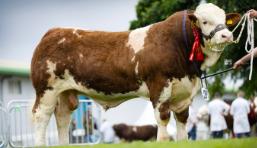
Commenting, Sam Steggles said: “We hadn’t gone to the show with the view of buying a bull but we saw Simply Peter Pan being unloaded at the Royal Lancashire and just liked him a lot straight away. He’s a modern Simmental bull with length and shape, very clean, is good on his legs, and has a lot of breed character. There’s proven breeding behind him and he’s got very good performance figures. We’re delighted to get him and excited to see his progeny in due course.” Joining the 50 head Wacton herd, the initial aim is to take some semen from the bull before putting him to a handful of cows in the backend, and with him put to more cows come next Spring having settled in.
Full of Northern Irish breeding, Simply Peter Pan is by Ashland Magic and is out of Derrycallaghan Kitkat (ET) who was bought at three months of age from breeders H C Stubbs & A A Burleigh, Ballindarragh. Kitkat herself was Junior Champion at the Simmental Calf Show in 2019 at Borderway Agri Expo, and with her dam Corskie Vesna being a top breeding female with many of her progeny being sold at Stirling bull sales.
For the ten cow Simply herd it was a terrific couple of days with the Simmental English National Show prizes being the ten-cow herd’s highest awards to date, and followed by a private sale to a pedigree herd. Speaking afterwards Rob Fitton said: “In the run up to, and through the show, we said that we thought this bull is the full package of looks, breeding, and performance. His sire was bought for length, colour, and figures, and his dam is a thick set cow. He’s clean with width, end,
The second private sale has seen Strathisla Pentagon, from Strathisla Farms, Blairgowrie, Perthshire, head south when selling to the Denizes Herd of MA Barlow & Sons, Near Leyland, Lancashire, and this time for £10,000.
This April 2023 born bull stood first in a strong class at the Royal Highland Show when judged by Michael Durno of the Auchorachan Herd, Glenlivet Ballindalloch. With some breeding connectivity, Strathisla Pentagon is by Denizes Logic 20 VG89, and is out of the Dirnanean Grafter 15 EX93 daughter Strathisla Jitterbug’s Haka VG85.
Commenting on this purchase, John Barlow said: “This bull just caught my eye for the tremendous length he had coupled with his power and weight for age. His sire comes from a strong female line that we obviously know very well, and he’s got some tremendous performance figures behind him. We think he’ll be a good fit with daughters of our primary stock bull Corskie Nutmeg, and we’ve already used him on Denizes Hamish heifers.” Corskie Nutmeg was also purchased privately, following last year’s Royal Highland, for £32,000.
With exceptional performance figures, Strathisla Pentagon is in the breed’s top 1% for both Self Replacing and Terminal Production Indexes, the top 1% for 400 & 600 day growth, top 1% for Eye Muscle, and is +9 for Maternal (Milk).
This is the second Denizes Logic 20 bull that the Strathisla herd have sold privately recently and with a further seven sons, the first crop to be offered at sale, heading to Stirling in October. Of Denizes Logic 20 and this private sale, Strathisla Farm’s Adrian Ivory said: “We’re delighted with Denizes Logic 20 and he’s breeding very consistently and to a type. His progeny have length, shape, are easy fleshing, and with great daily live weight gains from birth. We’re really delighted with the sale of Strathisla Pentagon to a noted herd like Denizes.”
The next generation will be at the heart of this year’s Dairy Show with a full schedule of competitions and seminars focused on building a bright future for dairy.

Returning to the Bath & West Showground on 2 October, the show will host some of the UK’s finest dairy livestock, welcoming past, present and future generations of talent and class.
Exhibitors will travel from all over the country to compete in a variety of breed classes before respective champions go head-to-head for the sought after Supreme Champion title. But before the title is bestowed, the ring will host the next generation of handlers in the Showmanship classes, including age groups 7-12, 13-17 and 18-26. This, followed by the calf classes, will be a chance to spot a few new showing stars.
The Dairy Show will also once again be the venue of choice for the UK Jersey Cattle Society’s and the English Guernsey Cattle Society’s National Shows. To that end, competition entries will open in early August to all classes.
Demonstrating the sector’s breadth of knowledge and innovation, a showcase of the latest technologies, services and advice will also be on offer – enabling discussions and collaboration which capitalise on opportunity, build resilience, and help prepare for the future.
With the future in mind, the Dairy Show is proud to announce its ‘Careers’ theme for this year’s seminars – aiming to take a holistic approach to the industry’s growing need for new minds, perspectives and appetites. “The dairy sector – and the industry as a whole – has a wealth of career prospects,” says head of shows, Jess Chiplen.
“But despite there being an extraordinary breadth of careers, young people and those looking for new career opportunities have often expressed that they are at a loss of where to go for advice, how to get their foot in the door – or even afford a career change.
“With so many businesses and key stakeholders present at the show, it felt like a prime opportunity for us to tackle the careers topic and work towards dismantling barriers.”
Furthering its reach to young people who reside outside the farm gate, the show will launch its Dairy Discovery Day – linking farming with STEM (science, technology, engineering and mathematics), with its pilot interactive careers tour taking place at the show.
“As we continue to broaden our education horizon, we are excited to be launching a new initiative to the Dairy Show, specifically aimed at key stage two students who are beginning to explore possible career paths, ”says shows and education co-ordinator, Lilanie Self.
“The career choices are limitless, and we are passionate about providing a platform to raise awareness of the breadth of opportunity within agriculture.”
Advance tickets to the Dairy Show are available at £20 per adult, increasing to £25 on the gate. Students, with proof, will have discounted entry at £15 and children under 15 years old will have free entry.
• Find out more and book tickets at www. bathandwestdairyshow.seetickets.com/ event/the-dairy-show/bath-westshowground/3079678
• Enter competitions at www. bathandwest.com/the-dairy-show/ competitive-entries


heep farmers looking to hit spring market premiums in store lambs and reduce supplement feed costs will benefit from controlled supplement feeding, says Gerard Roney of Advantage Feeders, formerly known as 3 in 1 Feeders.
“The most effective way to optimise both your lamb and homegrown forage performance is by little and often feeding a small amount of starch feed such as cereals or pellets throughout the day,” explains Mr Roney. “By controlling the intake of supplemented feed, rumen conditions are stabilised and microbes develop to improve digestion and feed utilisation.”
Working with a 3-way restriction system that controls the height, width and depth of where feed sits, farmers can control feed intakes and provide it in little and often quantities with Advantage Feeders.
pasture while maintaining growth rates.
“Store lambs require around 3.5% of their body weight in dry matter per day, with forage requirements quickly increasing as they get bigger. The ability to maintain growth rates on fewer feed inputs gives producers a lot more management scope to increase stocking density and to make selling decisions based on market conditions and not forage availability,” says Mr Roney.
These efficiencies are achieved as a result of optimising rumen conditions for improved digestibility and feed utilisation. According to Mr Roney, the added supplement increases microbial populations and decreases rumen passage rate to increase the energy extracted from feed stuffs and lower forage intake – making it a better supplementation option for both economic and flock health benefits.
In an Advantage Feeder farm trial, it was found that livestock grazing dry pasture require 45% less supplement through the controlled little and often system compared to trough feeding every second day.

“In a restricted setting, stock requires saliva on their tongue to lick the feed. Stock can only feed for about five minutes until their saliva dries up. They will then go graze for about an hour before repeating the process,” explains Mr Roney.
This method of controlled supplementation has been found in farm trials to decrease the consumption of growing grass by one-third, while maintaining growth rates, allowing for a stocking density increase by 50%. Increased rumen efficiency has also been shown to decrease supplementation intake by 33% when grazing dry
“Traditional supplementation methods such as ad-lib feeding or once a day feeding lead to overconsumption of high starch feed in a short amount of time, which throws off rumen pH and kills off rumen microbes. This can take 24 hours to stabilise and for microbes to rebuild and return to digesting pasture,” explains Mr Roney. “Best case scenario, there’s an unnecessary amount of feed consumed to fill the energy gap caused by the rumen not fully utilising forage. The worst case scenario is losing stock to acidosis.”
While pasture is the cheapest form of feed on farms, quality will decline towards the end of the grazing months and over winter. Strategic supplementation will yield a ROI by stretching forage stocks and filling nutritional gaps.
“Along with providing additional energy to growing lambs to help hit finishing weights for early spring markets, controlled supplementation is going to support rumen function so poorer quality forages are more efficiently digested,” concludes Mr Roney.

cotland’s largest family run dairy open the sustainability dialogue between the Scottish Government and farmers around the country
Graham’s Family Dairy has hosted a pivotal meeting between the Scottish Government and key stakeholders in the dairy industry, focusing on sustainability in farming and the path to achieving net-zero emissions.
Jim Fairlie MSP, Minister for Agriculture and Connectivity, attended the meeting yesterday (14 August) which was initiated by the dairy’s Sustainability Manager with the aim of giving Graham’s’ farmers and producers a platform to voice their views on the challenges and opportunities in the quest for sustainable farming practices.

and continues to evolve.
The attendees were made up of Graham’s Family Dairy farmers and producers, spanning from the north east to the west coast, who came together to hold constructive discussions with the MSP about the future of sustainability for Scottish Farming. The meet gave attendees the
opportunity to hear from a mix of people from a farming background about the challenges and barriers the industry is facing when trying to reach the Scottish Government’s ambitious net zero targets responsibly.
Jim Fairlie MSP, Minister for Agriculture and Connectivity, commented:
“I was pleased to attend this meeting to learn more about what our dairy sector is doing to reduce emissions. It is clear that many farmers and crofters are already taking important steps to make their businesses more climate-friendly.
“This is a small part of this government’s extensive efforts to engage with the industry on how we can improve the sustainability of Scottish agriculture. We are determined to continue with this constructive engagement across all areas of the farming sector.”
The day also provided an opportunity to showcase the innovation and progress within the sector, with attendees getting a tour of the new state of the art milking shed. Graham’s Chairman and dairy farmer Dr Robert Graham was also in attendance, discussing sustainability changes he’s seen in the industry as the five generation family business has
Annemarie Keenan, Graham’s Family Dairy Sustainability Manager, said:
“We initiated this meeting to give our farmers a voice in discussions about sustainability and the future of the industry. While the farming community has already made significant progress in improving efficiency and reducing its carbon footprint, continued success requires alignment and cooperation from everyone involved — from farmers to policymakers.
“This was hugely successful and offered us the chance to engage in an open, constructive dialogue with MSP Jim Fairlie, sharing our experiences, celebrating our successes and addressing the barriers that still exist. We hope to continue to identify practical solutions and collaborative strategies that support farmers in their sustainability efforts and help the Scottish Government reach its ambitious climate goals. Our focus is on creating a sustainable future for the dairy industry, where our practices are environmentally responsible, economically viable and socially sound.”
Discussions during the meeting explored innovative approaches to sustainability, streamlined processes, and the necessary support mechanisms that could drive meaningful progress across the sector.
As Scotland continues its journey towards net-zero emissions, Graham’s Family Dairy remains committed to leading by example, supporting its farmers, and ensuring a sustainable future for the wider dairy industry.
Following a successful soft launch at Groundswell last month, Monil – a Norwegian virtual fencing company – is officially launching their offer to the UK market.Withover 4000 collarsinuse inNorwayand the UK, the UK marks the next phase of development for this exciting technology, bringing multiple benefits to beef and dairy farmers across the country.

Used extensively in Norway,New Zealand, the USA, and South America, virtual fencing is relatively straightforward. Each cow wears a GPS tracked collar, which is linked to an app that can be used to define or 'draw' fences wherever the farmer wishes. The collars play ascending audible cues when an animalcrossesa boundary before delivering a small shock, significantly less intense than that of a traditional electric fence, if the animaldoesn't obey the auditory cues.
An initial training period of around a week is required to teach the animals to respondappropriatelyto the collar. During this time,theanimals learn to react to the audible cues alone and move away from boundaries without triggering a shock.
Benefits of Monil's virtual fencing solution include:
• Maximising pasture use and available nutrition: Strip grazing is quick and easy with virtual fences moved at the swipe of a finger on the app
• Protection of endangered habitats / nesting sites: Unlimited virtual fence posts mean fully customisable pastures
• Keeping animals away from dangerous terrain: Exclusion zones can keep animals safely distanced from hazards
• Superior comfort and technology: Monil's top-mounted solar cells and GPS cellular housing means a stronger signal and more efficient charging
• Enhanced biodiversity: Experience shows that by encouraging grazing of less favourable areas, biodiversity is improved when sunlight reaches previously shaded areas
After successful operation in Norway, the UK has been selected as the next step in a global rollout.

The system can be very successful in maximising pasture use and taking rotational grazing to the next level. It can also be used to protect endangered species in environmentally sensitive areas by using exclusion zones within the app.
Torstein Nesse, CEO and cofounder of Monil said: "We are really excited to launch our virtual fencing solution to the UK market. We had some great feedback at Groundswell and some very promising conversations with potential customers, so we are excited to officially launch and meet our next customers.
"Virtual fencing is well established in Norway, and we think the UK is the perfect country to benefit from our experience to date. We have taken time to understand the nuances and differences between Norwegian and British farmers and are confident that our collars willhelp the UK beef and dairy sectors to maximise their productivity and reap the rewards of efficient grazing."
For more information or to request a call to discuss whether virtual fencing works for you, visitwww.monil. co.uk/pages/offer

Farming is a traditional way of life in the Towy Valley but what is the future for farming in a changing climate?
A forum to discuss farming in a changing climate will take place during next month’s Llandovery Sheep Festival. Panelists and guests will discuss the range of issues affecting farming as a result of climate change.
Llandovery Sheep Festival will take place on 14 and 15 September. The Forum will be in the Castle Hotel from 11am on Sunday, 15 September and everyone is welcome to attend to hear the panellists speak and take part in the debate.
Alan New, a member of the Llandovery Climate Action Group, is organising the event on behalf of the Llandovery Sheep Festival. He said, “All around the world people have been experiencing the impact of climate change through unusual, sometimes extreme, weather events. We have seen temperature records broken, huge forest fires, violent storms and flooding. And this is just a taste of what’s to come, we are told. We have always seen examples of extreme weather events and I expect you can all remember some examples that have happened in your lifetimes. But these are now becoming more frequent and more severe. The impact is already affecting food production so communities around the world will have to deal with famine as well as the other catastrophic impacts of fires and flooding.
“Here in Wales we won’t be immune to these effects either. We have previously seen wildfires, record temperatures and flooding events. We’ve just come through a wetter and milder winter and spring than normal, and a grey, wet summer. We can already see that our weather is becoming less predictable and more difficult to manage for food production. So what can we do about it, here in Llandovery?” [More follows….]
Sharing everyone’s knowledge and experience freely between farmers, scientists and academics, environmentalists and concerned amateurs, gives us the best chance of figuring out how to farm in a changing climate. That is the theme of the forum. It will be chaired by Ian Rickman, President of the Farmers Union of Wales.
Llandovery Sheep festival will be a celebration of rural crafts, food and entertainment, held in the town centre. The weekend-long event will also celebrate old drovers’ trails, sheep farming and the wool industry.
Rachel Everett, Chairman of the Llandovery Sheep Festival, said, “Events such as this are important to the agricultural community, not only in terms of bringing people together, but also in terms of showcasing the best of local produce, goods and

services. The concept behind this community-led festival is to showcase the best of Llandovery, to share its cultural identity and historical past through the promotion of the wool industry and the local farming economy. This year’s packed programme will certainly not disappoint and will have something for everyone.”
Alan has brought together a panel of experts from a wide range of backgrounds, doing really interesting and innovative work to cope with the challenges of our changing climate and make our farming and environmental practices more sustainable and resilient.
The town’s Market Square and Castle carpark will be a kaleidoscope of colour during the event in September with almost 100 exhibitors displaying their wares from textiles, arts and crafts to locally produced food and drink. The streets of Llandovery will be packed with entertainment and music.
The pressures facing UK sheep farmers were recognised by new Farming Minister Daniel Zeichner yesterday at the National Sheep Association (NSA) Sheep Event 2024 with reassurance given to the full seminar tent of visitors of his ambition to create a better future for the industry.

Focussing on a sustainable future for the sector, the flagship event of the NSA, taking place at the Three Counties Showground, Worcestershire, attracted prominent names from industry to lead seminar discussions including Mr Zeichner who joined NSA Chief Executive Phil Stocker 'in conversation' for the NSA Breakfast Club Live.
The Minister took questions in the session stating that he welcomed the opportunity to listen and learn from an event full of farmers, more knowledgeable than he about the sheep sector in particular. With concerns raised of the future of the Sustainable Farming Incentive (SFI), food security, sheep health and the rewilding agenda, the seminar provided much for both the audience and the Minister himself to take away for further thought.
Phil Stocker comments:"I have been impressed by the level of interest Mr Zeichner has shown in his time as Shadow Minister and since his confirmation in post following the general election. The opportunity to speak with him to highlight the serious issues facing the sector was incredibly valuable and it was encouraging to hear reassurances given that seem to place him on the same page as NSA concerning several issues. NSA thanks Mr Zeichner for joining us and now look forward to working with him to ensure the voice of the UK sheep industry continues to be heard loud and clear."
A main topic of discussion was the SFI where Mr Zeichner asserted that the Labour Government would not overturn progress made with the new scheme by the previous government but he recognised that there were issues with it that would need to be rectified, in particular to those farming in upland areas. The need to ensure future support is tailored to individual farmers' circumstances was also emphasised.
Continuing the early buzz from the NSA Breakfast Club, NSA was excited to use the occasion of NSA Sheep Event to launch its new report'Sheep Farming and the Sustainability Agenda'that brings together evidence to demonstrate the UK sheep
industry's positive role in sustainable agriculture, identifying what more can also be done to progress the sector and further improve its credentials.
The report was welcomed by another packed seminar tent featuring speakers Phil Stocker, Dr Jude Capper from Harper Adams University, with whom NSA has produced the report, and case study farmers, Cumbrian sheep farmer Will Rawling, and Powys sheep farmer John Yeomans. Visitors were clearly interested by what the report can do for the future of the sector. A copy of the new report can be on the NSA website atwww. nationalsheep.org.uk/our-work/policy/.
With many farming enterprises facing some level of change the third seminar of the day, chaired by NSA Cymru /Wales Region Chair Caryl Hughes,

discussed how to manage business reform with positive solutions. Identifying that just by visiting events such as Sheep Event farmers were taking positive steps forward, the first speaker was Neil Adams who has recently overseen the production of the Farm Business Survey for Promar International. Neil left the audience with three keys beneficial pieces of advice; To pursue productivity, to optimise support and to plan success. Second speaker Mark Suthern, Chair of the Farming Community Network (FCN) as well as many other industry accolades was well placed to speak on coping with change assuring the crowd to give change a chance and not to be bogged down by things out of their control.
The session was brought to a close by North Devon Sheep Farmer Liz Griffiths encouraging others to find their 'sweet spot' by considering their own circumstances when deciding on their business and personal aims. Having been part of the SFI pilot alongside husband Bryan, Liz shared their experience facing the changes this had brought about.
Varied market opportunities and methods to drive these forward were the topic of discussion for the final seminar of the day.
Chaired by NSA Policy & Technical Committee Chair Kevin Harrison and featuring Awal Fuseini, AHDB, Phil Hambling, ABP and Emyr Owen, Rhug Estate, the seminar gave attendees advice on how to develop successful markets themselves as well as providing them with information on current work being undertaken to overcome challenges and create further opportunities by the wider industry and trade organisations.
The session brought the seminar tent to a close with an animated Q&A on future trade and its impact on the UK sector.
A recording of the NSA Breakfast Live seminar, sponsored by Roythornes Solicitors and featuring Farming Minister Daniel Zeichner will be available to watch again soon on the NSA website.
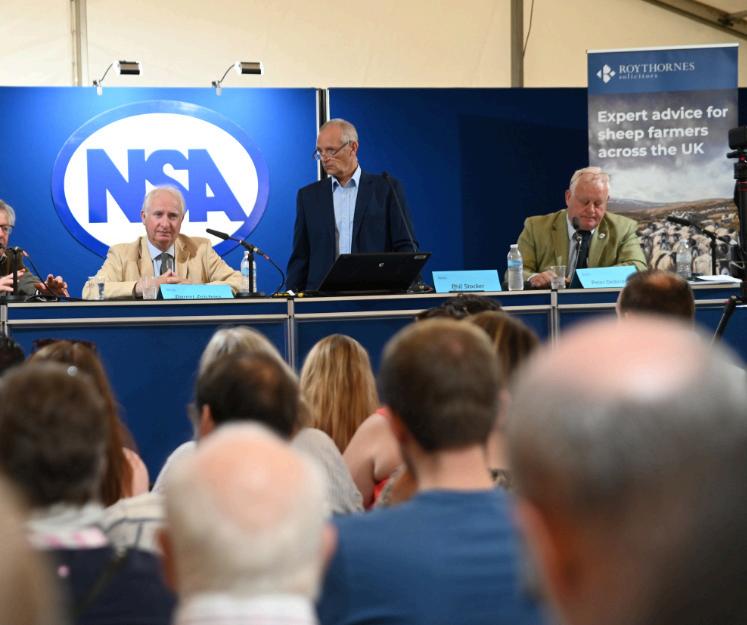

With robots accounting for an everincreasing proportion of newly installed milking systems in the UK, ForFarmers are leading the way with their Robotic Forum event.
To be staged at Sandy Park Conference Centre, Exeter on Tuesday 24 September, the event brings an impressive line-up of technical speakers, coupled with the opportunity for farmers to speak to manufacturers and other product and service providers.
Bas van Santen, UK Robotic Product Manager at ForFarmers, said: "The Robotic Forum brings together experts from across the industry, as well as trade stands to view the very latest developments in the sector.
"We have brought together robotic specialists under one roof to provide guidance to this growing market. Whether you are considering installing robots, or you are already milking in this way and wish to drive performance, the Robotic Forum will offer information for those at every stage of conversion."
A free of charge event, the day will consist of five speaker sessions, commencing at 10am who will cover topics from foot health to genetics. There will
be chance to speak with trade stands beforehand from 9am, at lunch and again after the sessions conclude at 3pm.
Technical speakers:
• Nick Bell, Director, Herd Health ConsultancyFoot health in robotic systems – thinking outside the box.
• Ivor Davey, Director, Cow Plan Ltd - Planning the best possible layout for a robotic systems
• Liam Healy, Genetic Services Manager, Genus ABS - Quick gains in a robotic system from the right genetics
• Bruce Forshaw, Product Manager, ForFarmers - What your cows will be telling you about your robotic set up
• Bas van Santen, UK Robotic Product Manager, ForFarmers Driving performance and efficiencies from your robots
Bas said: "We look forward to an informative day at Exeter where we will really get to grips with what makes a successful robotic set-up."
The event is free to attend but please book your place atwww.forfarmers.co.uk/roboticforum

ince announcing last August that she was going to attempt a world record, Scottish female sheep shearer Una Cameron has been on a strict exercise and dietary regime under the guidance of personal trainer Matt Luxton, who has trained over ten World Shearing record holders.


Una’s World Record attempt will take place on Wednesday 7thAugust on the farm of British Wool Ambassador and World Record holder Matt Smith in Cornwall. The challenge before Una is to shear more than 458 ewes in 9 hours. The current World Record was set on the 9thFebruary this year by Sacha Bond in New Zealand. She bettered fellow Kiwi shearer Kerri-Jo Te Huia’s record (452) of six years standing, by six.
Over the past three decades Una has worked in a predominately male profession and has more than held her own. Following her shearing season in New Zealand, during the Scottish winter months, Una has been working with Matt Smith before she came home to the Borders for her own shearing run.
Since the record was announced, Una has had a management team working behind the scenes, fund raising and organising all the detail, so she can focus on her shearing and training.
On her upcoming World Record Una said: “I have always wanted to attempt a World Record and after over a year of preparation, I’m only a matter of weeks away. It was good spending time
down South working mainly on Poll Dorsets, but the weather has made it very challenging for both me and the sheep this year with the constant rain and it’s been so cold.”
Una continued, “I came down to Cornwall on the 19thJuly to work on Romney ewes before the big day. To beat the record by one, I will have to average a minute and nine seconds a sheep all day.”
Preparation for any shearing record is key especially a World Record and Una’s preparation includes regular exercise lifting weights three days a week, doing mobility three days and cardio on a Sunday. “I’ve just started using an ice bath – OMG – the first time I lasted a minute and was watching every second tick by! I’ve now coped with two minutes. It apparently aids recovery, but I’m not convinced!”
“The diet has fancy recipes, which I don’t have enough time to make, but basically if it swam, walked or grew in the ground, I can eat it. But unfortunately, you can’t throw a Snickers bar in the air and say it flew!” she jests.
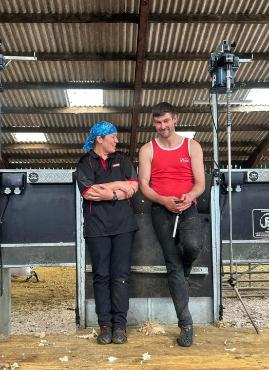
Richard Schofield, Shearing Manager, British Wool said: “Una is an experienced shearer and her knowledge and experiences of shearing will I’m sure put her in a strong position as she attempts her World Record.”
“As a member organisation, British Wool are totally committed to supporting the high quality shearing we have here in the UK and are delighted to be supporting Una to help her achieve her goals and wish her the very best of luck.”

or twelve years, theBritish Farming Awardshas shone a light on the best in British Farming. During this annual event Britain's farming industry comes together to celebrate the achievements of its contemporaries.
The 2024 Dairy Farmer of the Year finalists have been chosen because they are excelling in their field. The judges look for the entrants to be exploring new ideas and opportunities, shaping their businesses to become more robust, sustainable and adaptable in an ever changing sector. Whether they are small scale dairy units or family-run farms, they are all using progressive technologies to improve efficiencies or developing their systems into a niche with challenging conventional thinking.
Proudly introducing the 2024 Dairy Farmer of the Year Finalists
Tom & Karen Halton - Halton Farms Ltd
Tom and Karen Halton, along with their experienced team, farm at Chance Hall Farm, Congleton, Cheshire. The farm is home to 500 ProCROSS dairy cows, producing average annual yields of 11,800 litres, with milk sold via their platform, The Milk Shack.
Tom is a second-generation farmer; his father became a tenant farmer on the Rode Hall Estate in 1968, working alongside the landlord to start the Rode Farms Partnership. Tom joined this partnership in 1989 and grew the business alongside Sir Richard's son, Randle.
In 2012 Tom and Karen formed Halton Farms Ltd growing the herd to full strength and launching The Milk Shack in 2016, selling raw milk from a vending machine.
Since its creation, The Milk Shack has developed its offering to include pasteurised milk, milkshakes, cheese, eggs, cakes, butter and much more. Tom and Karen use this as an opportunity to engage with the public, the couple commented, "this allows us to connect with a wider audience, helping to dispel the negative information about UK agriculture and develop positive relationships with the local community." Furthering their community connections, the duo has a 'Moobile' Milk Shack which attends local events and food festivals. In 2018, the team started farm tours
for schools, colleges, universities, Cubs, Scouts and organisations to give people a real view of dairy farming.
Keeping in mind the industries Net Zero targets, Tom, Karen and their team have implemented numerous tactics such as improving soil and nutritional erosion by sewing short-term grass leys after maize harvest making them less reliant on buying in feed. The team are working towards completely removing soya from the total mixed rations by the end of 2024 ensuing they are using protected feeding ingredients.
Alongside reducing waste and ensuring supplies are from sustainable sources, their milking herd is housed indoors, meaning they have more tons of dry matter farmed per hectare, which is immediately followed by slurry, meaning they use less fertiliser.
In 2014, Harry became a partner and took over the running of his family farm in Thornley-withWheatley, nr Preston. Since Harry joined the business, he has had a significant impact on increasing milk yields and improving the farms' carbon footprint.
When Harry joined the business at Lyme House Farm it was lambing 400 sheep and milking 120 cows. Over the past 10 years, Harry has invested in new machinery, ensuring his team can do everything in-house. He has built a new rapid exit parlour which has contributed to rising milk yields and better time management for his team.
Today, Lyme House Farm milks 470 cows twice a day, with milk sold through Arla cooperative on a contract with Tesco. Harry works with an independent nutritionist to create the feed, which includes wholecrop, ground maize, concentrate blend and grass silage ensuring his herd has the best diet it can. With herd health always in his mind, after milking, the cows leave the parlour and walk through a Hoofcount (2024 BFA AgriTech Innovator of the Year Finalist) footbath containing a copper sulphate solution. Since its installation they have seen a significant drop in lameness and digital dermatitis is almost non-existent in the herd.
Harry has a strong focus on improving the
environmental impact of the farm to ensure the longevity of the industry in the UK. In previous years, Harry had been struggling to meet targets in the farm's carbon footprint audit due to buying in maize to feed the cows. In 2020, Harry made the decision to invest in neighboring Knott Farm and acquire the tenancy for 220 acres a short distance away. This enabled them to grow and harvest more of their own crops and move to a more foragebased diet, in turn reducing their carbon footprint. In addition to this, Harry has planted a 50-acre site with trees reducing the farms' C02 emissions further.
The Jersey breed has been a passion for Oliver for over 20 years. At the age of 31, he sold his drum kit to release the funds he needed to purchase his first 2 cows, fast forward to the present day and Attwoods Drove Farm, Winchester is home to 280 cows primarily bred by Oliver himself. Calving all year round and using sexed semen has helped build his herd, with beef genetics being introduced minimally to supply the farm shop. Hiltonbury Jerseys is a family run enterprise, Oliver's wife and stepdaughter and integral to the operation.
In 2016 Oliver broke the mold by investing in a milk vending machine, one of the first farms to take the risk. Due to milk prices fluctuating, the ability to sell milk straight to the customer through his wife's farm shop was key to the farm's success.Oliver states that 'without these changes being made they would no longer be in the dairy industry'.
In 2019 Oliver moved to his current farm and invested heavily in its infrastructure, installing a new Dairy Master milking parlour and a pasteurisation room. Not only did this seriously reduce milking time, but it saved time, money and increased the farm shop offering through the pasteurisation process.
Alongside raw and traditional milk, the farm shop sells homemade traditional Jersey ice cream, Jersey fudge, Jersey beef, free range eggs and has expanded into county wear and equine goods this year. Diversification is key to the farm's success, with events such as food and craft festivals, pumpkin parties and small open days helping to encourage the public to learn about the farm, which is all shared through their Instagram page.
Environmentally, Oliver has planted new hedge rows around the farm to support the wildlife. The loose yard produces more organic farmyard manure to spread on the farm and
reduce the use of fertilisers. In addition, he has planted herbal leys and introduced red clovers to limit the need for brought in proteins.
Emyr Bowen - R & E Bowen
Staying ahead of legislation and consumer trends is a key focus of the Lan Farm and its Pedigree Holstein herd in Carmarthen. Celebrating 100 years of the Lan Herd in 2024, farming has been in the family for a long time. Emyr and his father Robert run the farm full time alongside floating members of staff and contractors, giving them the time to focus on the animals.
Calving all year round, the herd has a rolling average of 11,000 litres at 4.5bf and 3.2p. For animal health and production reasons, the herd is housed at night in sand bed cubicles and grazed in the daytime over summer. The herd is fed to yield in parlour and outer parlour feeders, on grass silage, straw, minerals and yeast. This move has led to an increase in yield from 1500 to 2000 litres.
At the beginning of 2024 Emyr transitioned his herd onto a Soya free diet which has had positive results on fats, proteins and fertility, commenting, 'we've gone soya free across the entire milk herd and the beef unit is 100% grass fed', which will help the industry achieve Net Zero targets.
Not only has the transition to Soya free put Emyr in a better position to take on retail contracts in future, with environmental issues becoming a more prominent focus for companies, it has reduced costs. Focusing on achieving the correct silage quality has limited feed costs and improved the herd's output.
In line with Welsh Nitrate Vulnerable Zone rules, Emyr has increased slurry storage on the farm. This has been a positive move for Lan Farm, using the slurry to improve the soil health on the farm and save costs on fertiliser. Moving forward, Emyr hopes to continue taking positive steps for the environment, working towards securing grants when the government has confirmed its plans for the agricultural industry.
Taking place onOctober 17 at The VOX in Birmingham,the event will welcome industry professionals from across the country to celebrate British agriculture and the successes it has had this year.
Get your tickets here to celebrate with the finalists at The British Farming Awards:https:// www.britishfarmingawards.co.uk

The Welsh government has issued details of a second window for grants including significant contributions towards slurry system equipment.
“Grants for slurry equipment and infrastructure typically offer a 40% contribution. However, slurry separators now come with a more generous 50% grant,” says Vogelsang’s Andy Hayhurst.
Mr Hayhurst adds that slurry scraping systems, pumps, drainage and pipework are all covered with a 40% contribution, but that separation offers a cost-effective opportunity for Welsh livestock farms to reduce their slurry burden.

“An XSplit slurry separator is now essentially half price in Wales, thanks to this grant. Once installed, the separator provides a dry matter content of up to 40 percent and will reduce the strain on stores, especially if the store is uncovered,” he says.
The latest guidance also reminds farmers in Wales that from 1st August 2024, five months slurry storage is required for cattle, or six months for pigs and poultry.
“With regulations coming into effect and the grants being made available to farmers, now is
the time to invest and improve slurry management across Wales,” adds Mr Hayhurst.
The grants also include contributions to application technology such as dribble bars, trailing shoe applicators and injectors.
“With the ban on splash plates still planned for next year, we have seen enquiries for trailing shoe applicators and dribble bars rise sharply. The grants offer 40% towards the cost of an applicator of this type as an incentive to help farms transition from splash plates before the ban,” says Mr Hayhurst.

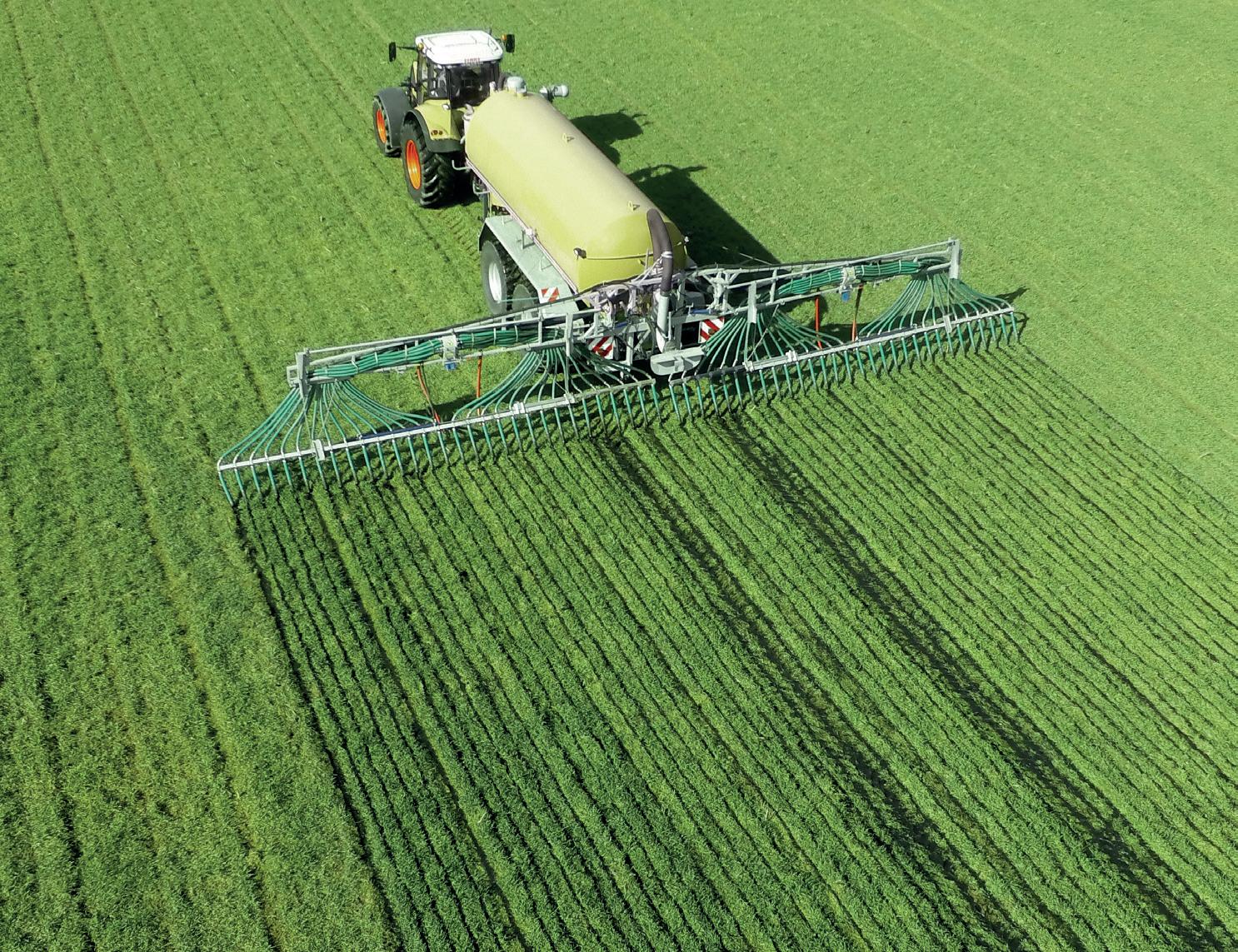

Flexible, reliable and easy to maintain:
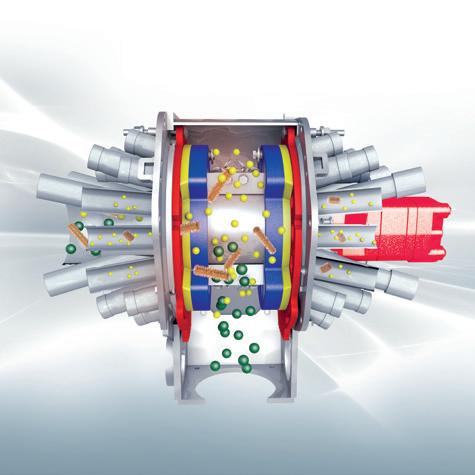
As a pioneer in agricultural technology, Vogelsang leads the way in environmental friendly spreading equipment. The dribble bar systems combined with the ExaCut distributor give the highest application of liquid manure nutrients.
Dribble bars are available in working widths of 7.5m right up to 36m and are retrofit-friendly.
For more information visit www.vogelsang.info/en-uk/dribble-bar-systems
VOGELSANG – LEADING IN TECHNOLOGY
Contact us at:
01270 216 600 | sales.uk@vogelsang.info
vogelsang.co.uk

PICHON is proud to announce the expansion of its SV slurry tanker range with the introduction of three new models: SV6, SV8R, and SV10. The SV slurry tanker range is designed to meet the diverse needs of agricultural professionals, offering robustness, efficiency, and environmental sustainability. With this expansion of the SV family, the total number of SV slurry tanker range comes to a total of 10. PICHON now offers a comprehensive range with capacities ranging from 6,600 to 21,100 liters. Initially launched in France as pre-series models in May 2023, these new models are now officially available for export in all regions.

All models in the SV range stand out for their versatility and evolutionary design, available in both single and double axle versions. These slurry tankers, pre-equipped as standard, allow easy adaptation of the tanker's features to the evolving needs of agricultural operations. The result of several years of research and
development at PICHON, these models are the outcome of a collaborative effort between engineers, designers, technicians, and sales teams, aiming to offer the best to customers in the field. Equipped with a fully galvanized structure, these tankers ensure exceptional durability and minimal maintenance. The integrated Vacuum technology, which creates a difference in atmospheric pressure between the inside of the tank and the ambient air, ensures efficient filling and emptying, thereby reducing maintenance costs. As an option, the turbo feeder, driven by a hydraulic motor, it relieves the vacuum pump when unloading mode is activated. This dual vacuum pump/ feeder operation guarantees optimum performance with thick slurry from cattle, raw digestate, etc. The SV models meet the challenges of modern agriculture, notably by allowing the addition of various application options.
fertilizers and ensure a homogeneous distribution of effluents. The pre-configuration

of the SV models is compatible with our spreading equipment: drip hose booms, trailing shoe booms, injectors, and incorporators. These low-emission techniques maximize nutrient uptake by plants and increase yields by reducing ammonia emissions and promoting better nutrient infiltration into the soil. This technology not only improves air
quality but also maximizes crop potential by enhancing soil fertility. The ease of use of this equipment ensures safe and efficient operation, essential for modern agricultural operations. SV slurry tankers are equipped with the iControl control system. It is available in a manual joystick or joystick and touchscreen version.


Focus on small capacities: compact and maneuverable solutions
The small capacity models, such as the SV6 and SV8R, are particularly suited to small and medium-sized farms. With respective capacities of 6,600 and 8,500 liters, these slurry tankers are distinguished by their compact size, making them perfect for tight environments. Their integrated chassis lowers the center of gravity, offering optimal stability
even on slopes.
Christophe Marzin, Product Manager, adds: « The compact and streamlined design of the single-axle models provides exceptional maneuverability, making these tankers a valuable allied for operations in hilly or mountainous terrain. Their robustness and ease of maintenance make them durable and reliable tools for all working conditions.








KUHN Farm Machinery’s mid-range OLYMPIC plough points have been redesigned to offer a 30% increase in longevity, helping users running genuine KUHN parts to increase the service life from their wearing metal.
The second-generation OLYMPIC point is now fitted as standard on all KUHN ploughs from the smallest MASTER 113 up to the largest Challenger range. They offer increased thickness at the top of the point to extend the lifespan and a bevelled shape to improve soil penetration. Further to this is an accentuated design to even wear and reduce tractor power consumption. The central section is now protected from extended wear to shield the bolts, making changing points easier.
Edd Fanshawe, KUHN’s arable and connected services product specialist, says the points now offer a
much-improved longevity to price ratio.
“The new OLYMPIC point retains similar dimensions to the previous version but offers an increased lifespan of 30% at a recommended retail price increase of just 6%. This means users will be benefitting from a more cost-effective option, increased longevity, and less downtime during the season by using genuine KUHN parts.”

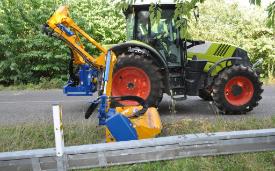
A new optional DURAKARB point increases point longevity by four times over the new OLYMPIC points. These feature tungsten carbide inserts to improve impact resistance and a patented brazing and heat treatment process.
Edd continues: “The working surface of the point is 100% carbide, using brazed insert technology rather than adding the carbide on the working face. This reduces the risk of loss during work and helps to increase protection and longevity.”


Hitachi Construction Machinery UK (HCMUK) has established itself as a key specifier of Xwatch Safety Solutions, playing a significant role in the widespread adoption of advanced safety systems across the construction industry. This partnership highlights the growing emphasis on integrating innovative safety technologies in response to the increasing complexity of construction projects.

Stephen Creaser, Hitachi Director of Product Support, says, "Hitachi Construction Machinery UK (HCMUK) is proud to be leading the way with Xwatch by installing the market-leading XW4 and XW5 systems at our Hitachi Connected Technology (HCT) facility in Newcastle.
The market demand for Xwatch Safety Solutions is rapidly growing as key clients and blue chip construction organisations are starting to mandate Xwatch as their preferred Height, Slew and RCI control solution on hydraulic excavators working on their projects. HCT are committed to enhancing the safety of our equipment and we have seen this increase in demand first hand with over 80 systems installed and calibrated at Newcastle in the last three months.

construction sites.
HCMUK's proactive approach in specifying and integrating our systems demonstrates a shared commitment to raising safety standards industry-wide."
Hitachi Construction Machinery UK (HCMUK) and Xwatch Safety Solutions are planning future collaborations focused on improving construction site safety. Both companies are committed to developing and implementing new safety technologies. This partnership aims to continue raising safety standards in the construction industry, ensuring that workers are better protected and operations run more efficiently.
HCMUK are also leading the way with real time telematics by providing remote real time monitoring of the Xwatch system, via our CTFleet Link® mixed fleet management solution. CTFleet Link® enables live direct access to key Xwatch safety metrics alongside the machine's operation data while the machine is in operation"
Since partnering with Xwatch in 2021, HCMUK has installed more than 350 Xwatch Safety Systems, including the XW4 and XW5 units, designed to meet and exceed client expectations for hydraulic excavator safety.
Jemma Dycer Hopkins, Xwatch Sales and Operations Manager, highlighted the significance of this partnership in the company's growth: "We are approaching the milestone of 5,000 Xwatch systems installed since our start-up in 2019, a testament to the industry's trust in our solutions. The support of major OEMs like Hitachi has been crucial in helping us reach this point. Their confidence in Xwatch has enabled us to expand rapidly and set new standards for safety across


n a newly created position, Gabriel Lund has taken up the role of Product Marketing Manager for SAMSON and PICHON products. With this new appointment, SAMSON is looking to strengthen the company's presence through an even closer collaboration with both dealers and end users to ensure that its products continue to meet the high expectations and market needs of its customers.
Since 2019, Gabriel Lund has been product manager for SAMSON's muck spreaders and universal spreaders, where he has gained extensive experience with SAMSON and PICHON products. He has thus been part of SAMSON GROUP for several years and has a wide knowledge of the products of the group.

Gabriel Lund will work closely with both dealers and end users. He will be responsible for planning and carrying out a number of important activities, including product launches, competitor analysis and marketing training.
In his new role as Product Marketing Manager,

" My goal is to ensure that SAMSON and PICHON products continue to meet the high expectations of our customers. By intensifying our presence and demonstration activities, we will strengthen the link between factory, agricultural contractors and farmers to ensure that our customers get the best possible experience with our products, " says Gabriel Lund.
With Gabriel as a link in SAMSON's product marketing, SAMSON will be able to offer dealers and end users even more support in the future. Among other things, the company is planning a number of demonstrations and sales activities during the coming autumn, which will help maintain a strong connection with customers and dealers.
Head of Product Management & Academy at SAMSON GROUP A/S, Niels Hagemann Haubjerg, sees the appointment as a strength for SAMSON GROUP's product, marketing and sales department: "Gabriel's extensive experience and thorough knowledge of our products make him the ideal person to further develop our product marketing. He will work closely with our dealers and end users to ensure that our products continue to meet the needs of the market. His background in the countryside, as well as his training as an agricultural economist in plants and speciality crops, gives us a strength that comes from hands-on experience of working the soil. He can also provide a good overview, which will be of great help to us, as well as the farmers and contractors who show confidence in our product selection."



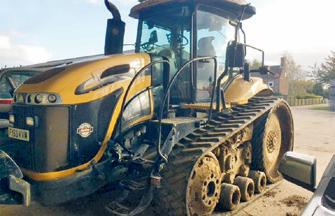

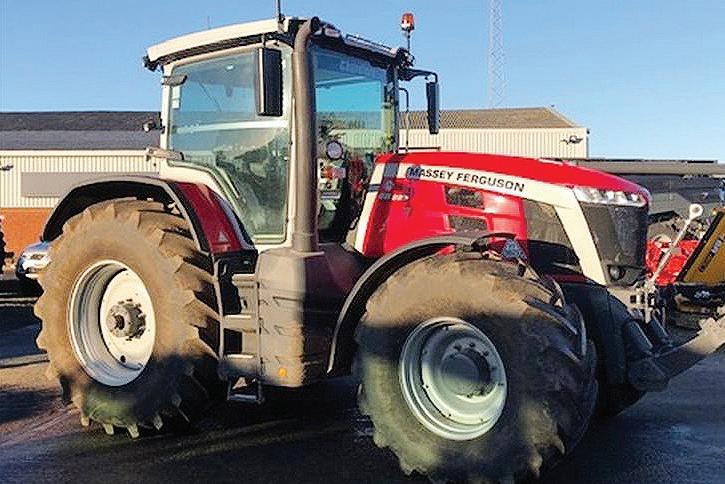


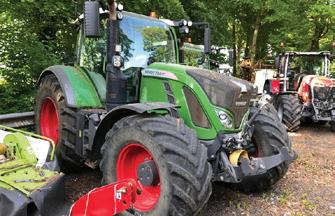










The strong trade for later classic tractors showed no signs of dropping as 140 classic and vintage tractors, along with 1,000 entries of spares, implements and stationary engines, went under the hammer at the eagerly anticipated Harrogate auction, completed by machinery auctioneers Cheffins.

The Harrogate sale, held at the Great Yorkshire Showground, has been an annual event on the sale calendar for more than 30 years, and this year’s auction totalled £672,000, with a strong sale rate of 83%. Mid-eighties and early nineties tractors continued to attract a loyal following, with a 1985 MB-Trac 1500 making £51,456, and a sought-after 1992 John Deere 4955 eventually finishing at £35,912. An immaculate 1994 twowheel-drive Ford 7810 Powerstar SL, with one owner from new on 5,200 hours, achieved £19,296.
Bill King, Chairman at Cheffins, says the later classics continue to be popular. “Later classics from the 80s and 90s are once again in high demand, particularly low-houred examples in original condition. Purchasers are keen to invest in tractors they remember operating. There is still a strong demand for early classics too, such as Massey Ferguson 135s, Fordson Dexta and David Brown 880s. These are iconic models, with original examples or ones in restored condition, achieving premium prices. An unusual and original Fordson Standard N with a Roadless Full Track conversion, made a superb £19,080, confirming that there is still considerable interest in these earlier 1940’s tractors, too.”
Other notable earlier tractor models sold at Harrogate included a 1980 Muir-Hill 121 for £29,480, a 1974 Massey Ferguson 188 for £12,006, and a 1946 Field Marshall Series I fitted with a Lainchbury winch was purchased for £14,150. Highlights from the implements and spares sale included a 1967 Wheatley single axle tipping trailer for £3,472; an unused Hara cab for a County 1174 finished at £4,256 and a IHC Tom Thumb stationary engine sold for £1,064. A Ford toolbox with mounting bracket suitable for a front casting made £512, while a 2014 Land Rover Defender 90, with just 23,000 miles on the clock, sold for £32,160.
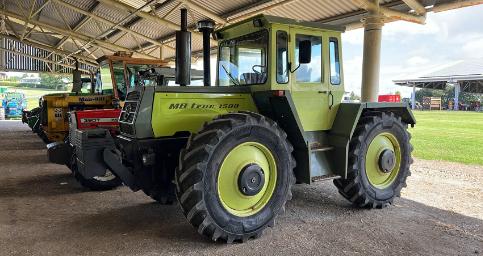
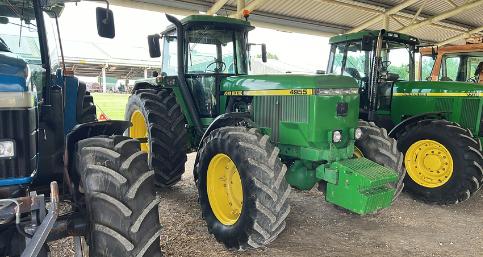
Bill concluded that the implements and spares are just as popular for many buyers as the tractors.
“Tractor and implement spares sold very well as restorers want to source original parts for their projects, and, with some spares difficult to find, this leads to surprising prices being achieved. Classic 3-ton trailers, cultivators and ploughs, along with barn machinery, all sold for excellent prices. We are already looking forward to 2025.”
New Holland is introducing new advancements in its precision technology stack to make farming easier, more sustainable and more efficient for its customers.

FieldOps web and mobile platform and Connectivity Included feature become part of New Holland’s technology offering, both designed to help customers have a seamless experience across New Holland’s digital and connected platforms.
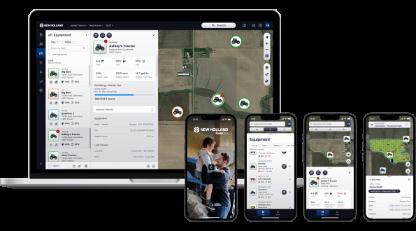
The new FieldOps web and mobile farm management platform, first previewed in April 2024, is now live and available for download on the iOS App Store and Android Play Store. FieldOps is a versatile farm management tool that helps farmers expand their productivity from anywhere, anytime by taking their farm operations data and details and simplifying them into one platform that’s easy to use, understand and connect.
Built to enable farmers to view and monitor all their CNH machines in one place, FieldOps provides one streamlined platform for everyone — at every skill level, crop specialty, region and size of operation. Farmers will be able to monitor every machine in real-time1, remotely view in-cab displays to deliver better feedback to their operators and see layers of agronomic data — all in one platform. FieldOps is built to work the way customers want to, allowing them to do more with fewer clicks. Its new, more intuitive interface empowers users to make more informed and quicker data-driven decisions that improve their operations every day.
Customers can download the new mobile app to view their connected machines. Existing MyPLM Connect users can easily transition to FieldOps: their data will already be there when they log in.
To make data management even easier for farmers, FieldOps has over 40 API (application programming interface) connections available globally, creating seamless integrations with thirdparty digital platforms. Customers get to choose how they own their data, whether they decide to import it all into FieldOps to manage or export their FieldOps data to use it on another platform. This eliminates the need for unnecessary data re-entry, making the overall digital experience easier across
a farmer’s entire operation.
New Connectivity Included feature
“Connectivity Included” is a new feature that grants customers limitless connectivity with no recurring subscription fees on qualifying machines2. This offering provides real-time data and remote support to farmers without the hassle of managing or renewing a subscription.
This is a completely new approach to connectivity that makes data accessible by simply making it part of the machine. As a baseline feature, it expands the reach and utility of connected features, helping farmers improve their productivity and use of agronomic data as they benefit from free, easy-to-use data monitoring from their machines, fleets and fields.
Interested customers with existing machines and capable telematics modems can purchase Connectivity Included functionality for a one-time fee to benefit from simplified subscription management as well. New Holland encourages customers to contact their local New Holland dealer for more information.
Carlo Lambro, New Holland Brand President, commented: “With these advancements in our open digital ecosystem, we add new milestones in our ongoing global innovation journey to make everyday operations more efficient and productive for farmers. These projects are designed 100% around our customers and dealers, to provide data and help them increase productivity and reduce costs. We are committed to continuously improving all of our services to make New Holland’s digital experience even more open and accessible.”
To learn more about New Holland’s new digital technology solutions visit www.newholland.com
The new FieldOps™ Mobile and Web application, Connectivity Included and expanded API partnerships will allow farmers to easily manage their fleets and access actionable data from anywhere to deliver bottom line benefits.

Today's farmers are challenged with not only rising production demands, increased costs, and skilled labour shortages, but also increasingly complex operations to manage. Case IH understands that farmers need seamless, easy-to-use technology to help make their lives easier — and is reducing the hassle of managing multiple technology subscriptions and delivering interoperable tech solutions to meet this need.

Case IH believes precision tech must be rooted in providing actionable data and impactful solutions that make farming easier, more efficient and profitable. That's why Case IH is launching a series of technology initiatives that put the farmer userexperience at the forefront. The all-new FieldOps™ mobile and web application redefines the way farmers connect, view and manage their operations with an expanded API integration. Lastly, Case IH is announcing Connectivity Included, which eliminates subscriptions on selected new machines, and simplifies the process of customizing technology needs.
The all-new Case IH FieldOps web and mobile app is available now for download in the App Store and Google Play Store.
FieldOps seamlessly connects and integrates agronomic insights and machine performance data, providing farmers with a comprehensive, real-time* overview of their operations, no matter the brand makeup of their fleet. Redesigned with special attention to streamlining the user experience, FieldOps makes it easy to access agronomic and machine data from anywhere.
"Launching FieldOps gave us the opportunity to fulfill the three main needs farmers have with connectivity and precision tech: interoperability,
ease of use, and real-time data transfer," said Marco Lombardi, Head of Case IH and STEYR brands EMEA.
Key features available with Case IH FieldOps:
• Remote Display View allows farmers to see all parts of the in-cab screen: operators can be guided from a distance and achieve minimum downtime and maximum productivity through this quick and targeted assistance.
• Continuously updated machine location for real-time* updates and directions.
• Farmers can customize their view based on what's important to them: set notifications, alarms and adjust settings for each machine, create machine parameter favourites by machine or machine type.
• Enable dark or light mode for preferred user experience regardless of time of day.
• Integrates with CNH brands and third parties.
FieldOps offers a consistent, user-friendly interface across mobile devices and web browsers, ensuring ease of use for farmers on the go. FieldOps is purposefully designed to incorporate all Case IH data and information into one platform for easy access with one log-in.
Farmers can monitor crop health, growth stages, and field conditions to make informed agronomic

decisions. Furthermore, FieldOps integrates with Case IH equipment and third-party systems to streamline data collection and analysis, providing a holistic view of farm operations, no matter the fleet makeup. Farmers can track machinery usage, fuel consumption, and performance with continuous updates, ensuring optimal operational efficiency, labour management and maintenance scheduling.
As the digital landscape continues to evolve, Case IH recognizes how critical it is for farmers to have seamless integration and access to their various data platforms. Case IH is expanding its API partnerships, which globally totals more than 40 as of June 2024. This gives Case IH customers easier access to their agronomic and operational data, eliminates hurdles navigating within digital platforms, and ultimately, increases farmer productivity.
Introducing Case IH's All-New Connectivity Included Feature
resale process."
With Connectivity Included, operators gain access to the following:
•Agronomic data: Leverage agronomic insights to enhance overall yield potential, optimise crop management practices, and maximise profits.
•Machine data and telematics: Access realtime machine data and telematics information to reduce idle time, streamline operations, and coordinate multi-machine tasks with precision and efficiency.
•Proactive dealer support: Stay up and running by ensuring any potential issues are identified and addressed promptly to minimise downtime and maximise productivity.
For more information on the launch of Case IH FieldOps, please visitthe website. For a detailed account of products covered under Connectivity Included, and an up-to-date list of global API Partnerships, please contact your dealer.

In addition to launching Case IH FieldOps, Case IH is proud to introduce Connectivity Included. This groundbreaking initiative removes subscription fees from Case IH technology for qualifying machines built and purchased after October 1st, 2024**. With Connectivity Included, farmers can unlock the full potential of their Case IH equipment without ongoing subscription costs, providing unprecedented value and peace of mind.
Customers who wish to activate the Connectivity Included feature on existing machines with compatible telematic modems and a Case IH FieldOps account (previously AFS Connect) will be able to do so for a one-time fee by contacting their dealer.
"Connectivity Included represents our commitment to supporting farmers throughout the lifecycle of their equipment," added Marco Lombardi. "By simplifying subscription management and providing continuous access to our technology, farmers can unlock the benefits of the tech now, and in the
*Real-time monitoring data transfers approximately 3-5 seconds following each machine action and location change. Real-time monitoring features are currently only available for AFS Connect tractor models: Optum, Puma, Magnum, and Steiger/ Quadtrac. These features will be phased in across other platforms, including combines and sprayers, in future updates.
**Connectivity Included will be available on new qualifying Case IH machines Puma models 185 and above, AFS Connect Puma, Optum, Magnum Series Tractors, Steiger/Quadtrac, 1x0 and 2x0 Series Combines & AF Series Combines, A9000 Sugar Cane Harvesters, 50 Series Self-Propelled Sprayers, and WD 5 Self-Propelled Windrower units built on or after October 1, 2024. Acceptance of End User License Agreement (EULA) is required. Connectivity Included will be active for the useful life of the PCM/PCMF modem. If the modem is no longer capable of receiving current cellular services, any modem hardware upgrades are not the responsibility of Case IH.
Claydon, the European market leader in direct drilling technology with its Opti-Till® crop establishment system, recently added two new products to its extensive range of crop establishment products., the Claydon Evolution Drill Toolbar and Claydon Evolution Front Hopper.

CLAYDON EVOLUTION DRILL TOOLBAR
The Evolution Drill Toolbar can be used in conjunction with the Evolution Front Hopper and is available in widths of 3m, 4m, 4.5m, 4.8m, 5m or 6m. The standard specification includes one distribution head with 38mm seed delivery hoses, but a second distribution head can be optioned, allowing fertiliser to be supplied to either the front leading tine or rear seeding tine.

the rear-mounted drill, a simple airline box selector diverting the flow of material to the distribution pipes or combining the total output into one pipe. An ISOCAN terminal controls all front hopper functions and allows variable rate seeding, depending on the task controller and licence key.
CLAYDON EVOLUTION FRONT HOPPER
With a total capacity of 2750 litres, split 45/55%, the Evolution Front Hopper is pressurised to ensure reliable high-volume material delivery to the rear distribution heads. Twin metering units deliver either mixed or separated seed/fertiliser flows to
ISOBUS compatible, the Evolution Front Hopper is supplied with small, medium or large diameter interchangeable metering wheels to suit a wide range of seeds and fertilisers. Weighing 730kg, it measures 2476mm wide, 1803mm high and 1619mm long, incorporates two hopper sensors providing ‘low level’ and ‘empty’ warnings, work lights, two road vision cameras, a toolbox and foldable front footstep. Options include 550kg of ballast, plus packer wheels with passive steering and wheel scrapers.
Further details about Claydon products are available from authorised dealers, a list of which is available on the Claydon website (claydondrill.com/ dealers-distributors). Alternatively, visit claydondrill. com and click on the product of choice.
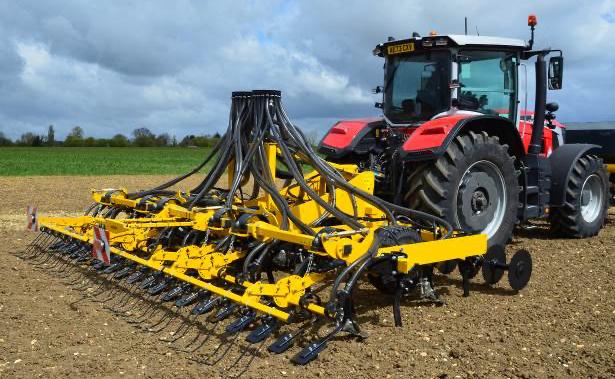

Discounted tickets are now on sale and entries open for the Newark Vintage Tractor and Heritage Show, which will once again welcome visitors, exhibitors and enthusiasts of vintage machinery from across the country.
Taking place on 9-10 November, the show will host over 1,000 vintage tractors, implements, horticultural machinery and commercial vehicles –alongside a plethora of trade stands and a lively auction, as well as tractor and trailer rides.
While last year was a grand celebration of the show’s 20th anniversary, this year’s focus will be on the many milestones of respected manufacturers and a world record attempt for the largest gathering of Massey Ferguson 135 tractors.
Co-supported by Friends of Ferguson Heritage (FOFH), the world record attempt will coincide with the 60th anniversary of MF 100 series production, which will be celebrated with the display of the long-standing manufacturer’s ‘Red Giants’ including the 130, 135, 165 and 175 models.
the Bedford O series, as well as paying tribute to the wartime David Brown VAK1 series. Visitors are also invited to participate in the show’s celebration of Scammell lorries, 75 years of the John Deere two-cylinder diesel engine, and 50 years of the ERF B series lorry.
A showcase of sugar beet machinery will also demonstrate the technical and engineering evolution of the root crop’s production throughout the years. And with its origins in nearby Grantham, Aveling Barford will display plant equipment.
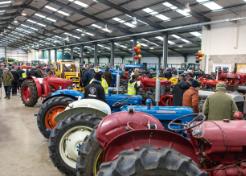
As ever, the show will hold a full catalogue of classes for club stands, tractors, stationary engines, horticultural and heritage implements and displays, as well as commercial, military, car and motorbike classes.
“We’re excited to be making a world record attempt of the highest number of MF 135s assembled at one time, with the hope of having between 150 and 200 of these tractors at the show – which will certainly be a spectacle,” says FOFH club chair, Peter Lawrence.
“We are passionate about the 135 as it is truly the most iconic model Massey Ferguson has made and it is well represented, not only here in the UK, but also around the world. The show also coincides with the MF 135’s 60th birthday, which was launched together with the other 100 series tractors at the Smithfield Show in December 1964,” he adds.
“The event will help protect the legacy of Harry Ferguson for future generations; we look forward to welcoming members and non-members taking part in this event.”
Joining Massey Ferguson in a 60th year celebration will be the Ford 6X 1000 series. A collection of Pre-Force tractors will be on display including the 2000, 3000, 4000 and 5000 models, dating from 1964 to 1968. Ford will also be celebrating 85 years of the Ford 2N, 9N, and 9NAN models, the latter boasting the Ferguson threepoint linkage system.
Elsewhere on the showground, the show will be commemorating 85 years since the introduction of
New for 2024 is the Best Modified Tractor class, with the title going to the best substantially changed tractor – a chance for exhibitors to demonstrate their own kind of creativity. Judging of entries for all classes will take place on the morning of Saturday (9 Nov) with the awards ceremony taking place at 6pm in the Sir Stuart Goodwin building, before live music to enjoy into the evening.
For visitors wishing to stay, the show offers a weekend experience ticket including up to three nights camping and admission to the show for two adults. Camping for exhibitors is also available.
Members of the Newark and Nottinghamshire Agricultural Society are able to camp free of charge, as one of the many membership perks.
“The show has become a pretty special event over the years,” says show organiser, Elizabeth Halsall. “It is a complete homage to vintage tractors, vehicles and machinery.
“It is the perfect opportunity for enthusiasts and collectors to enjoy the nostalgia and share stories, which are as much a part of the machines as their mechanical parts. We are looking forward to another brilliant event.”
Tickets are available at: www. newarkvintagetractorshow.ticketsrv.co.uk/tickets/ Discounted day tickets are £15/adult (17+ years) until 1 November, increasing to £19 thereafter. Children and youths (16 years and under) enter for free.
Exhibitors can enter classes online at www. newarkvintagetractorshow.com/exhibitors

Claydon has underlined its commitment to helping farmers optimise soil health and better manage weather extremes by launching a new Claydon Mole Drainer.
Designed by the company’s founder and CEO, Jeff Claydon, the single-leg implement is based on a unique concept which overcomes the drawbacks of traditional mole drainers and combines the benefits of mounted and trailed designs without the drawbacks of either.
Extensively evaluated on the Claydon family’s arable farm at Wickhambrook in Suffolk, the new addition to the company’s range of Opti-Till®
machinery enables mole drains to be formed easily and accurately. Even on very heavy land, such as the farm’s mainly Hanslope-series soils, it can be handled by a well-ballasted 200hp tractor.
“After a very wet season in which many fields suffered from prolonged waterlogging it is important to take effective action to improve drainage and eliminate excess water,” Jeff states.
“If done correctly, mole draining is a very efficient, cost-effective way to do that. When formed under the right conditions, as we have had this season, moles can last up to 20 years, so doing the job well will pay handsome dividends. Over the years we have owned several mole drainers, but none ever

did quite what we wanted, so we designed our own.”
Mounted on the tractor’s rear three-point linkage the Claydon Mole Drainer features an oscillating headstock with a swivel joint which makes it very easy to manoeuvre and allows it to reach further into headland ditches or over drains.
A key feature is the long, narrow beam which is akin to the well-proven principle once used for steam-driven mole ploughs. The design of the beam also allows the 75mm-diameter mole bullet and following 100mm ceramic expander to run parallel to it, producing a uniform, stable channel at the correct depth and angle. This design also avoids excessive friction between the beam and soil surface, thereby minimising draft requirement and fuel use.
The unique design of the adjustable headstock holds the narrow beam in the upright position and avoids the need for outrunner skids, enabling the angle of the bullet to be precisely adjusted. Locked

in place by a steel wedge, the blade pivots on three pins and the bullet angle is controlled by the narrow 200mm-wide front skid, which allows mole draining through standing crops with very little damage.
The user-friendly design of the Claydon Mole Drainer makes it easy to adjust both the blade angle and the depth of the mole fixed pin. Chains linking the oscillating headstock to the beam allow the tractor to turn easily and progressively lift the beam, enabling the mole to ski out of the ground gently and with very little soil disturbance. A major benefit in all farming situations, this aspect is particularly important when working on grassland to maintain sward integrity.
“The key with any mole drainer is to set it correctly. The blade, bullet and expander need to travel parallel with the beam,” Jeff outlines. “With the Claydon Mole Drainer accurate control results from the design and position of the front skid, which guides the bullet through the ground parallel to the beam, forming a nice level channel in the clay. Because this is free of any dips or troughs water can run away unrestricted and continuously.
“I have used the Claydon Mole Drainer extensively and been delighted with its performance. It is very user friendly, simple to set up, easy to use and as the bullet wears you can make small adjustments to keep it performing at optimum efficiency.
“In the spring we went through standing crops at GS 30/31, on a 2.7m spacing and 60cm deep, behind our John Deere 8345R, which recorded just five per cent wheel slip. Damage to the crop was so slight that it was hard to see where it had run. Doing the job at that time of year allows the roots to stabilise the soil, so autumn-sown crops will benefit, and gives the new moles time to cure over the summer months, ensuring that they remain efficient for many years to come.
“Immediately after harvesting oilseed rape we mole drained direct into the stubble, operating the Claydon Mole Drainer at 5.5km/h behind our Fendt 724 with the engine operating at just 1050rpm. For the operation to be effective it needs the right type of soil and enough moisture, so with the underlying clay like plasticine conditions were ideal.”
Whilst the Claydon Mole Drainer will never be a big seller it is a valuable addition to the Opti-Till® range, fitting well with the company’s philosophy of providing farmers with the best equipment to operate efficiently and profitably.
Mounting hooks for a spare blade and a toolbox are standard equipment, a lighting kit optional.
Further details about Claydon products are available from authorised dealers, a list of which is available on the Claydon website (claydondrill.com/ dealers-distributors). Alternatively, visit claydondrill. com and click on the product of choice.
CLAAS has launched five new SCORPION telehandlers in the 3and 4-tonne class. These models feature significant improvements in comfort and convenience, as well as improved stability and more lift capacity. The new VARIPOWER 3 drive with boosted tractive force is optionally available for the SCORPION 738 and 742..

The eight SCORPION telehandlers in the CLAAS product portfolio cover lift capacities from 3.3 to 6.0 t and lift heights from 6.7 to 10 m. Five new models with lift capacities from 3.3 to 4.2 t – SCORPION 733, 1033, 638, 738 and 742 – have breathed new life into the range with a host of performance- and comfort-boosting features designed to offer more customer benefits than ever before.
Cleverer, stronger and more stable
Thanks to higher hydraulic pressure, the new SCORPION telehandlers deliver up to 300 kg more lift capacity – 3.3 t in the 1033 and 733 entry models and 4.2 t in the SCORPION 742. At the same time, to ensure the customary balance and stability, the wheelbase has been increased by 100 mm, with corresponding modifications to the counterweight at the rear.
This machine class now benefits from SMART LOADING functions too, thanks to new hydraulic controls with electronic pilot control. The following automatic functions and assistance systems are now available to operators:
• Automatic bucket return to the previously saved position: saving significant time and effort when performing repetitive tasks close to the ground.
• Automatic bucket shake function: the tilt rams ensure reliable emptying of clumping materials and even distribution of loose materials.
• Automatic retraction of the telescopic arm (not
for SCORPION 1033): the mast automatically retracts as the telescopic arm is lowered –significantly reducing the operator's workload.
The 105 kW/143 hp, 550 Nm Liebherr four-cylinder diesel engine delivers a hydraulic output of max. 160 l/m at a quiet and fuel-efficient 1,600 rpm. During loading, DYNAMIC POWER automatically adjusts the engine speed to the joystick angle and so to the desired lift and loading speed. This unique feature ensures faster, even more efficient load cycles.
VARIPOWER 2 and VARIPOWER 3: JAGUAR tractive power, applied with precision
All models are driven by the powerful and efficient VARIPOWER 2 hydrostat – the strong, effective and reliable drive that has been used in CLAAS JAGUAR forage harvesters for years. Furthermore, the new VARIPOWER 3 is optionally available for the SCORPION 738 and 742 models. With a larger dual hydraulic motor, this version transfers up to 68 kN tractive force to the wheels – an increase of around 20 per cent compared with the VARIPOWER 2 (57 kN). Despite this extra power, the drive retains its familiar fingertip precision. The VARIPOWER 2 and VARIPOWER 3 can achieve a top road speed of up to 40 km/h.
Focus on the operator: optimised cab ergonomics and powerful air conditioning
The cab in the SCORPION 733 - 742 has had a complete make-over. The first thing you notice is the external safety guard. Then the partially glazed access door, which swings open by a full 180 degrees and features a quarterlight to improve cab ventilation. New compartments and cargo nets provide ample storage space on the inside of the door. Furthermore, sound insulation in the door has been increased to reduce noise levels in the cab.
The redesigned steering column makes accessing the cab easier and also creates more foot room for


the operator. The height and angle of the steering wheel can be fully adjusted to perfectly accommodate the operator's needs. The display is now positioned above the steering wheel, making it easier to read. The suspended brake/inch pedal with larger tread surface improves foot ergonomics and ensures an optimum foothold. The relocated pedal also makes it easier to remove the floor mats for cleaning and replace them.
To the right of the steering wheel is the repositioned and resigned dashboard with a 3.5inch colour screen (optional 7-inch screen). In front is a handy smart phone shelf and to the left, the new control unit for the heating and air conditioning system. The temperature and now the fan too can be adjusted continuously instead of incrementally in three stages. The air conditioning unit has been replaced with a new, larger version designed to significantly improve cooling performance –ensuring that the interior remains cool at all times even on hot days.
The joystick has been relocated to the right of the operator's seat to further enhance comfort. The joystick and other key controls such as the controller for the speed ranges now move with the operator's seat, allowing the right arm to remain comfortably on the armrest during load cycles.
After long working days, especially as the nights start drawing in, an extra LED headlight on the lefthand A pillar with Coming Home function provides additional safety when parking up in poorly lit areas. Before parking the SCORPION, the driver presses the Coming Home activation button once and the headlight stays on for an additional 60 seconds after the engine has been switched off to illuminate the area on the left side of the machine. So even in the dark, the driver can close the cab door and leave safely.
Practical features to make the working day easier
Another new feature is the pressure relief button on the left of the rear light bracket. One press is all it takes to depressurise the rear connections –making it easy to insert and remove hydraulic connectors.
SCORPION can be fitted with a range of practical

additional equipment for cleaning and maintenance. Models fitted with air brakes have a connection for an air blow gun by the cab step. So soiled areas can be cleaned and blown out away from the machinery shed or yard. Talking of cleaning, a brush and shovel holder can be factoryfitted at the rear on the left-hand side for carrying up to two items. On the opposite side, there is room for a removable 5 l water tank for quick onsite hand-washing.
Key new features at a glance:
• Five new SCORPION with 3.3 to 4.2 t lift capacity and 6.7 to 10 m lift height.
• Designed for faster, more efficient load cycles.
• Longer wheelbase, modified counterweight and larger steering lock ensure maximum stability for increased lift capacities without compromising manoeuvrability.
• DYNAMIC POWER for efficient engine speed management.
• SMART LOADING for convenient automation and operator assistance across a wide range of applications.
• Optional VARIPOWER 3 drive for SCORPION 738 and 742: 20 percent more tractive power for the most demanding tasks. New cab with optimised ergonomics: slender steering column with adjustable height and angle and suspended brake/inch pedal.
• New armrest with joystick integrated into the operator's seat
• New air conditioning system with precise temperature and fan control.
• Partially glazed cab door with quarterlight window, 180-degree lock and storage pockets on the inside.
• Additional LED headlight with Coming Home function.
• Practical additional equipment such as pressure relief button, water tank and brush and shovel holder at the rear.






The MULE SX 4x4 rides on 24 inch tyres and offers selectable 2WD and 4WD, with CVT drive 2 speed auto, reverse and rear differential lock. Kawasaki
PRO styling, tilting steering wheel and the dependable OHV 410cc engine, 181kg load and 500kg towing capacity, make this a true go anywhere vehicle.
AVAILABLE IN THE NEW DISTINCTIVE SUPER BLACK FROM OCTOBER 2024

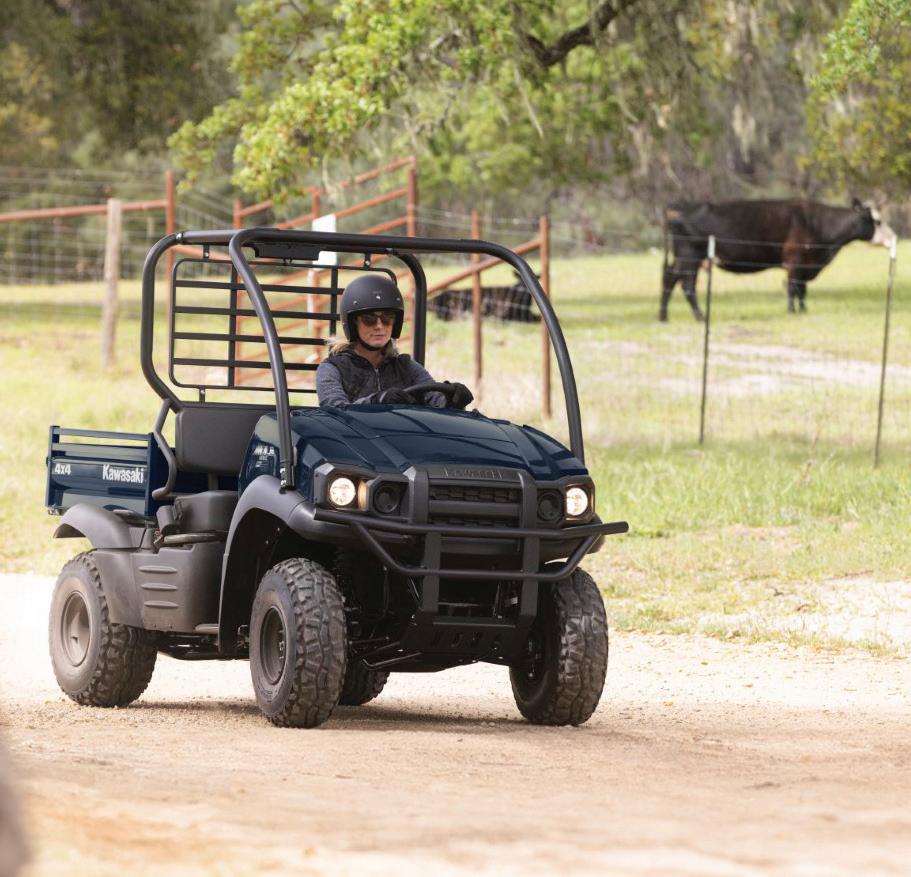



omplementing its earlier launches of the full-size RANGER, Sportsman 570 2-up and RZR Pro lineups, Polaris Off Road today also unveiled its 2025 upgrades to the off-road industry’s most expansive lineup, including an impressive range of new colours and quality upgrades introduced across its Sportsman and RZR models.
Highlights include the latest trim added to the Sportsman 570 model range - the new Premium LE model in Matte Copperhead, joined by new colours across the 1-up platform, as well as the new RZR Trail S Ultimate in Sand Dune to give customers an upgrade in style and ride features.
“This year has already been a fantastic showcase of product innovation and performance for us here at Polaris,” said Rodrigo Lourenco, VP International Sales & Marketing. “From the launch of our most complete 2-up ATV lineup that’s revolutionised off-road ATV riding with a passenger, to our triumphant victory with Polaris RZR at the Dakar Rally this year; these key milestones have proven our unwavering commitment to product development, and we haven’t stopped there. These new models within our 2025 customer offering are representative of direct customer feedback to meet their needs and requirements.”
Polaris Sportsman, the long-standing No. 1 selling automatic 4x4 ATV, builds on rider-inspired innovations and includes smooth, strong and versatile features across the 2025 ATV lineup. Along with the 2025 Sportsman 570 2-Up lineup released earlier this year, Polaris upgrades its


bestselling Sportsman 570 1-up ATV lineup to match and expands the lineup with an all-new Sportsman 570 EPS Premium LE in Matte Copperhead, the Sportsman 570 EPS in Stealth Grey with new Lime Accents, and new Heavy Metal Gloss colourway with orange accents for the Sportsman 570 SP.
The 2025 Sportsman 570 1-up platform includes new integrated LED work light with built-in battery charging port, quality upgrades including new wheel-well debris shield and new seats with premium Polaris branding. True On-Demand allwheel drive, in-line shifting, and single-lever braking allow for simple and effective user control, whilst the engine braking system (EBS) on applicable models delivers a smooth and controlled riding experience regardless of the terrain type. Giving riders the confidence to go further and do more, the Sportsman 570 features sealed MacPherson Strut suspension on the front with 20.8cm of travel, alongside Dual A-Arm independent rear suspension with 24.1cm of travel. SP models feature sealed high-clearance


arched Dual A-Arm suspension on the front.
NEW 2025 Sportsman 570 EPS - Stealth Grey with Lime Accents (T3a / T3b / L7e)
NEW 2025 Sportsman 570 EPS SE Premium LEMatte Copperhead (T3a / T3b)
NEW 2025 Sportsman 570 EPS SP - Heavy Metal Gloss with Orange Accents (EU / T3a / T3b)

Polaris RZR, the No. 1 sport side-by-side brand, continues to make a bold statement on the trails with fresh new colours and graphics across its trail and XP lineup.


The 2025 RZR Trail S is now available in Sand Dune on the Ultimate trim, complete with red graphics, springs and colour-matched painted roll cage. At just 60-inches (152.4cm) wide, with powerful LED lights, power steering and 27-inch tyres, the RZR Trail S is optimised for next-level performance, offering riders’ their best trail ride yet. Building on the features of the Sport spec, the Ultimate trim also offers RIDE COMMAND compatibility and Rockford Fosgate® cab audio system to elevate any trail ride, as well as a poly roof fitted as standard, and Walker Evans® Needle Shocks offering 31.1cm front and 33.5cm rear suspension travel.
NEW 2025 RZR S 1000 EPS Ultimate - Sand Dune (EU / T1a / T1b)
Also new for 2025 is the new Storm Grey colourway for the RZR XP Sport, featuring contrast Lifted Lime RZR graphics, front bumper and springs, plus a colour-matched Lifted Lime roll cage on the 2-seat model. The RZR XP’s ProStar 1000 Gen 2 engine provides the ultimate in trail agility and responsive acceleration, complemented by stay-out-all-day features like bright LED headlights, full doors, illuminated interior controls and Walker Evans® Velocity shocks for unmatched comfort. The 2025 RZR XP is fitted with 14-inch black alloy wheels and comes fitted with a front bumper as standard.
NEW 2025 RZR XP Sport 1000 EPS - Storm Grey (EU / T1b)


omerset ATV dealer Ark ATV has joined the Corvus Off-Road-Vehicle network. The announcement was made by BOSS ORV, the UK Corvus distributor, whose Managing Director, Phil Everett, has previously worked with Ark director Rob Blomfield-Richards.
“I am delighted to be reunited with him and his team, as I know how professional they are and what fantastic support they offer to their customers,” says Phil.
ARK ATV Ltd has been family-owned and operated since 1997, supplying farmers and other workers with high-quality ATVs from their Minehead area base. BOSS ORV’s National Sales Manager, Neil Everett, has also known Rob and the team for many years and says he has seen them demonstrate extremely high customer service levels and a great understanding of the working ATV/UTV market. They will cover the area across Somerset and North Devon.
Neil says, “with their current line-up lacking a UTV and us requiring coverage in such a strong area for UTV sales, it seemed almost natural for us to open up discussions regarding the Corvus franchise.”
Ark will sell and support the Corvus Terrain ranges of diesel and electric UTVs. BOSS say they are extremely pleased to have such a longstanding, credible ATV/UTV specialist added to their dealer network. They believe Ark ATV will provide the highest standard of sales and aftercare support for all new and existing customers within the area. For Ark, becoming Corvus dealers gives them access to the full Corvus range, and allows them to cater to their customers’ needs by providing true commercial work ATVs, both diesel and electric. BOSS add that not only are they extremely pleased to have them on board, but they are also very much looking forward to working with Rob and Ark MD, James Westwood, in the coming years.
For more information about the Corvus Terrain range, you can call 01785 561046
E-mail: sales@bossorv.co.uk
Web: www.bossorv.co.uk


YD, the world’s leading manufacturer of new energy vehicles and power batteries, today announced a multi-year strategic partnership with Uber, designed to bring 100,000 new BYD electric vehicles onto the Uber platform across key global markets. Beginning first in Europe and Latin America, the partnership is expected to offer drivers access to best-in-class pricing and financing for BYD vehicles on the Uber platform and will expand to include markets across the Middle East, Canada, Australia, and New Zealand.
To support drivers going electric, the companies’ joint efforts may also include discounts on charging, vehicle maintenance, or insurance, as well as financing and lease offers, based on what works best for drivers in a given market.
The two companies will also collaborate on future BYD autonomous-capable vehicles to be deployed on the Uber platform. As the largest on-demand mobility and delivery platform in the world, Uber is well-positioned to bring autonomous vehicle technology to a global audience at scale.

Both companies are EV leaders in their respective categories: Uber has the most widely available ondemand EV network in the world, and BYD is a global leader in EV production. By working together, the companies aim to bring down the total cost of EV ownership for Uber drivers, accelerating the uptake of EVs on the Uber platform globally, and introducing millions of riders to greener rides.
While Uber drivers are going electric five times faster than private car owners, driver surveys show the price of EVs and availability of financing remain the key barriers to switching. In addition to their affordability, BYD vehicles have lower costs of maintenance and repair, and are well suited to rideshare due to the wide range of models, superior battery performance, and excellent build quality.
"Uber and BYD share a commitment to innovate towards a cleaner, greener world, and I am excited to work together towards that future," said Chuanfu Wang, Chairman and President of BYD.
“As the largest global agreement of its kind, we’re thrilled about the benefits this partnership will deliver for drivers, riders, and cities,” said Dara Khosrowshahi, CEO of Uber. “When an Uber driver makes the switch to an EV, they can deliver up to four times the emissions benefits compared to a regular motorist, simply because they are on the road more. Many riders also tell us their first experience with an EV is on an Uber trip, and we’re excited to help demonstrate the benefits of EVs to more people around the world.”
Stella Li, Executive Vice President of BYD and CEO of BYD Americas, also commented, “We are elated to join forces with a global leader like Uber to not only accelerate the transition to electric vehicles but also to make green transportation accessible and affordable for everyone. This collaboration marks a new era in the electrification of urban mobility, and we look forward to seeing our cutting-edge EVs become a common sight on the streets of cities worldwide.”
oad safety and breakdown organisation GEM
Motoring Assist is urging dog owners to ensure they keep their pets cool on car journeys. Forecasters are predicting some very warm weather this week, and GEM is warning of the dangers of leaving a dog in a hot car.
Cars parked in sunny spots will heat very quickly, and even short periods in hot cars can make dogs seriously ill.
GEM head of road safety James Luckhurst said: “Your dog’s welfare needs to be a priority. So, if you’re planning a day out and the weather is hot, it may well be in the dog’s best interests to be left at home.

“If that’s not possible, then take simple precautions to ensure your dog doesn’t overheat in the car. A bit of planning will ensure a dog comes to no harm in hot weather.”
GEM offers a selection of practical and sensible information that will ensure travelling pets stay happy and healthy on journeys.
Dogs can’t cool down as easily as humans, so even if you’re comfortable in the car, your dog could be overheated and dehydrated. So, keep a close eye on your dog during a journey to make sure they’re coping. If possible, use sun blinds and open windows to allow air to circulate in the car.
It doesn’t take long for a dog to become seriously ill if left in a hot car. Even leaving your dog in the car while you pop into a motorway service station for a sandwich and a loo visit can cause danger, as heatstroke symptoms can start after five minutes and prove fatal in as little as 15 minutes.
GEM has compiled a short checklist designed to ensure dogs stay safe and comfortable on car journeys:
• Take lots of water on long journeys, and a supply of your dog’s usual food.
• Keep an eye on how your dog is coping on a journey. Dogs can’t cool down as easily as humans, so a comfortable temperature for you may still be too hot for your dog.
• If your dog hates car journeys, get them used to short trips first, then offer a treat or a long walk.
• Park in the shade but remember that even a short period in a hot car can make your dog seriously ill.
• Panting excessively, dribbling and being sick are just some symptoms of heatstroke. If you suspect your dog may have overheated, contact a vet immediately. Then lay it somewhere cool, offer small amounts of water and place a cool, wet towel over it.
• If you see a dog inside a car and are concerned about their welfare, try to alert the owner. If this is not possible, call 999 and ask for the police, or the RSPCA via their 24-hour helpline (0300 1234 999).
Keep up to date with GEM Motoring Assist at:
X : @motoringassist
Facebook : @gemmotoringassist
Instagram : @gem_motoringassist
Isuzu UK is proud to announce the launch of its latest special project, the Isuzu D-Max Mudmaster. This extraordinary vehicle is a testament to the potential of the D-Max when fully accessorised, showcasing unparalleled off-road capabilities while maintaining road comfort.
Based on the fully equipped V-Cross trim, the Mudmaster, a special offroad edition of the renowned Japanese pick-up, is built to easily conquer any terrain. It is equipped with a snorkel, winch, lifted suspension, powerful lamps on the grille and roof, steel chassis armour, and numerous other accessories. The Mudmaster is as tough as pickups come, offering exceptional off-road performance while ensuring a comfortable ride to and from the off-road site.
Isuzu D-Max Mudmaster Features


• ARB Base Rack: Mounted on the cabin for essential off-road accessories like tyre recovery pads, extra fuel cans, tow straps, or a shovel, enhancing the vehicle’s utility and preparedness for any adventure.
• ARB Safari Snorkel: Elevated air intake for optimal airflow during water wading, ensuring the engine receives clean air even in deep water conditions.
• COMEUP Winch: Hidden behind the front bumper, allowing for self-recovery or assisting others in off-road scenarios. The lift-up metal registration plate provides easy winch access without obstructing the vehicle’s aesthetics.
• PEDDERS Off-Road Suspension Kit: Provides a 1.75” vehicle lift, significantly increasing ground clearance to navigate over rocks, logs, and other obstacles with ease.


• Plastic Under-Rail Liner: Mounted in the load bed, covered by an Alpha XS Top canopy, for maximum cargo space on expeditions or overlanding trips, protecting the bed from damage and securing cargo.
• 20” Hurricane Alloy Wheels: In grey colour, offering both style and durability to handle rugged terrains.
• Toyo Open Country A/T III All Terrain Off-Road Tyres: Ensure superior traction and stability on various off-road surfaces, and enhance safety and performance, while maintaining road comfort.
• Lazer Sentinel 7” Elite Rally-Style Lamps: Fitted on the grille to provide powerful illumination in low-light conditions, improving visibility and safety.
• Lazer Linear-36 Elite Lightbar: Mounted on the roof for ultimate brightness, bringing daylight to the darkest areas and ensuring excellent visibility during night-time expeditions.
• Steel Underguard Protection: Covering all drivetrain elements to protect against damage from uneven terrains and obstacles underneath the vehicle.
• Wind Visors: Reducing wind noise and allowing


for ventilation even during light rain, enhancing driving comfort.
• Bonnet Protector: Safeguarding the bonnet from debris and stone chips, maintaining the vehicle’s appearance.
• Door Handle Protectors: Preventing scratches and wear on frequently used areas, preserving the vehicle’s finish.
• Lifted Off-Road Side Steps: Providing easier access to the vehicle’s cabin and adding an extra layer of protection to the side panels. The lifted profile also maintains the vehicle clearance.
• Interior Rubber Mats: Offering easy-toclean, durable protection for the vehicle’s interior from mud, dirt, and water.
• Heavy Duty Seat Covers: Protecting the seats from wear and tear, ensuring the interior remains in top condition.
• Illuminated Door Sills: Adding a touch of style while making it easier to enter and exit the vehicle in low light conditions.
• Tow Bar with 13-Pin Electrics: Enabling the Mudmaster to tow trailers with full electrical functionality, enhancing its utility.
• Cladding Kit: Providing extra protection to the
vehicle’s body, preventing damage from debris and enhancing its rugged appearance.
• Fender Lips: Expanding the wheel arches to accommodate larger tyres and providing additional protection from mud and debris.
• Custom Design Elements: Including a white Isuzu badge and Mudmaster decals, adding a unique and distinctive look to the vehicle.
George Wallis, Isuzu UK Head of Marketing, expressed his enthusiasm for the launch of the Mudmaster, stating: "We are incredibly excited to introduce the Isuzu D-Max Mudmaster. This special project vehicle exemplifies the versatility and robustness of the D-Max, offering our customers a vehicle that can handle the most extreme off-road conditions while still providing a comfortable driving experience on regular roads. It’s Muddy brilliant."




The Isuzu D-Max Mudmaster is a remarkable showcase of the limitless possibilities when accessorising Isuzu D-Max. This special off-road edition exemplifies how the right enhancements can transform a dependable pick-up into an extraordinary off-road machine. Most of the accessories featured on the Mudmaster are readily available through the Isuzu dealer network. To explore these options and many more, visit www. isuzu.co.uk/accessories. Find your local Isuzu dealer at www.isuzu.co.uk/find-a-dealer.
The Isuzu D-Max Mudmaster is based on the highest specification D-Max V-Cross model. Available in two versions with a 6-speed manual and 6-speed automatic gearbox, V-Cross is available to buy from £36,495 (CVOTR) for manual, and £38,495 (CVOTR) for automatic transmission model.
For more information about the Isuzu D-Max Mudmaster and to explore this extraordinary offroad vehicle, visit www.isuzu.co.uk/mudmaster



From tent pitching to fire making, camping has long been an activity for the adventurous. However, new research reveals that Brits are seeking new ways to blend their love for the outdoors with modern comforts. 60% of the 2,000 UK adults surveyed admitted they would not consider a traditional camping holiday, and on average, the last time they pitched a tent was… eight years ago.1
The research, conducted by Hyundai, also revealed that 51% of Brits have a growing interest in road trips, with 46% admitting they find themselves planning for more outdoor adventures post-COVID 19.

home comforts as a key reason for seeking new ways to explore the outdoors.
However, there are new bare necessities on the block, with modern adventurers now prioritising amenities such as WiFi (82%), toilets and showers (51%), and creature comforts like cozy cushions and access to a kettle (37%). Over half (55%) of those surveyed also listed their preference for
1 From those that listed they had previously been camping or glamping before, they were asked when the last time they went was.
Enter Chabak, the innovative Korean car camping trend that offers a solution to modern holidaymakers. Chabak, which involves camping in and around your car, provides the perfect blend of comfort, convenience, and adventure. This trend not only caters to the need for home comforts but also makes holidaying more flexible.
Whether it’s the spontaneity of changing destinations or setting up camp in a matter of

minutes, Chabak allows travellers to easily adapt their plans on the go. And with 27% citing set up time as something that puts them off traditional camping, this new way to holiday means you can go from road to retreat in a matter of minutes.
Chabak is the latest in a series of Korean influences, or the "Korean wave," sweeping the UK. From K-pop, Korean skincare routines and Korean food, the UK has embraced numerous Korean cultural exports, with Chabak set to be the next big thing. Not only has Chabak changed how Koreans enjoy the outdoors, but it’s also changed how they drive, with 70% of new car sales in South Korea being SUVs in 2022.
The all-new Hyundai Santa Fe epitomises this shift. Designed during lockdown, it was conceived with the vision of escaping into nature, while enjoying all the comforts of home.
"We understood that people were seeking new and safe ways to travel during the lockdown," says
Eduardo Ramírez, Chief Designer at Hyundai Design Center Europe.
"The inspiration for the Santa Fe was to create a vehicle that's not just transport but a gateway to adventure—a private retreat on wheels that combines home comforts with the great outdoors.
"Designed from the inside out, our focus was on creating a large interior space. Using a 'Low Poly' design language inspired by the gaming industry, we achieved that whilst also creating large exterior surfaces which allows for great space on the roof. The wide tailgate also provides a terrace-like view from the car, making it perfect for any journey, whether it's a weekend escape or a long-awaited countryside adventure. The Santa Fe blends functionality with aesthetics, offering an exciting and comfortable travel experience.”
Car camping spots across the UK can now be enjoyed with the comfort and convenience of modern SUVs like the Santa Fe, providing an ideal blend of adventure and home comforts. The spacious interiors and innovative features of these vehicles make them perfect for a Chabak experience, giving holidaymakers the freedom to explore without compromising on comfort. You can even collapse the seats at the push of a button, providing a completely level sleeping surface.
Visit your local Hyundai retailer to see the Santa Fe in person. To find more about Chabak, please visit: https://www.hyundai.com/uk/en/exploring-chabak. html

ia UK has announced pricing and specifications for the Kia EV3 today, with pre-orders opening from 1 August for the brand’s most affordable electric vehicle yet.
Following the example of the EV6 and EV9, Kia will offer three grades to EV3 buyers in the UK: ‘Air’, ‘GT-Line’ and ‘GT-Line S’, each with a generously equipped specification as standard.
The EV3 ‘Air’ is offered with a choice of 58.3kWh or 81.4kWh battery packs, with the ability to travel up to 267 miles with the 58.3kWh version, or up to 372 miles on the larger long-range 81.4kWh battery pack. ‘GTLine’ and ‘GT-Line S’ versions are offered solely with the larger 81.4kWh battery choice, and are capable of driving up to 347 miles on a single charge (WLTP ‘combined’ cycle*).

UK customer deliveries will start from late 2024, with customers able to choose from all variants from launch. Fleet customers will benefit from the two per cent BIK (benefit-in-kind) rate for EVs in 2024/25 and three per cent for the 2025/26 tax years.
Standard equipment across the EV3 line-up
Every EV3 offers a generous repertoire of standard equipment. This includes:
• Three-screen dashboard layout
• 12.3-inch driver display
• 5.3-inch climate control touchscreen
• 12.3-inch touchscreen navigation system
• Wireless Apple CarPlay™ and Android Auto™
• Kia Connect telematics system with seven years’ free access
• Over-the-air updates
• Heated front seats and steering wheel
• Front and rear parking sensors
• Reversing camera system
• 60:40 split/folding rear seats
• Automatic air conditioning
• Centre console with additional underneath storage
• Automatic headlight control
• LED daytime running lights, high mounted brake lights, rear lights and rear fog lights
• eCall system
• Electrically adjustable, folding, and heated door mirrors with LED indicators
• Electronic parking brake with autohold function
• Front, rear, side and curtain airbags with front passenger airbag cut-off switch
• 25-litre frunk
• Gloss black roof rails
• Luggage board
• Rain sensing front wipers
• Rear spoiler
• Smart key with motion sensor
• Start/stop button with Smart Entry System
• Thatcham category 1 security alarm and immobiliser with interior protection
• Forward Collision Avoidance Assist 2.0 (FCA 2.0) with city, pedestrian, cyclist, junction turning and junction crossing functionality
• Highway Driving Assist 2.0 (HDA 2.0) with hands-on detection
• Smart Cruise Control 2.0 (SCC 2.0) with stop and go functionality
• Intelligent Speed Limit Assist (ISLA)
• Blind-Spot Collision-Avoidance Assist (BCA)
• Rear-Cross Traffic Collision Avoidance Assist (RTCA)
• Safe Exit Warning (SEW)
• Rear occupant alert
• Driver Attention Warning (DAW)
• Drive mode select with five-settings
• Hill-start Assist Control (HAC)
• ISOFIX child seat top tethers and anchor fixings for rear outer seats
• Regenerative braking paddle shifter with iPedal functionality
EV3 ‘Air’ from £32,995
The starting point for the EV3 line-up is the ‘Air’ grade. This is priced from £32,995 on-the-road for the 58.3kWh battery pack, and £35,995 with the long-range 81.4kWh battery pack. Both battery packs feature a front-wheel drive single-motor powertrain, producing up to 201bhp and peak torque of 283Nm. The 58.3kWh battery pack is capable of travelling up to 267 miles on a single charge, while the long-range 81.4kWh has a maximum driving range of 372 miles (WLTP ‘combined’ cycle).
‘Air’ models additionally feature:
• 17-inch alloy wheels
• LED headlights
• ‘Air’ body styling with cool blue interior accents
• Body-coloured flush door handles
• Black side sills and wheel arches
• Black window surrounds
• Grey cloth upholstery
• Wireless mobile phone charger
• Digital key
Like the ‘Air’, the EV3 ‘GT-Line’ is offered as standard with Sunset Orange paintwork. For £625 extra, available premium paint options are White Pearl, Midnight Black, Shale Grey or Pistachio Green.
EV3 ‘GT-Line S’ model from £42,995
The flagship of the EV3 lineup is the ‘GT-Line S’, with a price tag of £42,995. Like the ‘GT-Line’, it features the 81.4kWh long-range battery pack and WLTP ‘combined’ cycle range of up to 347 miles. It also represents the pinnacle of the EV3 line-up with the following specification highlights:

As with almost all Kia models, the generous list of standard equipment means the only option for customers to choose is the paint. EV3 ‘Air’ models feature an eye-catching Sunset Orange as standard, with four optional premium colours – White Pearl, Midnight Black, Lithium Silver, and Frost Blue –available for an additional £625.
EV3 ‘GT-Line’ from £39,495
By choosing the ‘GT-Line’ grade, the EV3 features the long-range 81.4kWh battery pack for a driving range of up to 347 miles (WLTP ‘combined’ cycle), more aggressive ‘GT-Line’ styling cues, and an even longer list of standard equipment adding the following over ‘Air’ variants:
• 19-inch alloy wheels
• ‘GT-Line’ exterior styling
• Gloss black door mirrors
• Two-tone ‘GT-Line’ upholstery
• LED headlights with ‘small cube’ design
• Automatic flush door handles
• Gloss black side sills, wheel arches, and window surrounds
• Alloy pedals
• Rear privacy glass
• Electric driver’s seat lumbar support
• Sliding console
• Customisable ambient lighting
• 8-speaker Harmon Kardon Premium Sound System
• Customisable head-up display (HUD)
• Front sunroof with tilting and sliding functions
• Electric front seats with memory functionality for driver’s side
• Front premium relaxation seats
• Heated rear outer seats
• Front ventilated front seats
• Smart power tailgate
• Vehicle-to-Load (V2L)
• Remote Smart Parking Assist 2.0
• Blind-Spot View Monitor
• 360-degree Surround View Monitor
• Parking Collision-Avoidance Assist
The ‘GT-Line S’ is priced at £42,995 and is offered with the same choice of standard and premium exterior paint finishes as the ‘GT-Line’ model. Additionally, the ‘GTLine S’ model is available with an optional heat pump for £900.
As with all new Kia EVs going forward, the EV3 has a strong focus on sustainability. Integrated into the dashboard for every version of EV3 is a QR code, which if scanned will direct the user to a landing page detailing Kia’s sustainability mission, and more information on exactly which recycled materials have made their way into the EV3’s cabin.
The Kia EV3 is the latest battery electric vehicle to arrive as part of Kia’s ‘Plan S’ strategy, which will see the brand launch 15 EVs by 2027, nine of which are destined for the UK. Order books for the EV3 open on 1 August as the most affordable way of purchasing a new zero-emissions electric vehicle from Kia. The EV3 plays a significant role in Kia’s transition to becoming a global leader in sustainable mobility solutions.
025 model year versions of the Mazda3 are available to order now, while orders for the 2025 Mazda CX-30 follow later this autumn. Both models leave their award-winning exterior design and highclass interiors unchanged, but all 2025 Mazda3s and Mazda CX-30s now feature integrated Alexa Voice Assistant, while the Mazda navigation system benefits from cloud-based points of interest and database updates. These latest connectivity upgrades complement the 10.25-inch centre screen, Wireless Apple CarPlay and Android Auto, Qi Wireless Charging and USB Type-C charging ports introduced for the 2024 model year.

The biggest change to the 2025 Mazda3 and Mazda CX-30 line-up is the introduction of a new e-Skyactiv G engine. Replacing the current 2.0-litre 122ps e-Skyactiv G engine, the popular 2.5-litre eSkyactiv G – found in the Mazda CX-5makes its debut in Mazda3 and Mazda CX-30 where it produces 140ps. Part of Mazda’s ongoing commitment to meet customer and market requirements, this proven and advanced engine features cylinder de-activation and the Mazda M-Hybrid mild-hybrid system.
Delivering a 18ps increase to the entry-point engine in the Mazda3 and Mazda CX-30 range, the real customer benefit is the increase in usable torque. The outgoing e-Skyactiv G engine produced 213Nm at 4,000rpm, while the new engine in 2025 model year cars produces 238Nm at 3,300rpm ensuring that in both the Mazda3 and Mazda CX-30 there’s a noticeable improvement in real-world performance. Plus, in both car types, 062mph acceleration is 0.9secs second faster with the manual gearbox, while the Mazda3 auto is 1secs quicker with the CX-30 auto 0.9secs faster. Other benefits include improved noise, vibration and harshness characteristics, which ensure enhanced refinement.
The introduction of the 2.5-litre e-Skyactiv G engine is another example of Mazda’s ‘right-sizing’ approach where increasing the engine capacity allows for a larger combustion chamber, meaning more space for an efficient and powerful combustion process. This allows for the lowest levels of emitted emissions at the same time ensuring the delivery of high levels of torque to improve driving feel.
At the top of both model line ups the 186ps eSkyactiv-X engine is retained unchanged, featuring Mazda’s unique SPCCI Spark Controlled
Compression Ignition technology it produces 186ps at 6,000rpm and maximum torque of 240Nm at 4,000rpm. Featuring a 15.0:1 compression ratio, optimised combustion control, uniquely shaped pistons and the innovative SPCCI combustion technology – the e-Skyactiv X engine delivers a broader operating band of combustion efficiency, which ensures e-Skyactiv X not only delivers higher maximum engine torque but also improved real-world fuel economy. In addition, the Mazda M Hybrid mild-hybrid system’s software ensures torque reactions issued through the belt-driven ISG that are quick enough to flatten the torque curve. As a result, the engine feels even smoother during linear acceleration.
Across both the 2025 Mazda3 and 2025 Mazda CX-30 line-up both engines can be matched to manual or automatic transmission, while the range-topping Mazda CX-30 e-Skyactiv X Takumi is available with all-wheel drive. Another stand out model is the stylish Mazda3 Saloon, which also comes exclusively with the 186ps e-Skyactiv X engine, but for the 2025 model year is solely offered in Exclusive-Line grade.
With an identical wheelbase, the stylish Mazda3 Saloon is 200mm longer than its hatchback sibling and thanks to sharing just its windscreen and bonnet with the hatchback, it’s unique exterior panels and longer profile make it a stylish and standout model in the line-up and a contender in the compact premium saloon sector.
Commenting on the 2025 Mazda3 and 2025 Mazda CX-30, Jeremy Thomson, Managing Director Mazda UK, said: “the addition of the 2.5litre e-Skyactiv G engine with its cylinder deactivation to Mazda3 and Mazda CX-30 is part of our multi-solution approach to powertrains and sustainability that also features e-Skyactiv X with its SPCCI technology in Mazda3 and Mazda CX30, plus the wide adaption of Mazda M Hybrid mildhybrid across our models. Moreover, models like the Mazda2 Hybrid, Mazda MX-30 R-EV and the Mazda CX-60 PHEV also further highlight our multi-solution approach.”
Adding “as our SUV range continues to grow, the Mazda CX-30’s popularity ensures it’s a mainstay of the line-up. Additionally, the Mazda3 continues to be one of the best looking, highest quality and most generously equipped hatchbacks in the market, while the stylish Mazda3 Saloon is a competitor in the compact executive saloon market.”

The new Volkswagen ID.7 GTX and ID.7 GTX Tourer can be ordered through any Volkswagen UK Retailer from Thursday 1 August. Prices start from £61,980 and £62,670 respectively (on-the-road recommended retail prices, including VAT).
With increased performance from dual-motor technology and dynamic exterior styling, the GTX adds a performance edge to what is already an incredibly well-received and awardwinning package.

These GTX models have the same 86 kWh (net) battery as ID.7 Pro S Match derivatives, but the addition of a front motor results in a power increase of 54 PS, to 340 PS. It also means that 4MOTION all-wheel drive is available on the ID.7 and ID.7 Tourer for the first time.
The ID.7 GTX is currently the most powerful electric vehicle from Volkswagen, capable of powering from a standstill to 62 mph in just 5.4 seconds. The ID.7 GTX Tourer completes the same sprint in 5.5 seconds – perhaps unexpected from a car that also offers 605 litres of luggage space with five people on board (when the rear seats are in the cargo position).
Range capabilities remain impressive, with a WLTP all-electric range of 366 miles for the ID.7 GTX and 359 miles for the ID.7 GTX Tourer. The cars can also be charged at up to 200 kW DC, meaning that a top up from 10 to 80 per cent of battery capacity can take as little as 26 minutes.

Both new models have the same high levels of luxury and equipment that existing ID.7 drivers enjoy, with enhanced specification over the Pro Match trim that includes 20-inch Skagen alloy wheels, GTX exterior styling, ventilated and heated massage seats in the front and heated rear seats, a Harman Kardon sound system and Volkswagen’s DCC adaptive chassis control system complete with driving profile selection.
Other standard features include IQ.LIGHT LED matrix headlights with illuminated Volkswagen logos at the front and rear, unique GTX daytime running lights, an augmented-reality head-up display, GTX-specific interior styling and Volkswagen’s IDA voice assistant with integrated ChatGPT. Park Assist Pro, which lets drivers control parking procedures using a smartphone, is among a long list of attractive options that are available for both models.



Mincreased cabin space and enhanced styling; all designed to make this sought-after SUV an even more compelling offering.
The new generation of HS models maintain MG’s reputation for offering customers the best possible overall value in the SUV marketplace. The petrol HS SE 1.5T is available from just £24,995 with the range-topping HS Trophy PHEV priced from £33,995. And, like all MGs, there is a generous 7year/80,000-mile manufacturer’s warranty supported by a 160 strong dealer network.
David Allison, Head of Product and Planning at MG Motor UK, comments: “The outgoing HS SUV has been immensely popular. However, the new SE and Trophy models raise the bar with even more equipment and functionality, a distinctive MG appearance that sets the HS apart from other SUVs and a choice of advanced petrol and plug-in hybrid powertrains. This strong MG all-rounder is now adding even more to its game.”
A choice of advanced, efficient MG petrol and PHEV powertrains
The new MG HS offers customers the choice of
petrol or PHEV (plug-in hybrid) powertrains.
The PHEV powertrain, which pairs a 105kW (142ps) 1.5-litre petrol engine with a 154kW electric motor, offers impressive acceleration with 0-62mph achieved in 6.8 seconds.
The motor draws power from a large 24.7kWh battery and high-efficiency 67kW generator to deliver an electric-only driving range of up to 75 miles. This not only sets the MG HS apart from the competition with its ability to travel greater distances with zero tailpipe emissions, but also offers UK company car drivers a 5% Benefit-inKind (BiK) rate and considerable fuel savings.
The new MG HS is also offered with a newgeneration 1.5T petrol engine delivering 125kW (169ps) and 275Nm of torque, capable of achieving 0-62mph in 9.4 seconds. Equipped with a 6-speed manual transmission as standard, a 7-speed DCT automatic is also available.
Striking styling and refined proportions
The new MG HS ushers in a more sophisticated appearance, with a longer wheelbase for greater spaciousness inside the cabin and refined exterior proportions with shorter overhangs, a rising shoulder line and a slim glasshouse.


Compared to the outgoing model, the new MG HS is 14mm wider at 1,890mm and 45mm longer at 4,655mm (4,670mm for PHEV models), yet its sleek new profile reduces its overall height by some 30mm. The wheelbase has been lengthened by 45mm to 2,765mm, creating a more athletic silhouette and enhancing interior space.
The striking front grille continues the latest generation MG design language,
as first seen on the new MG3, while new, slimmer headlights bring a more technological theme to the SUV, connected by a central black panel that emphasises the new car’s width.
At the rear, and echoing the design of the headlights, the LED taillights are linked by a central motif while an X-shape introduces a recognisable light signature at night.
Inside the new HS: excellent connectivity, space and comfort
The new HS SE and Trophy models strongly underline MG’s desire to deliver even more functionality, space, comfort and a stylish, contemporary cabin and all as standard equipment.
The technology offering has evolved with the HS featuring two prominent 12.3-inch high-definition displays. The central display is dedicated to infotainment with live navigation services including weather, live traffic updates, access to Amazon Music, and smartphone connectivity via both Android Auto™ and Apple CarPlay®. Trophy models also benefit from a new 360° surround view camera and wireless smartphone charging as standard.
The second 12.3inch virtual driver display offers two themes – light and dark – and three distinct modes –Map, Digital, and ADAS. Each offers its own unique layout, focusing on either a rolling navigation display, a simplified summary of only the most important driving information, or a real-time visualisation of the vehicle and its surroundings, powered by the driver assistance systems.
MG HS range highlights MG continues to offer outstanding value for money for its customers, and the new HS features a number of key specification upgrades over the outgoing model. This is particularly true of the new, comprehensively-equipped Trophy model, which now features 19-inch diamond cut alloy wheels, front fog lights, electrically adjustable and folding heated door mirrors with memory, electric 6-way driver’s seat with lumbar adjustment, power tailgate, 360° surround view camera, 8-speaker audio system, iSmart with live services, wireless smartphone charging, and Vehicle-to-Load (V2L) functionality on PHEV models as standard.
All models in the range benefit from an enhanced MG Pilot package, with Active Emergency Braking with Pedestrian and Bicycle Detection, Lane Keep Assist with Lane Departure Warning System, Blind Spot Detection with Lane Change Assist, Driver Attention Alert, Forward Collision Warning, Rear Cross Traffic Alert, and Door Open Warning as standard. DCT models also include Adaptive Cruise Control, Traffic Jam Assist, and Intelligent Speed Limit Assist.


These highlights build upon the already generous specification of the HS SE, which includes automatic full LED headlights with follow-mehome function, rear parking sensors, rear parking camera, electrically adjustable heated door mirrors, 6way adjustable electric driver’s seat and 4-way adjustable front passenger seat, air conditioning, keyless entry, rain-sensing wipers, cruise control, electric parking brake with auto-hold function, and dual 12.3-inch displays with navigation and smartphone mirroring.
Throughout the interior, new quality materials with premium highlights create a more welcoming and relaxing ambiance, reinforced by the key touchpoints – a new three-spoke steering wheel with improved switchgear, and a modern, shuttlestyle gear shifter.
Boot capacity has increased by 44 litres to a maximum of 507 litres, while the wider exterior allows for a greater feeling of comfort for all occupants. Increased storage options within the cabin ensure there’s plenty of space for everyday paraphernalia.
At launch, five premium exterior colour finishes will be available: White Pearl, Black Pearl, Sterling Silver Metallic, Hampstead Grey Metallic, and Dynamic Red Tri-coat. In addition to the black leather-style upholstery of the HS Trophy, a tan colourway option adds an appealing contrast throughout the new cabin.
Priced from £24,995, the new MG HS is available to order immediately with first deliveries of the petrol variant expected by the end of July. Plug-in hybrid models are due in showrooms by the end of September.


Volvo Cars is extending its UK EX30 range with the introduction of a new entrylevel Core specification, making the multiawardwinning fully electric small SUV an affordable prospect for more customers.
Joining the established Plus and Ultra grades in the lineup, the new EX30 Core is available with two powertrains: Single Motor, with a driving range of up to 209 miles, and Single Motor Extended Range, capable of up to 295 miles (official WLTP data).
The equipment specification is generous, with standard features including a rear parking camera, rear parking sensors, automatic LED headlights
with active high beam and 18inch alloy wheels. The 12.3inch touchscreen system comes with Google built in, while a dashboardmounted soundbar offers great sound quality. On Single Motor Extended Range versions, the climate control system also uses an energysaving heat pump, helping optimise the car’s power usage and driving range.
Ontheroad prices are £32,850 for the Single Motor version and £37,050 for the Single Motor Extended Range. All EX30s come with three years/60,000 miles’ servicing plus wear and tear maintenance for items such as wiper blades and brake discs and pads.
The new EX30 Core is available to order now, with
first customer deliveries expected in early 2025.
XC90 now even more luxurious
The sevenseat XC90 large SUV range is benefiting from specification upgrades that enhance the model’s style and luxury profile. New Plus Edition and Ultra Edition trim levels replace the current Plus and Ultra grades respectively.
The Plus Edition introduces perforated Nappa leather upholstery with ventilation for the front seats, tinted windows and 21inch alloy wheels (replacing the previous 20inch wheels). The Ultra Edition adopts 22inch wheels (previously 21inch), while the prices for both grades include all exterior paint choices.
Both new specifications are available with the B5 petrol and T8 petrolelectric plugin hybrid powertrains, with ontheroad prices from £69,425.
Orders are open now, with first deliveries this autumn.
For more information on the EX30 and XC90, and to use the online configurator, please go to www. volvocars.co.uk. Both new specifications are available with the B5 petrol and T8 petrolelectric plugin hybrid powertrains, with ontheroad prices from £69,425.
Orders are open now, with first deliveries this autumn.
For more information on the EX30 and XC90, and to use the online configurator, please go to www.volvocars.co.uk.
Ontheroad pricing
EX30 Core
• Single Motor Core RWD – £32,850
• Single Motor Extended Range Core RWD –£37,050
XC90 Plus Edition/Ultra Edition
• B5 Plus Edition AWD – £69,425
• T8 Plugin Hybrid Plus Edition AWD – £78,230 B5 Ultra Edition AWD – £75,075
• T8 Plugin Hybrid Ultra Edition AWD – £83,880
The small print
• Range according to the WLTP driving cycle under controlled conditions for a new car. Real‐ world range may vary.
• Google, Google Play and Google Maps are trademarks of Google LLC.



Asmall team of dedicated engineers from Nissan’s technical centre in Barcelona entered and completed the Baja Aragon Rally in a modified X-Trail e-4ORCE, powered by Nissan’s unique e-POWER system.
The X-Trail successfully finished the rally after two gruelling days (27-28th July) during which it covered more than 310 miles over demanding, unforgiving terrain. The vehicle was modified and prepared by a team of seven engineers from the powertrain function at Nissan Technical Centre Europe – Spain (NTCE-S). It was driven by Jonatan Gijón, from the chassis dynamics team and Cesar Fernández from the powertrain tuning team – both of whom are experienced and highly trained Nissan test drivers.
The X-Trail was entered in the “Open” category, with a view to possible participation in the event next year in the “Stock” category, for vehicles based on standard production specification, including hybrids.
“We are so happy and proud to have achieved our target for entering the Baja Aragon Rally, which was to simply finish. The conditions were very demanding –with high temperatures and difficult terrain. The fact that we finished is a great recognition of e-POWER and the e-4ORCE twin motor all-wheel system. And it’s also a credit to the passion and commitment of this small group
of engineers who worked so hard to bring this crazy idea to reality,” said Miquel Sasot, Manager, Powertrain Group, NTCE-S.
The X-Trail’s unique powertrain, named e-POWER, was unmodified versus the standard production version. The only modifications for the Baja event consisted of updated cooling capacity, the installation of uprated suspension, the fitment of a roll cage, competition fuel tank, stripped out interior and the installation of mandated safety equipment.
The project to modify the X-Trail to participate in the Baja Aragon Rally began in February 2023 as a “passion project” after a small group of engineers based at Nissan’s technical centre studied the X-Trail and its powertrain. They concluded that without significant modifications to the powertrain, it had the potential to compete in a rally competition. Using their evenings and weekends to make the modifications and with support from the leadership team at NTCE-S, the project gained momentum.
“In the research and development function at Nissan, we place a high value on a spirit of innovation and entrepreneurship. Therefore, when the team presented us with the results of the work they had carried out on the feasibility to modify an e-POWER X-Trail, with its advanced e-4ORCE all-wheel drive system, to compete in a rally, we were fascinated. It didn’t take long to agree

that it represented a great platform to demonstrate how robust the powertrain is,” said David Moss, Senior Vice President, Region Research & Development, Nissan’s AMIEO (Africa, Middle East, India, Europe & Oceania) region.
The unique configuration of the e-POWER system is the key to its popularity with buyers of both the Qashqai and X-Trail. Unlike traditional hybrid systems, e-POWER only uses an electric motor to drive the wheels, resulting

in a smooth, responsive and linear driving sensation. And with an advanced petrol engine on-board used only to generate electricity, there is no need for customers to plug in. In total more than 150,000 units of e-POWERequipped vehicles have been sold in Europe since its introduction.
The X-Trail combines the e-POWER system with Nissan’s advanced twin-motor e-4ORCE all-wheel drive system which provides traction and confident performance in all conditions. Designed to work uniquely with electrified powertrains, it monitors the available traction 1000 times per second, constantly adjusting the distribution of power to ensure the X-Trail remains stable in all conditions.
“In Nissan, we challenge ourselves and each other to ‘Defy Ordinary’ – where we actively search for ways to go further, be bolder and challenge conventions. The small team in Barcelona who recognised the potential of X-Trail e-POWER with e-4ORCE embodied this spirit. We’re delighted and proud of them and their extraordinary achievement in the Baja Aragon Rally,” said Coralie Musy, Region Vice President, Brand & Customer Experience.


Whatever you call it, you’ve almost certainly had a bust up with your partner in the car – but the ‘cargument’ could be about to become a thing of the past.
So confident are the makers of the Renault Scenic ETech 100% Electric that it is the perfect family car that they have declared it will bring an end to in-car friction – and promised owners their money back if they split up after buying one*.
The bold promise – available to all retail cash buyers before the end of 2024 – comes after new research by Renault revealed that over a fifth (21%) of Brits say taking the wrong direction causes the most arguments between them and their partner in the car, followed by 20% who say it is due to the way their partner drives.
Intriguingly, giving an insight in how the sexes respond differently to trigger points, women (23%) revealed they are most likely to be irritated by poor navigation than men (19%), and men (20%) by poor driving skills than women (19%).
However, despite bad driving still being highlighted by women as a key irritation, 48% of men consider themselves a better driver than their partner, compared to just 32% of women. Furthermore, 52% of men also said they believe they are better at directions than their partner, compared to 35% of women.
Investigating the qualities that ensure in-car karma, the survey also revealed that the top three car features that help improve moods according to Brits are comfortable seats (42%), a great sound system (26%) and lots of space for everyone (26%). Showing
the importance of environmental concerns in maintaining a balanced mood, a significant 49% of Brits also said that a car’s sustainable credentials are important.
Renault’s research led to it declaring its Renault Scenic, already voted Car of the Year by an international panel of 58 judges from 22 countries back in February, the perfect family car – and incredibly backing that claim up by launching Relationship Breakdown Cover, which offers retail cash buyers of the Scenic their money back if they split before the end of 2024*.
Renault’s confidence in the Scenic’s ability to bring joy to family life is born of it meeting key criteria that its research has shown will alleviate the major causes of the car-gument**.
This includes the car’s spacious design, including a back-seat pleasing ingenious armrest, which holds phones and tablets in place as well as powering them, ensuring quiet kids, an impressive 545 litres of boot space so nobody has to leave anything behind, standard features such as Google Built-In, which allows you to set your sat-nav by talking to it rather than pushing fiddly buttons, and trim levels that include a massaging driver’s seat, a Harman Kardon sound system and the Solarbay® sunroof, which runs along the length of the car and which opacifies and lightens to voice commands.
Finally, ensuring the Scenic hits all the right notes for those for whom a low-carbon lifestyle is important, it is powered by electricity, meaning its motors are near silent and deliver power incredibly smoothly, as well as emitting zero tailpipe emissions. While that adds to the calming nature of the car, its electric range of up to 379 miles also means even the longest journeys can be stress-free.
The Renault Scenic E-Tech 100% electric is available to buy now, priced from £37,495 OTR. For more information on the Renault Scenic E-Tech electric visit: https://www.renault.co.uk/electric-vehicles/ scenic.html
The research for Renault was carried out online by Opinion Mattersfrom 19/06/2024 – 24/06/2024 amongst a panel resulting in 2002 UK adults aged 18+ responding. All research conducted adheres to the MRS Codes of Conduct (2010) in the UK and ICC/ESOMAR World Research Guidelines. Opinion Matters is registered with the Information Commissioner's Office and is fully compliant with the Data Protection Act (1998).
*RELATIONSHIP BREAKDOWN COVER (RBC) TERMS & CONDITIONS (ALSO AVAILABLE AT RETAILERS ON REQUEST)
1. The Relationship Breakdown Cover (“RBC”) guarantees that if you suffer a Relationship Breakdown (as defined below), you will be entitled to return your Renault Scenic on the terms set out here.
2. The RBC is only applicable for purchasers of a Renault Scenic as an individual personal purchase from our AuthorisedRenault Dealer Network (excluding fleet purchases, corporate ownership or ownership through an employee benefits scheme), between 1stJanuary 2024 and 31stDecember 2024, for cash (purchasers on any form of finance, including hire purchase, Personal Contract Purchase (PCP) or Personal Contract Hire (PCH) are excluded).
3. Relationship Breakdown means either a Divorce, or the dissolution of a Civil Partnership.
4. To evidence a Divorce you must provide a Decree Nisi, stamped by a competent Court dated at least one (1) month after the purchase of your Renault Scenic, and a Decree Absolute stamped by a competent Court and dated between the Decree Nisi and the 31stDecember 2024 and with a nameidentical to the name of either partner on your Renault Scenic sales contract purchased between 1stJanuary 2024 and 31stDecember 2024.
5. To evidence the termination of a Civil Partnership, you must produce a dissolution Conditional Order, stamped by a competent Court, dated at least one (1) month after your purchase of your Renault Scenic, and a dissolution Final Order, stamped by a competentCourt and dated between the Conditional Order and the 31st December 2024 and with a name identical to the name of either partner on your Renault Scenic sales contract purchased between 1stJanuary 2024 and 31stDecember 2024.
6. On return of your Renault Scenic vehicle, you will be refunded the full cash price you paid for the vehicle on the date of return, less any reasonable additional retention of moneys for any damage to the vehicle (including removal of stickers and damage to the wheels and interior) beyond reasonable wear and tear for the time you have owned the vehicle.
7. Non-transferable.
8. This offer can only be redeemedfor one vehicleper Divorce or dissolution of Civil Partnership.
9.We reserve the right to withdraw or amend this offer at any time.
Renault believes the Renault Scenic tackles the key trigger points for arguments. These include:
1. Comfort – A massaging driver’s seat, a sat-nav you can talk to, an armrest that keeps devices charged and in the perfect eyeline for your kids… a top-spec Scenic has everything needed to keep everyone on board happy!
2. Space – don’t fall out because you can’t fit everything in; the Scenic has 545 litres of boot space, or up to 1670 litres with the rear seats down. Passengers are well looked after too; there’s a whopping 278mm of knee room and 884mm of headroom in the back too.
3. Easy-to-use sat-nav – ‘Hey Google! Navigate to Paris!’ – Google Built-In allows you to set your destination by talking to the car (and check what the weather’s like before you get there).
4. Every seat’s a window seat – Top-trim Scenic an opacifying roof called Solarbay® than can be lightened and darkened by voice control, bathing the cabin in invigorating light or giving it a soothing darkness according to your needs
5. Happy families – the Scenic has up to six USB ports, including two in the Ingenious Armrest in the rear, which folds down out of the centre backrest and features moulded device holders, meaning kids big and small can be entertained at a moment’s notice.
6. Great tunes – Equipped with a Harman Kardon sound system, the Scenic delivers the right tunes whatever your mood. The car features nine highperformance speakers, including 2 tweeters on the dash, 4 woofers in the front and rear door panels and a sub-woofer in the boot. Perfect!
7. Smooth operator – The Scenic’s electric motors are near silent and deliver incredibly smooth power output. Meanwhile, the battery is officially rated for delivering up to 379 miles of range, meaning even the longest journeys can be stress-free
8. Low-carbon lifestyle – Ease your conscience by reducing your impact on the planet. It’s not just the zero tailpipe emissions joy of electric motoring that makes Scenic a sustainable leader; the Scenic is up to 89% recyclable, its seat fabrics make use of up to 100% recycled materials, its floor mats are made from recycled bottles and even its instrument panels are partially plant-based.

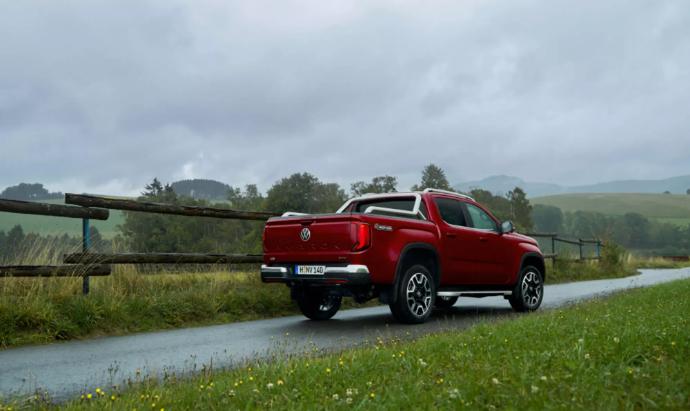
The new Amarok is finally here, making a clear statement for its drivers: All roads are the destination.
Fundamentally reimagined, the new Amarok defines the premium segment at Volkswagen Commercial Vehicles with its modern technology and redesigned styling.
No matter where or when, the new Amarok, equipped with its various modern driving assistance systems offers more support than any of its predecessors.
Its premium character is underlined by features such as ambient lighting1 and a top-end sound system from Harman Kardon2. As an outdoor companion, it stands out with improved off-road capability and optional V6 power. For those looking for a robust and reliable commercial vehicle, its broad variety of new features, such as the 3.5T towing capability for all automatic transmissions and other convenient details, are ready for any challenges. Whatever the requirements may be: The new Amarok meets them effortlessly. This is Design
The new Amarok is defined by powerful contours in a completely revised Volkswagen Commercial Vehicles design. A slightly wider wheelbase provides a higher slope angle for improved off-road capability, and there is also a more rugged emphasis in the stance than in the predecessor.
The new Amarok comes with a cargo bed-load of remarkable highlights, such as modern "IQ.Light" LED matrix headlights1, optional wheels up to 21" in size2, completely new exterior styling packages with newly designed styling bars and steps.
The radiator grille, which - depending on the version - merges into a horizontal division of the front section or into an X-shaped design3, in the top trim levels, is another eye catcher.
Speaking of highlights, the loading area between the wheel arches offers enough space for a Euro pallet to be loaded crosswise and lashed in place thanks to the sturdy eyelets.




Another new feature is the roof load capacity of 350kg. Never before has it been possible to pitch a tent on a nicer surface.
Design features of the new Amarok:
• new radiator grille
• "IQ.Light" LED matrix headlights1, and LED taillights4,
• wheels 16"/17"/18"/20"/ 21"2, all-terrain tires up to 18"
• embossed Amarok lettering on the tailgate
The new Amarok Style
On-road or off-road, the new Amarok Style looks as good as it drives. The Amarok Style can take on any road. It doesn’t matter whether it’s being splattered with mud or winding its way through the urban jungle - the Amarok Style is at home wherever it goes.
Equipment features of the Amarok Style:
• 18-inch alloy wheels
• Rear bumper with chrome applications
• 10-way driver and passenger front seats
• 12-inch infotainment incl. touch display
The new Amarok Life
The new Amarok Life is a true off-road thoroughbred, and breezes through any terrain. Who said going off-road can’t be comfortable? The Amarok Life’s generous array of features makes it perfect for tackling even the biggest adventures.
Equipment features of the Amarok Life:
• 17-inch alloy wheels
• Colour-keyed front bumper, exterior mirrors and handles
• 8-way seats
• Heated exterior mirrors with surround lighting
This is Off-road
What makes the new Amarok a real thoroughbred off-roader? It offers the latest technology and more ride comfort than its predecessor, such as state-ofthe-art airbags and assistance systems.
With a range of body, chassis, engine or transmission variants, modified dimensions and the significantly greater fording depth, everything is designed for off-road capability.
The new Amarok is 5,350mm long - 96mm longer than its predecessor. A wheelbase of 3,270mm corresponds to an increase of 173mm - which means there is more space in the crew cab. Since the wheelbase grows more than its overall length, the body overhangs are reduced. This adds to an increased slope angle and a better off-road capability.
The new Amarok has the right answer for almost every driving situation. It also has the right transmission for almost every drive preference: from rear-wheel drive to selectable and permanent all-wheel drive. Three different diesels with four to six cylinders and 2.0 to 3.0 litres of displacement ensure the right strength development.
The preconfigured driving modes are new and come in many variations to support drivers in special off-road situations in several stages. More than 25 assistance systems, over 20 of which are completely new on-board the Amarok, provide additional driving comfort on request.
Thanks to an 800mm fording depth – 300mm more than its predecessor - off-road fans can now immerse themselves even more fully in the world of off-road capability.


ARB, the preeminent Australian 4x4 accessories manufacturer, proudly introduces an expansive range of outdoor adventure accessories customised for the Isuzu D-Max.
Catering to enthusiasts with a penchant for exploration, ARB's comprehensive line-up covers vehicle camping, off-roading, green laning, and various other off-road adventures.
Elevating the camping experience, ARB presents an array of rooftop tents, including the rugged ARB Esperance Roof Top Tent with Ladder (Hard Shell), the versatile ARB Flinders Roof Top Tent, and the spacious ARB Simpson III Roof Top Tent with Ladder & Annex. For ground-level camping enthusiasts, the ARB Swag Skydome Tent provides a cosy and convenient option. These tents seamlessly integrate with the popular ARB Ascent Hardtop Gullwing Canopy, now an official
accessory for the Isuzu D-Max.
ARB's commitment to enhancing the camping lifestyle extends to the Slide Kitchen, a fully fitted kitchen drawer set complete with a gas hob, sink, and additional drawers. For those seeking extended adventures, the ARB Zero Fridge Freezer ensures perishables stay fresh. To maximise the D-Max’s space, ARB introduces the Awning Room Deluxe, a versatile extension completed with a floor, transforming the vehicle into a comfortable and spacious retreat.
Venturing into remote locations demands reliable support. ARB's off-roading and green laning accessories include the indispensable Tred Pro Recovery Boards for overcoming challenging terrains, the Baserack & Cab Mount Kit for carrying extra equipment, and the comprehensive ARB Recovery Kit Weekender. This kit, featuring a snatch strap rated to 4.75 tonnes, shackles,



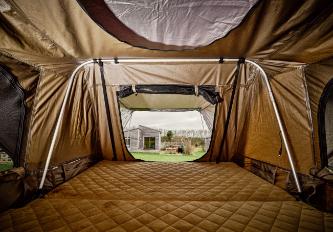


and leather gloves, is complemented by ARB Recovery Points, ensuring secure front-end recovery.
Isuzu and ARB joined forces in the middle of 2023, resulting in remarkable success. The collaboration generated sales totalling £124,000, with the ARB Ascent Canopy emerging as the top seller. This canopy, known for its excellent build quality and versatility, has captured the hearts of D-Max owners seeking durability and functionality.
Steve Page, Accessory Sales & Marketing Co-Ordinator at Isuzu UK, commented, "Our partnership with ARB has exceeded expectations. The accessories provided have proven to be of the highest quality, and Isuzu D-Max
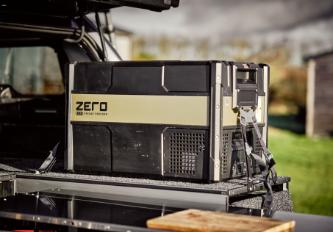

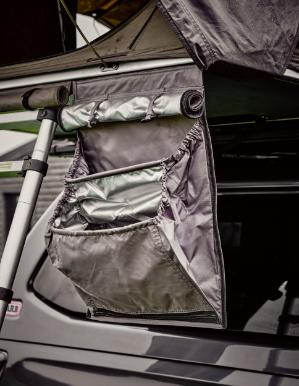

owners have embraced the versatility they bring to their outdoor adventures."
Established in 1975 in Australia, ARB has grown to become the largest manufacturer and distributor of 4x4 accessories. With a presence in over 80 countries, ARB's commitment to quality, reliability, and practicality remains steadfast.
As we approach Australia Day on January 26th, ARB invites outdoor enthusiasts to explore their range of accessories, celebrating the spirit of adventure and the rugged durability they offer. For more information, please visit www. isuzu.co.uk/accessories or www.arb4x4uk.co.uk.



Isuzu Motors Limited has set its sights on the future of automotive innovation with the unveiling of its first Battery Electric Vehicle (BEV), the Isuzu D-Max BEV. The prototype of this uncompromising vehicle will be showcased to the public at the 45th Bangkok International Motor Show from the 27th of March to the 7th of April 2024.
The Isuzu D-Max BEV represents a substantial step forward in the evolution of pick-up trucks, combining the rugged performance and versatility expected of an Isuzu vehicle with the environmental benefits of electric propulsion. Developed to meet a wide range of commercial and passenger vehicle needs, the D-Max BEV boasts a 1-tonne payload, 3.5-tonne towing
capacity, and a full-time 4WD system with newly developed e-Axles in the front and rear, offering exceptional performance on rough terrain while minimising noise and vibration.
With a lithium-ion battery capacity of 66.9kWh and a maximum output of 130kW, the electric D-Max delivers impressive power and instant torque, with a linear acceleration feel characteristic of BEVs. Moreover, its maximum speed of over 130km/h (81mph) makes it suitable for a variety of applications, from urban commuting to off-road adventures.
Isuzu is committed to promoting sustainability and reducing carbon emissions, with the D-Max BEV representing a significant milestone in its journey towards a carbon-neutral world. The company

plans to launch the D-Max BEV in select mainland European markets in 2025, with further expansion to the UK, Australia, Thailand, and other countries based on market demand and the development of Electric Vehicle (EV) charging infrastructure.
Alan Able, Managing Director of Isuzu UK, expressed his excitement about the launch of the D-Max BEV, stating, "The Isuzu D-Max BEV represents a new era for pick-up trucks, combining the legendary toughness of the D-Max with electric technology. We are proud to work with a manufacturer committed to creating a carbonneutral future and announce this innovative vehicle to the UK market, providing our customers with an
environmentally friendly option without compromising on performance or reliability."
Isuzu Motors International Operations Thailand (IMIT) spokesperson added, “The Isuzu D-Max BEV represents a new chapter in our commitment to sustainable mobility. With its innovative electric powertrain and rugged design, it demonstrates our dedication to providing customers with reliable and environmentally friendly transportation solutions.”
The Isuzu D-Max BEV will be on display at the Bangkok International Motor Show, offering visitors a glimpse into the future of electric mobility.



DON’T MISS OUT. FIND OUT MORE AT
CULVERWELL CARS Robertsbridge, East Sussex
CULVERWELL-ISUZU.CO.UK 01580 880 567
DUCKWORTH ISUZU London Road, Boston
DUCKWORTH.CO.UK/ISUZU 01205 725 700
JEFFRIES OF BACTON Stowmarket, Suffolk
JEFFRIESOFBACTON-ISUZU.CO.UK 01449 781 131
DRIVEN TO DO
STARTIN TRACTORS Ashby Road, Twycross
STARTINTRACTORS-ISUZU.CO.UK 01827 880 088
YORK VAN CENTRE Station Lane, York
YORKVANCENTRE-ISUZU.CO.UK 01904 470 170